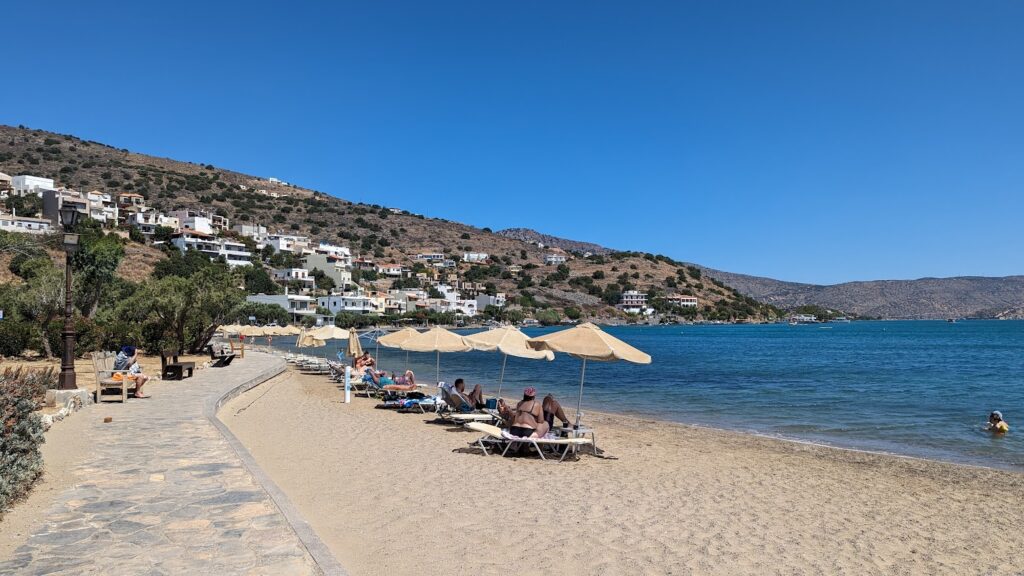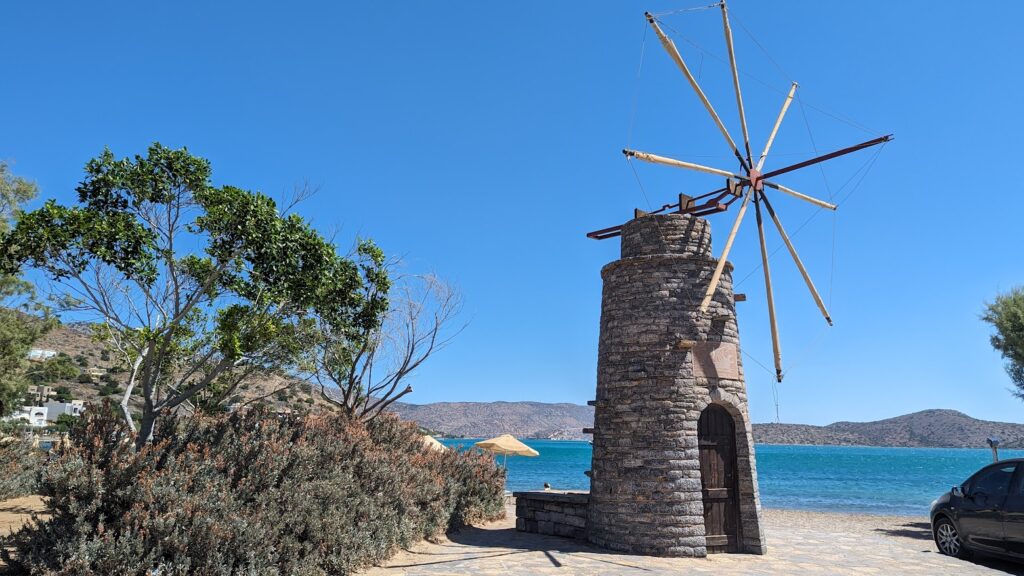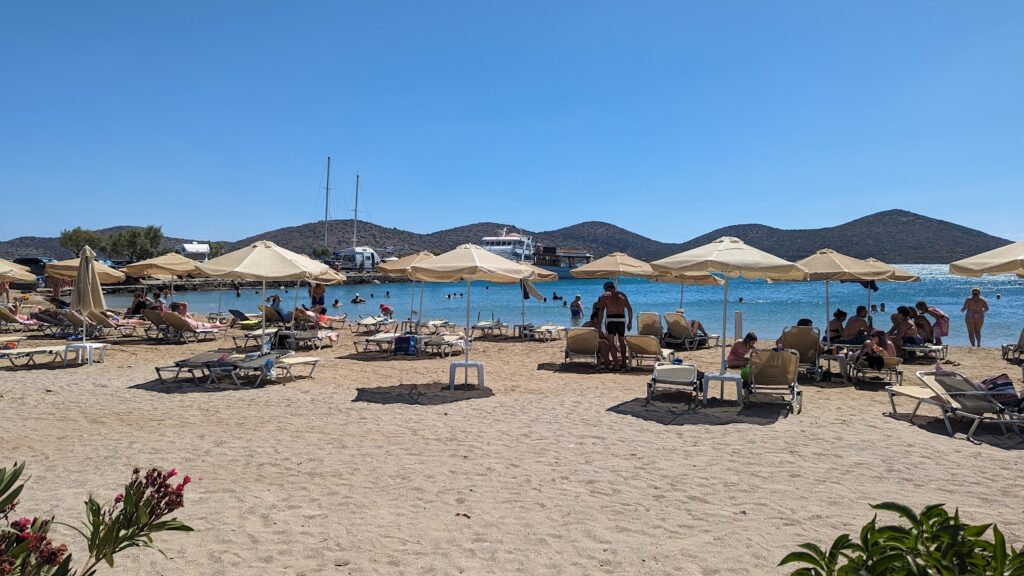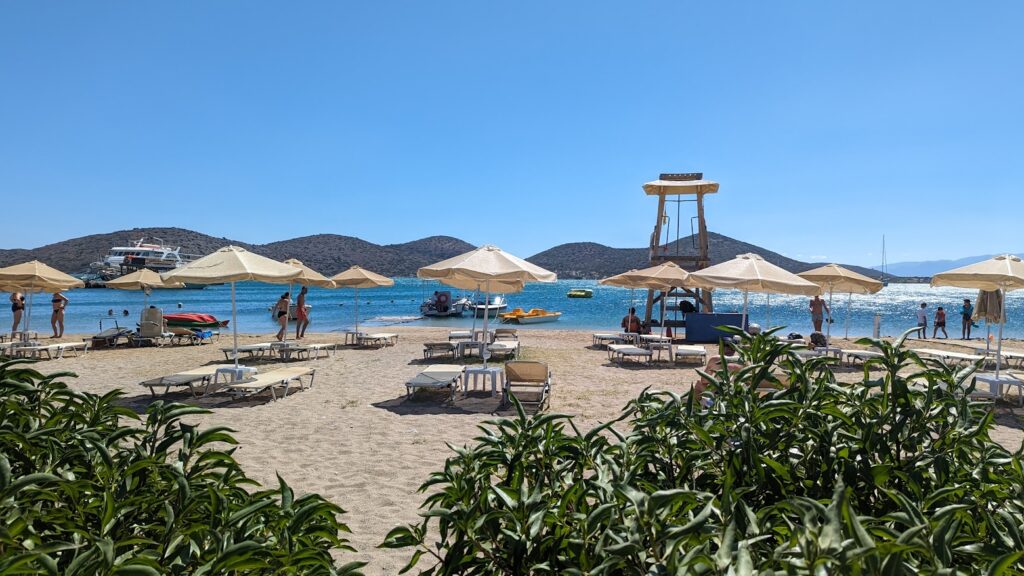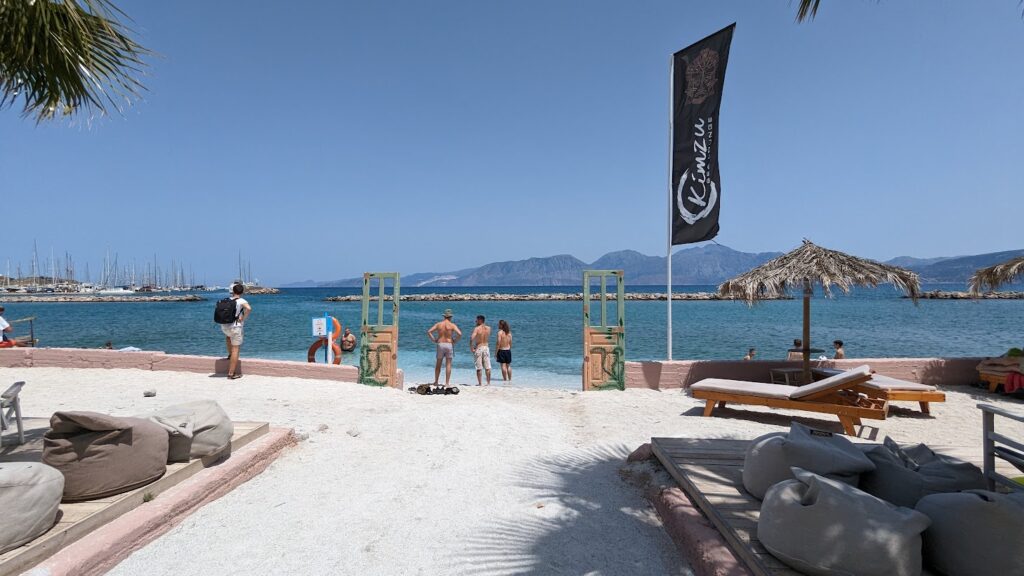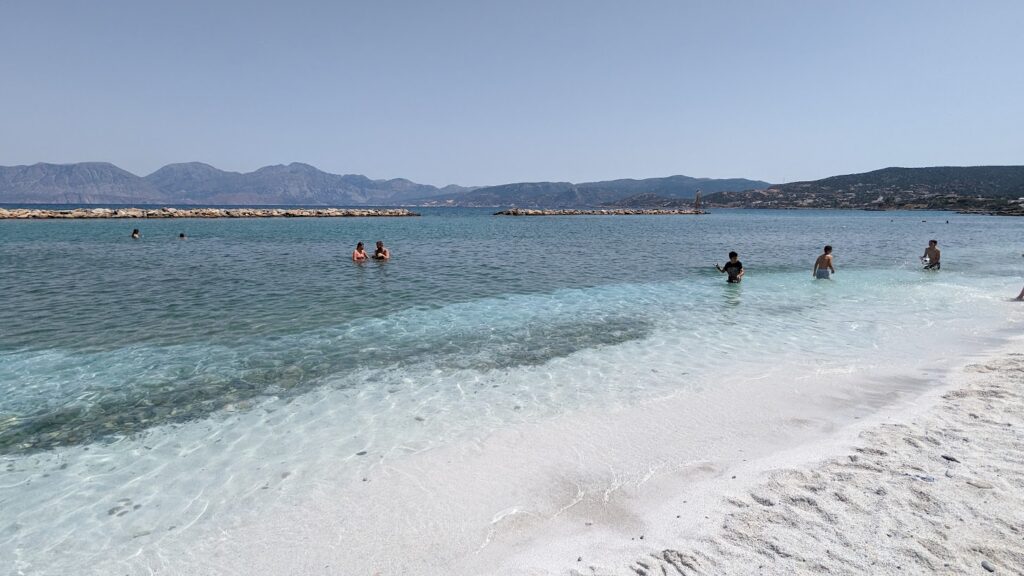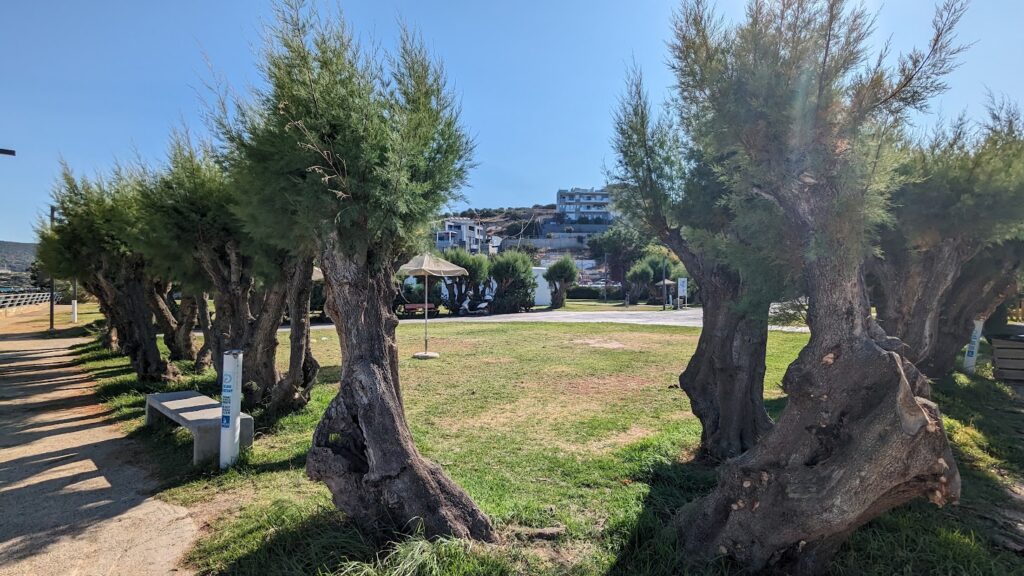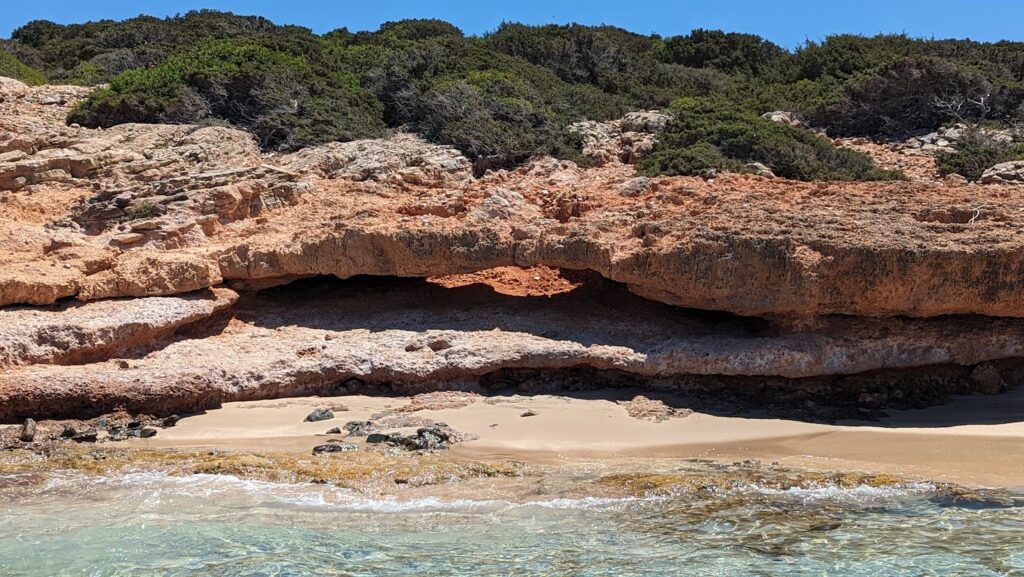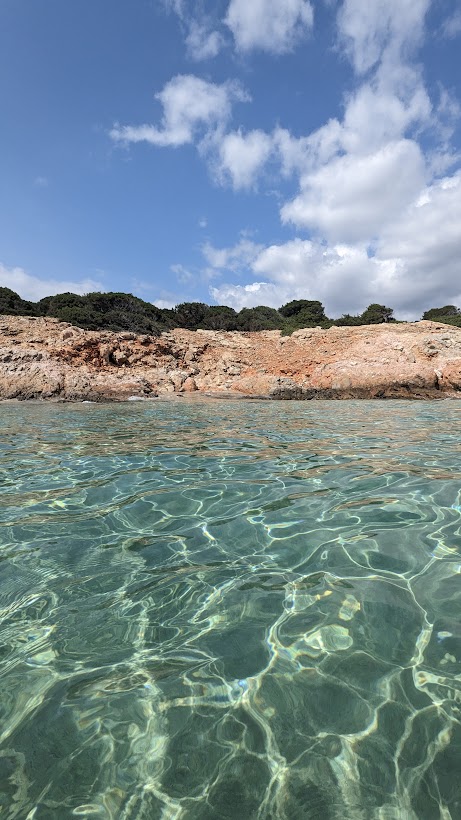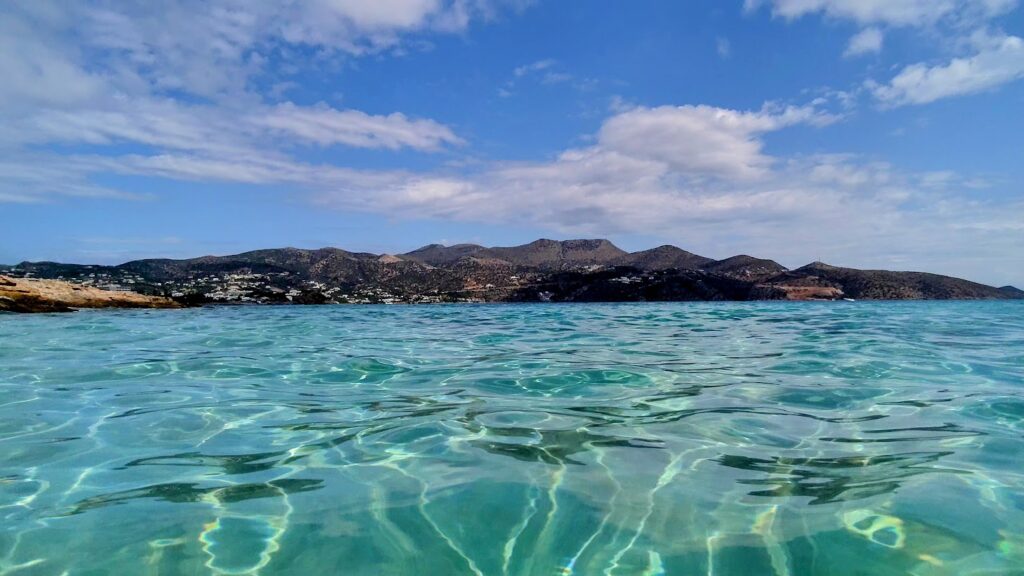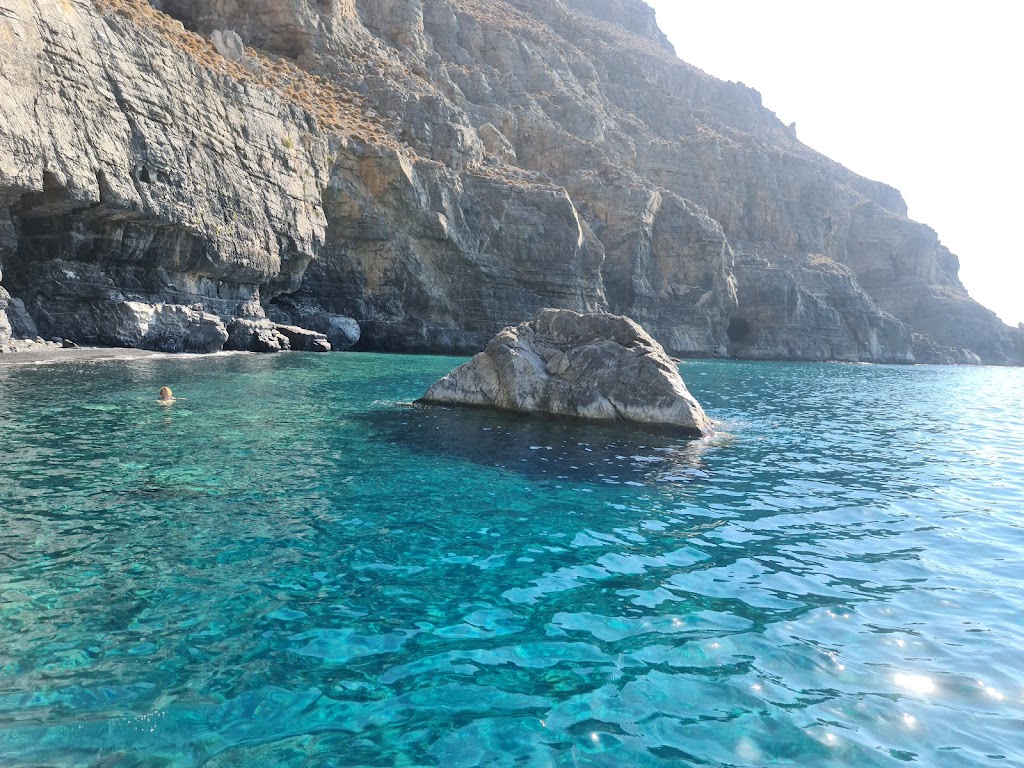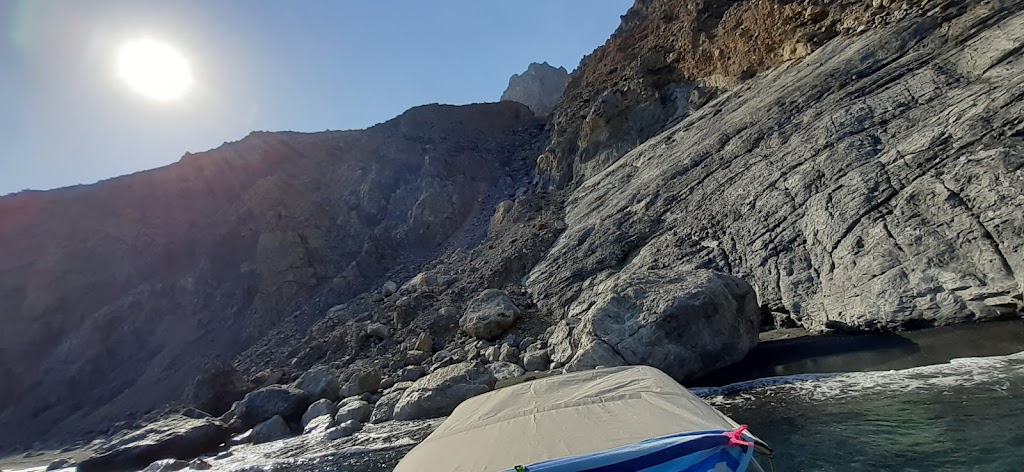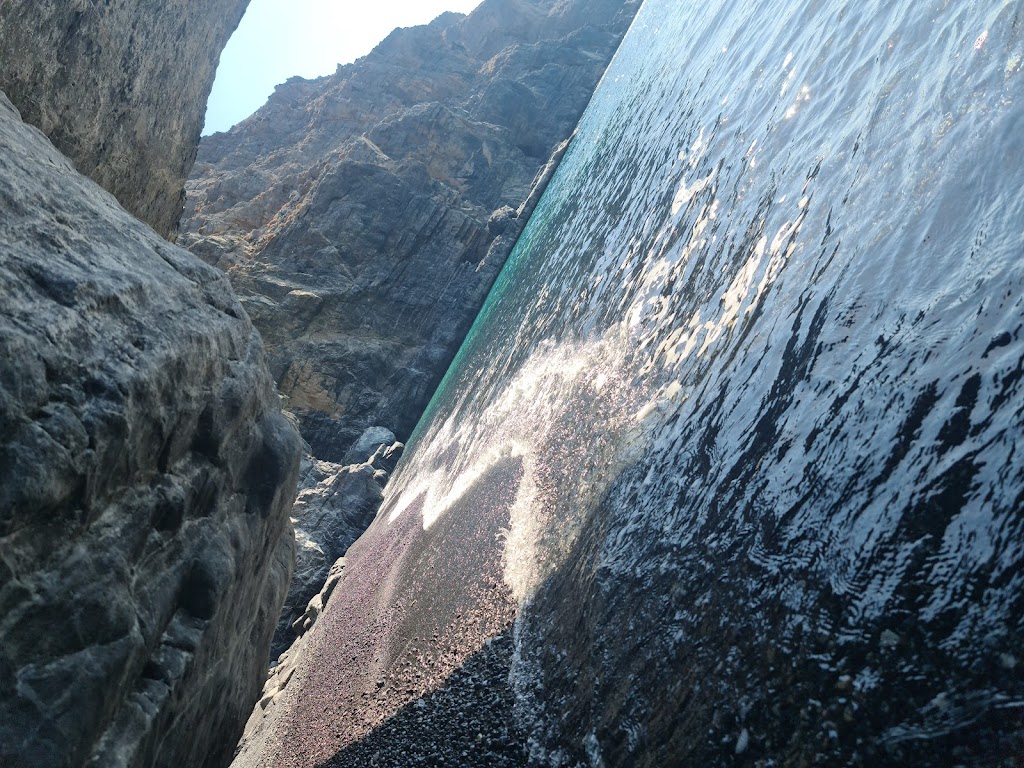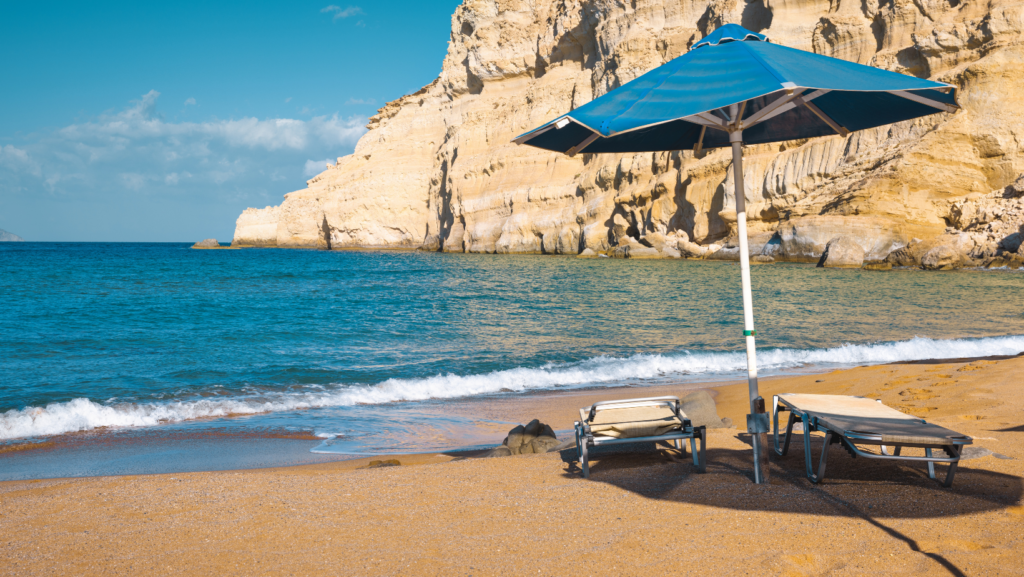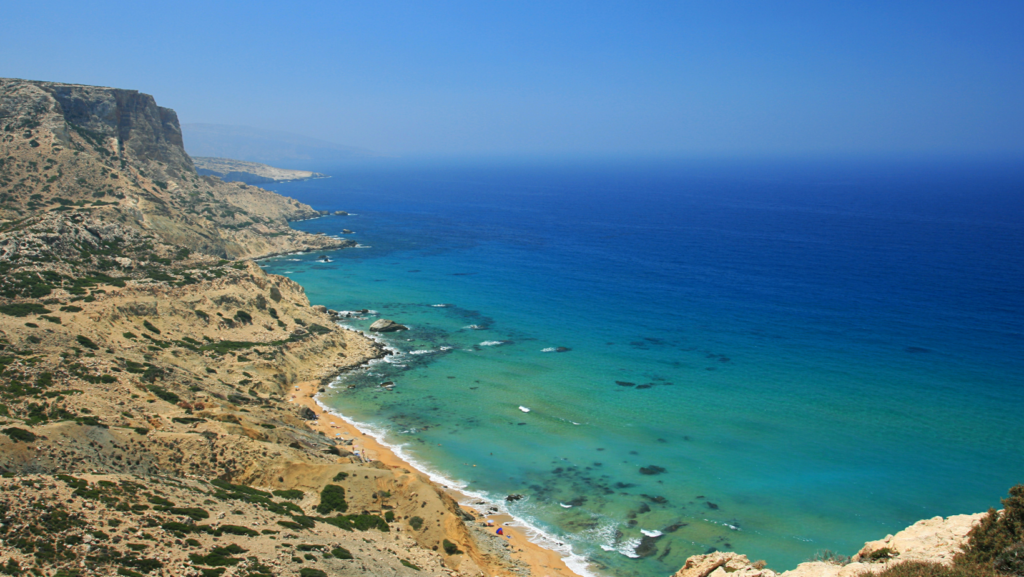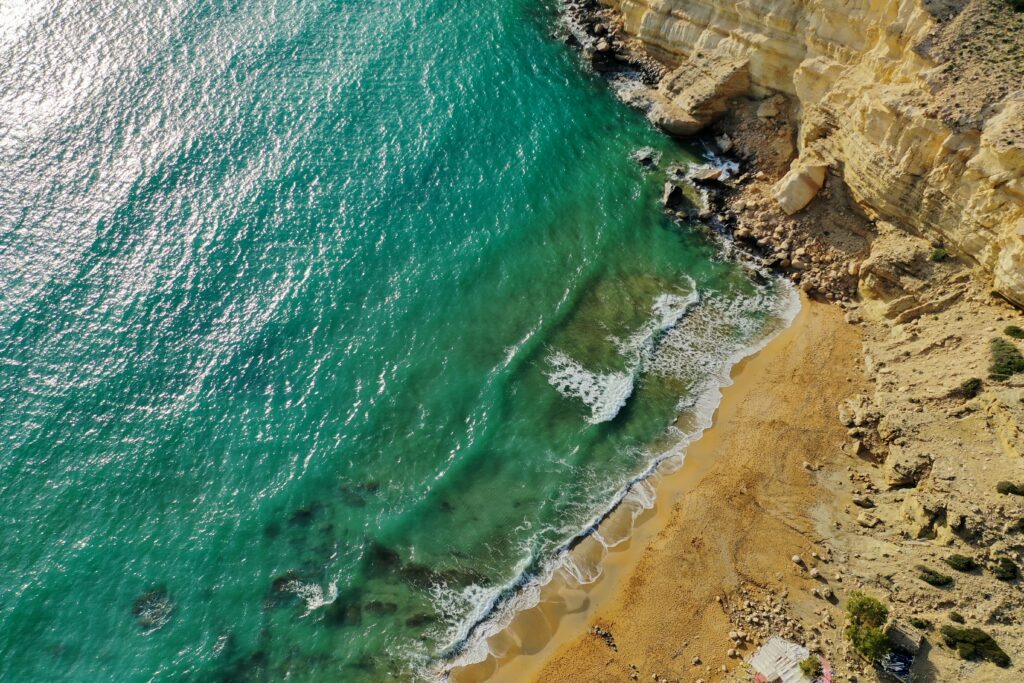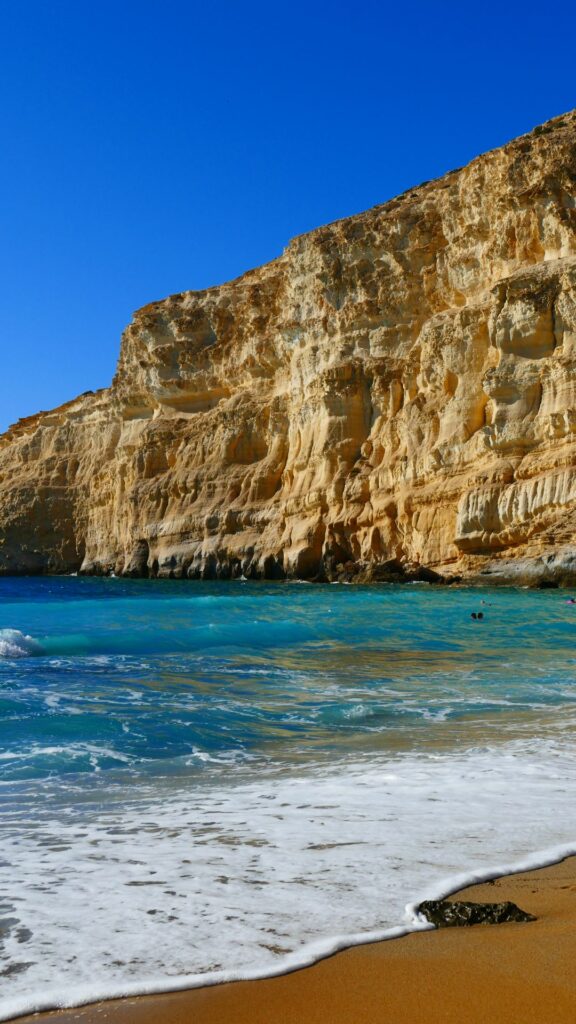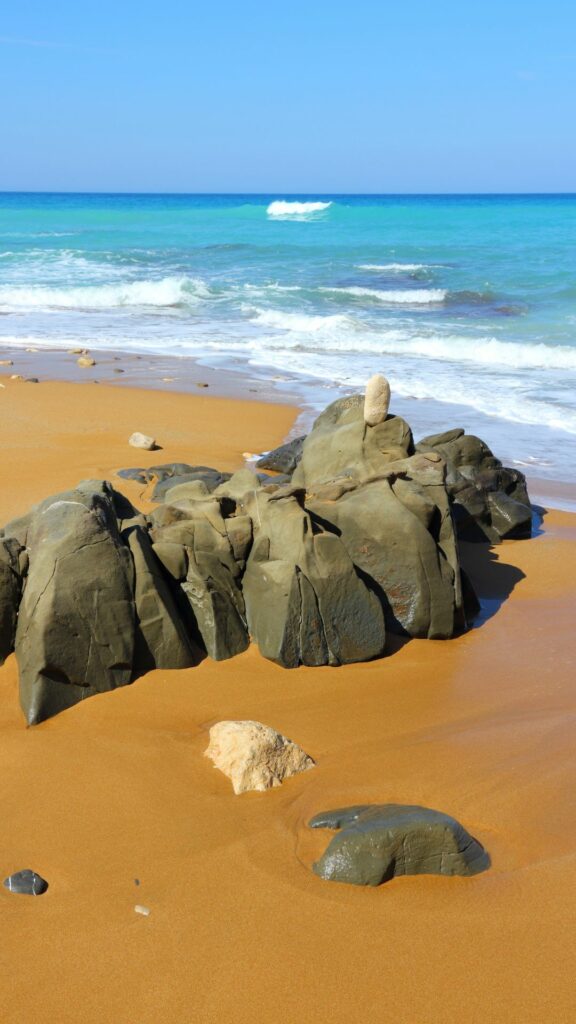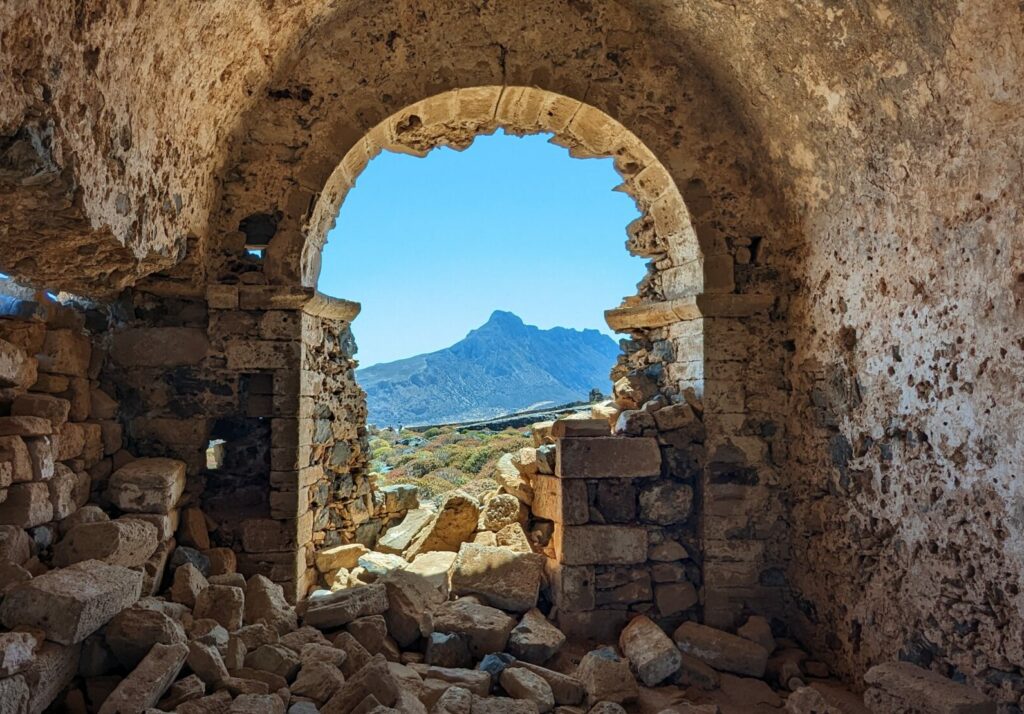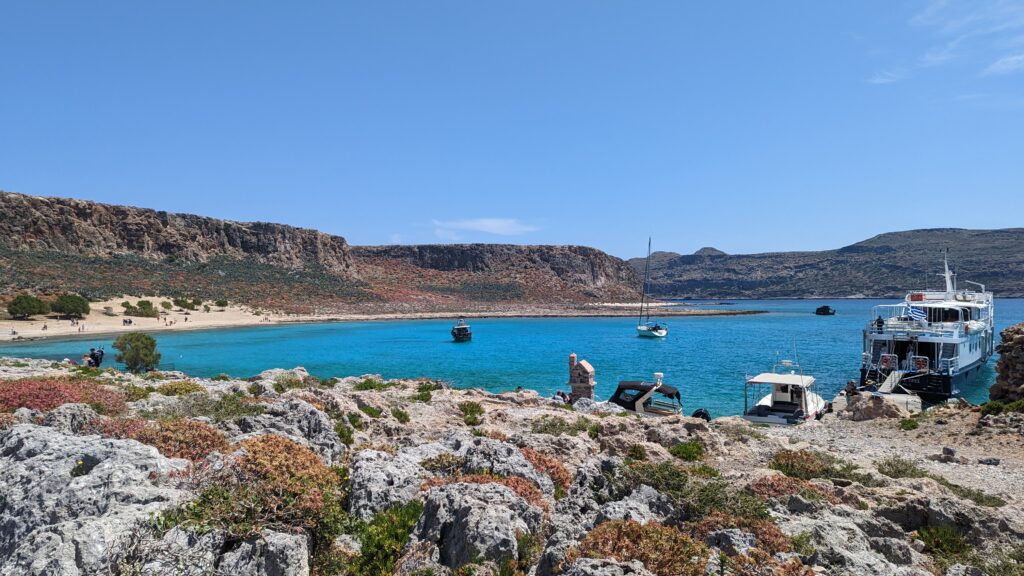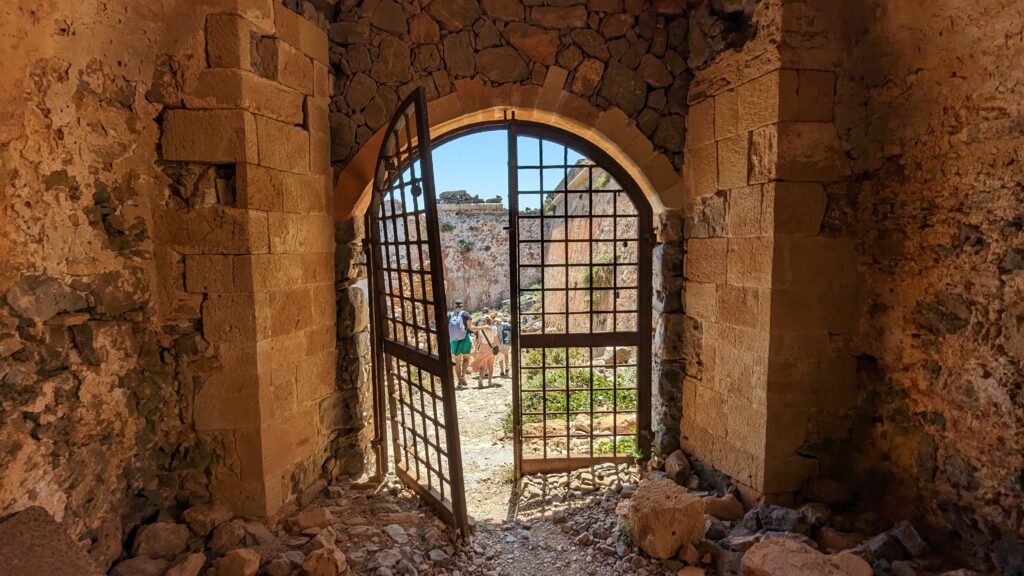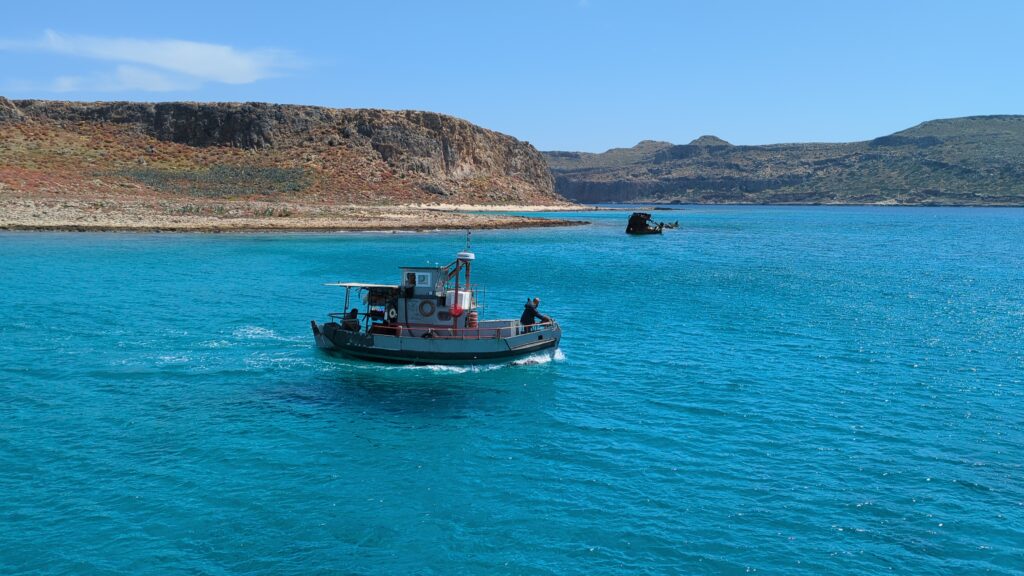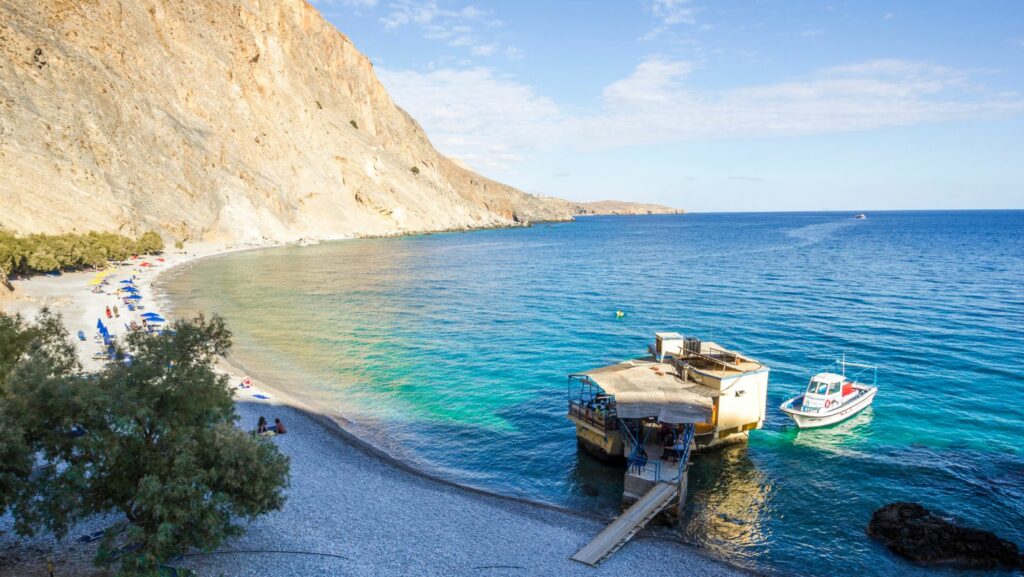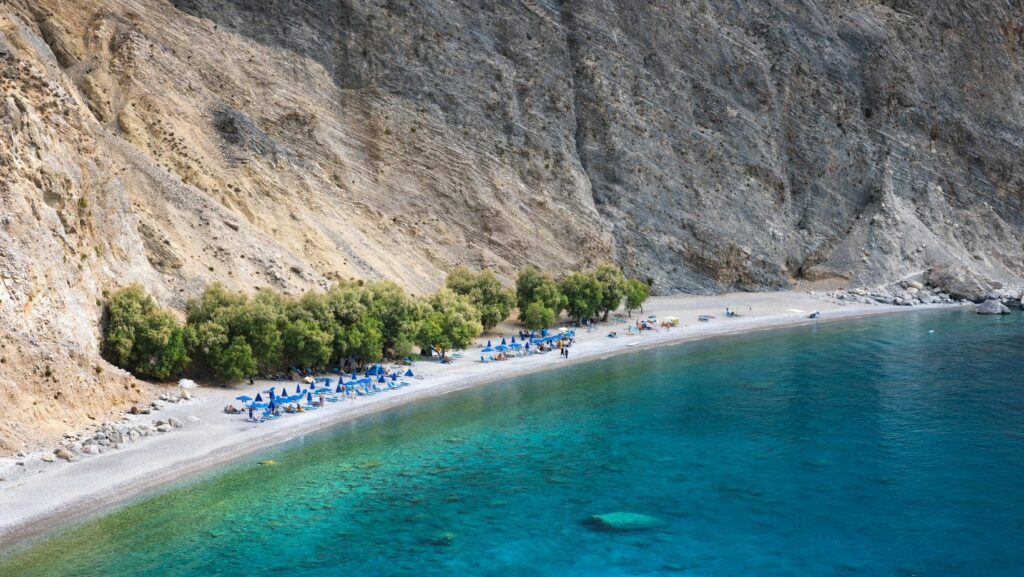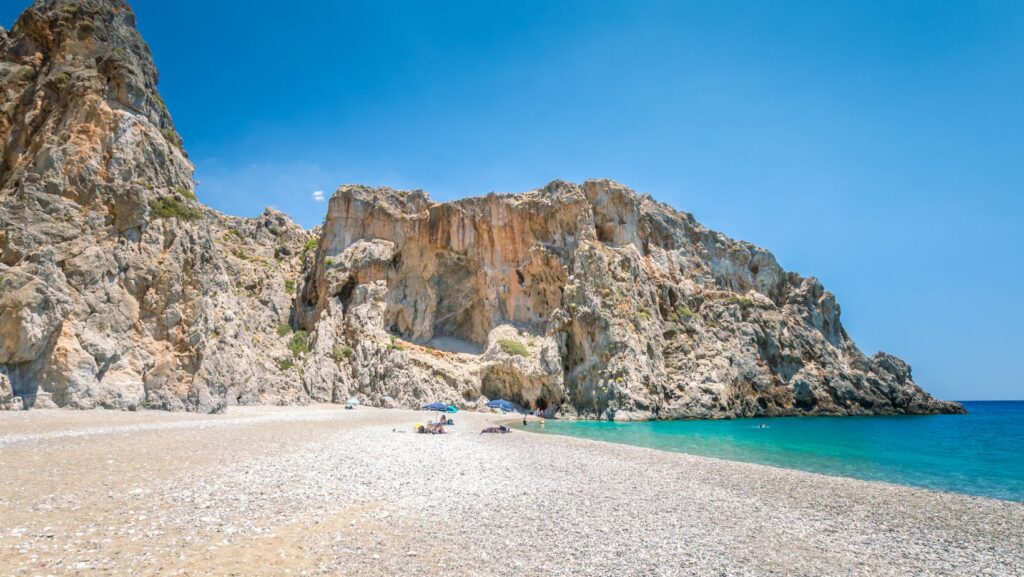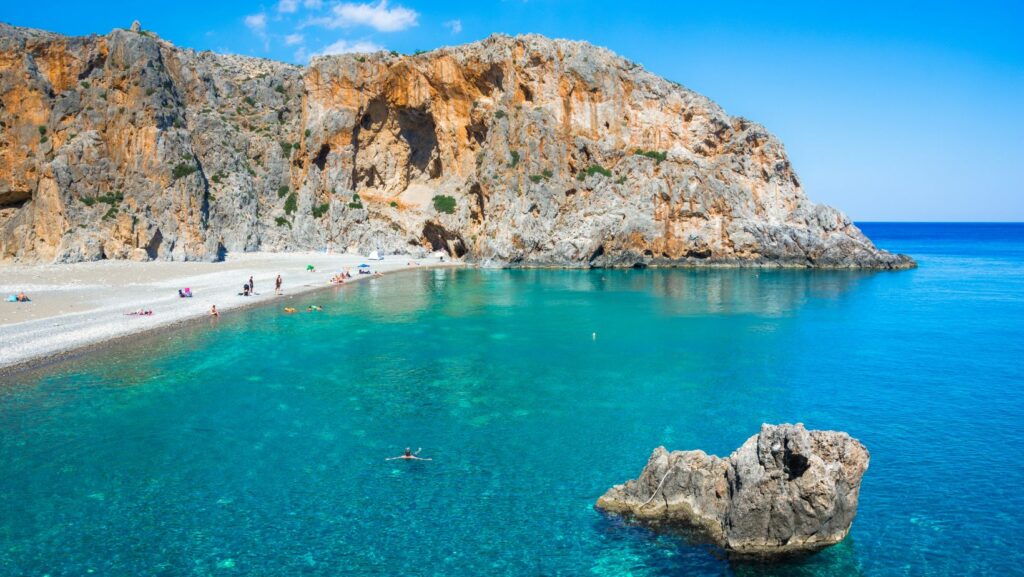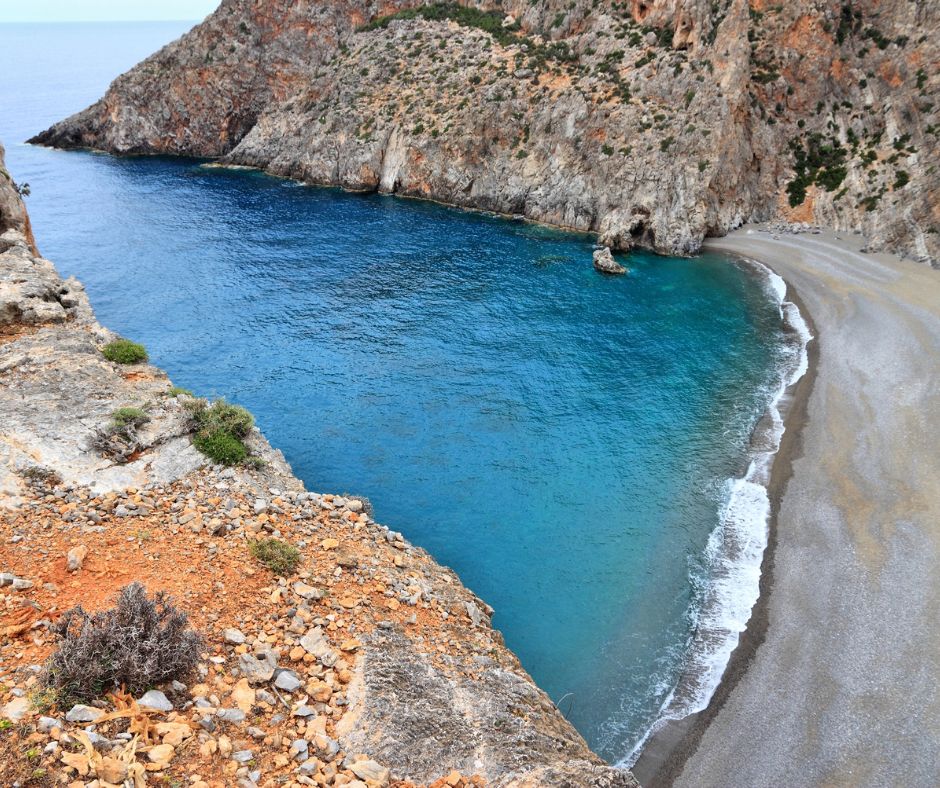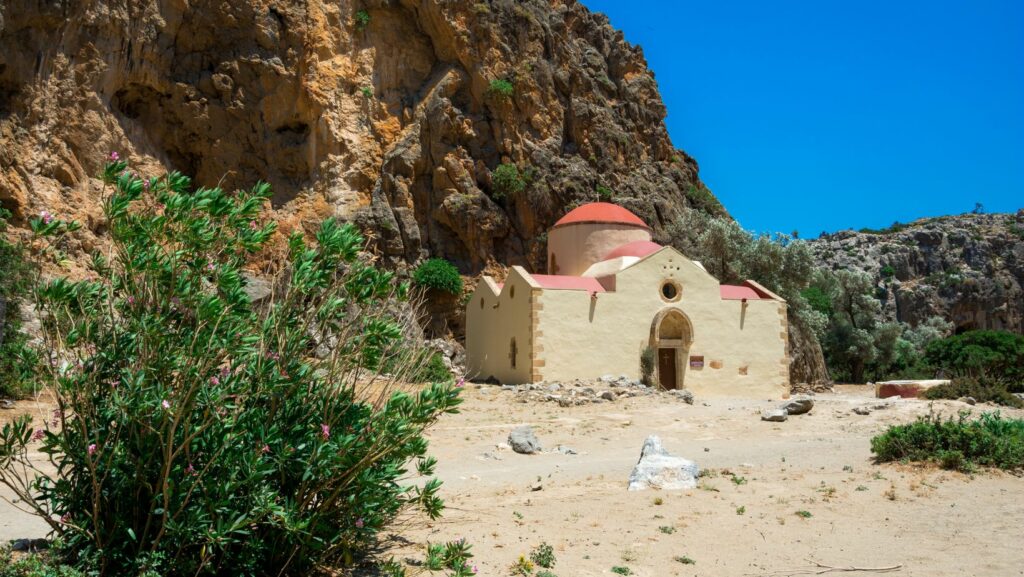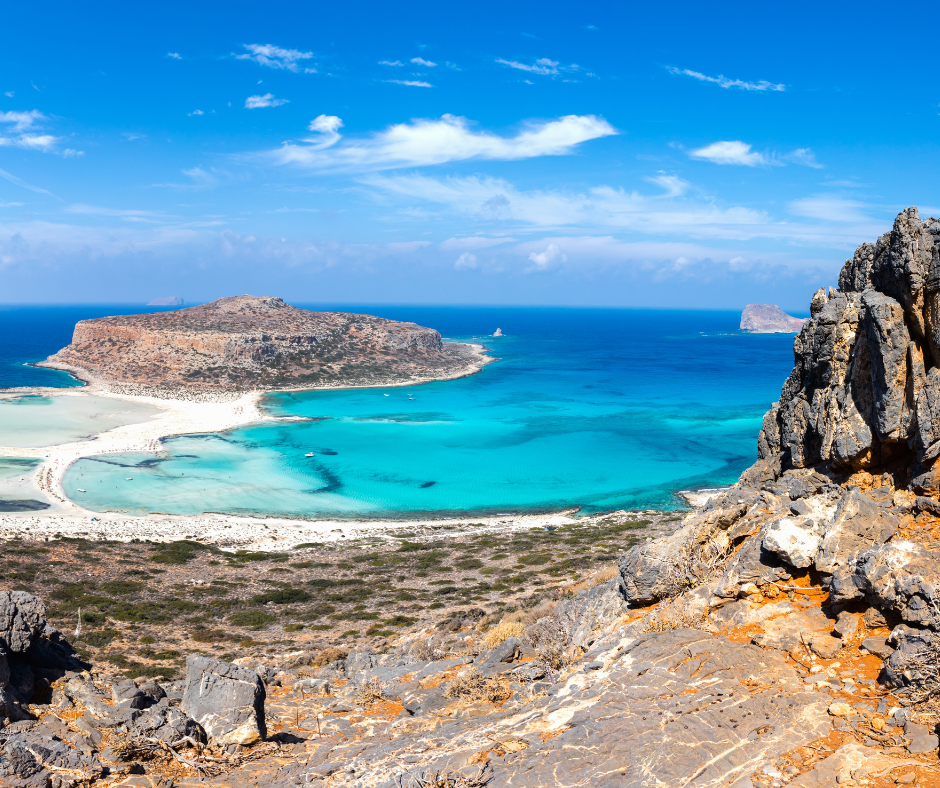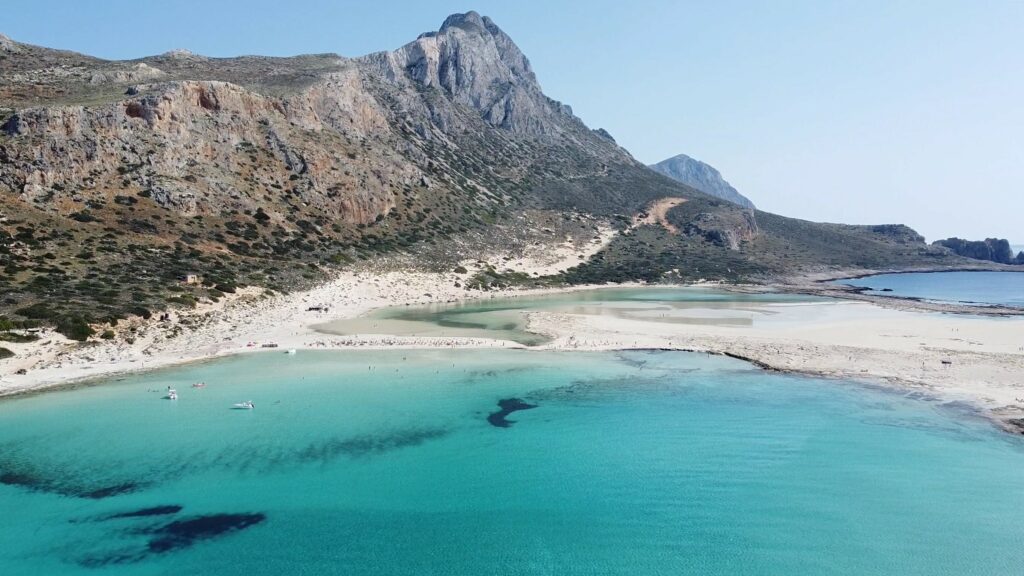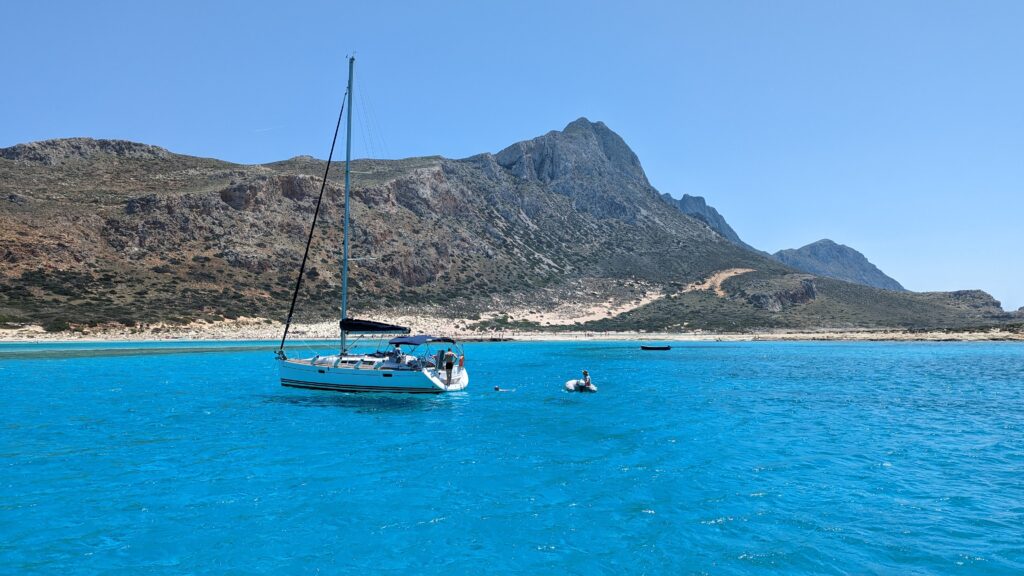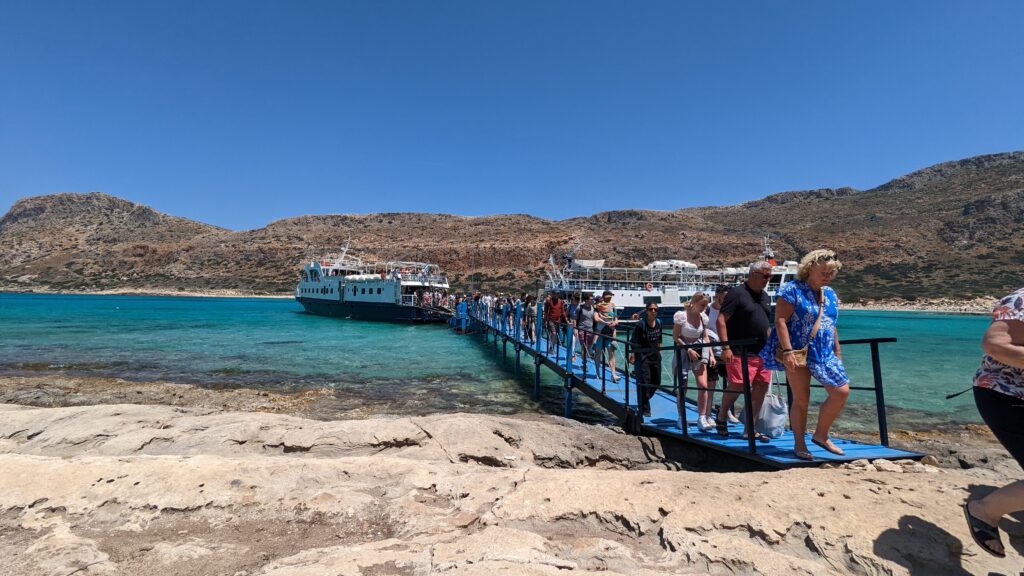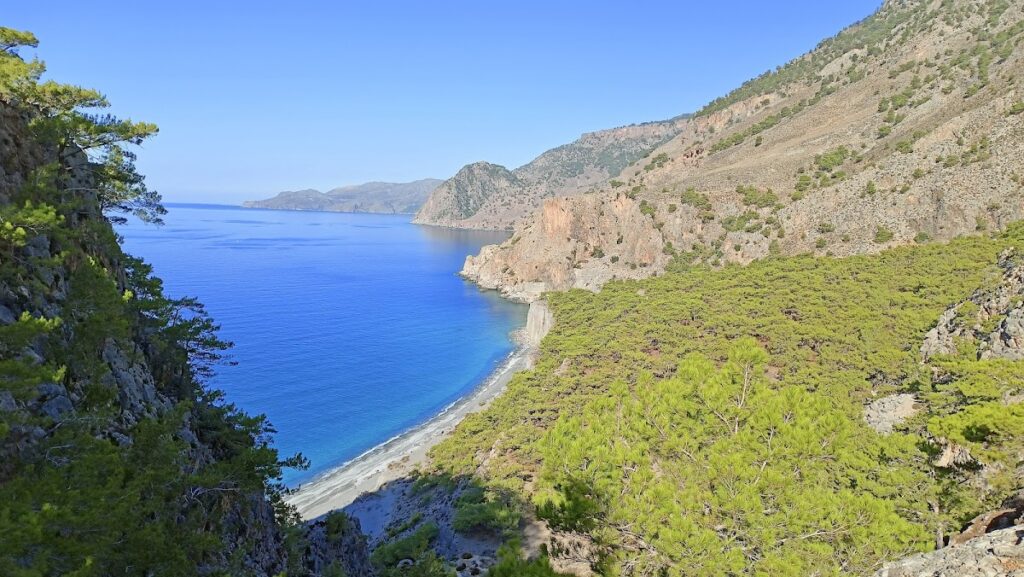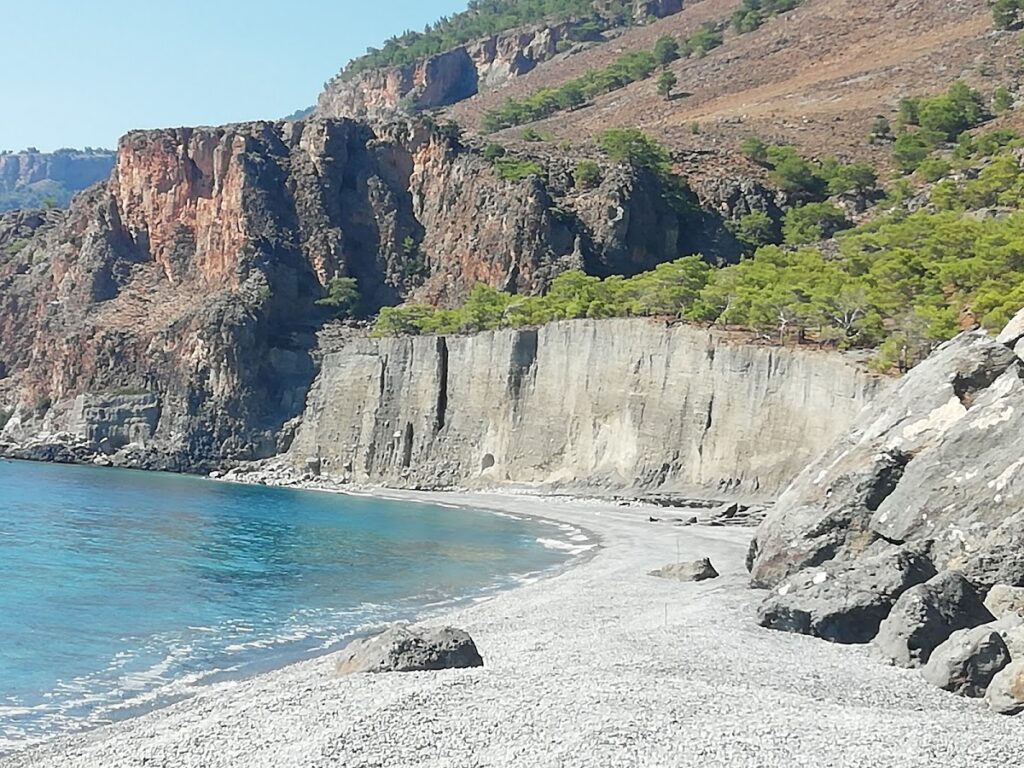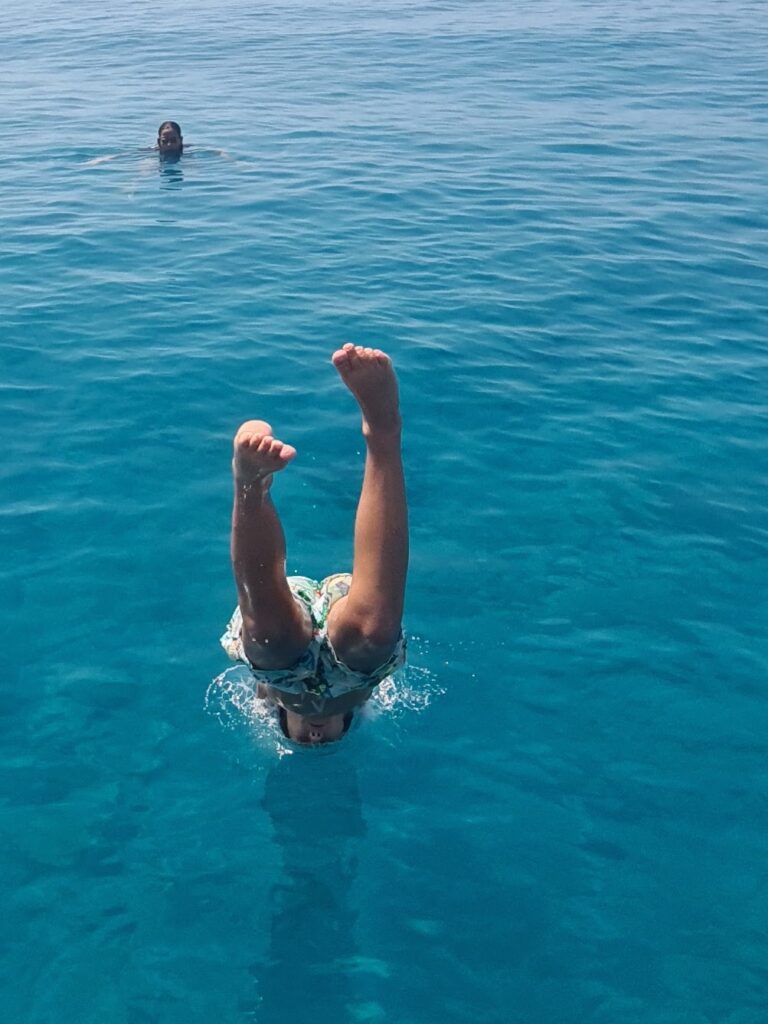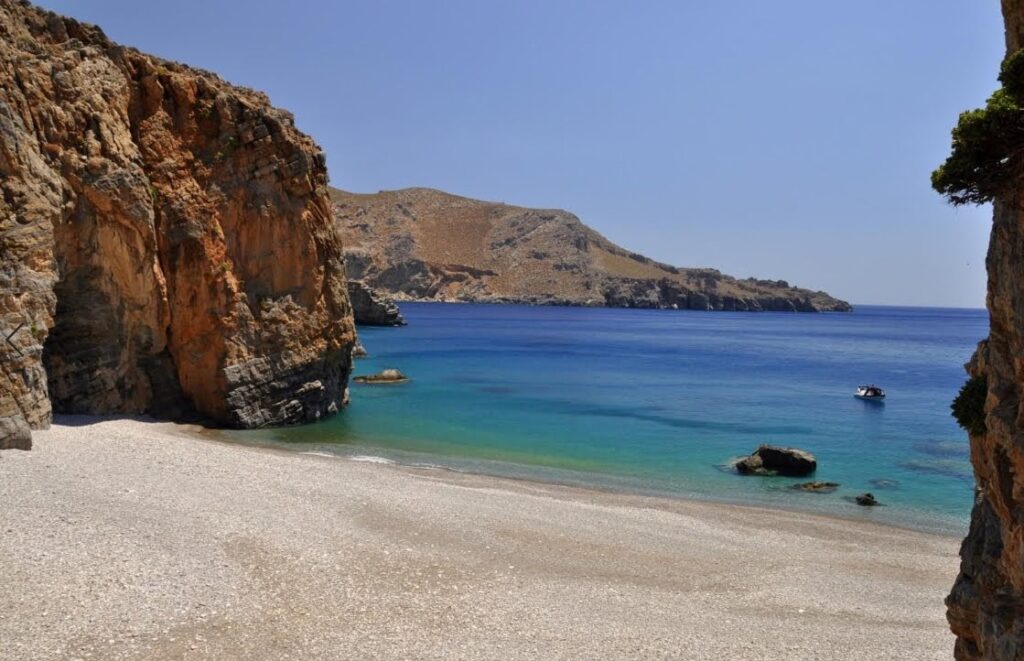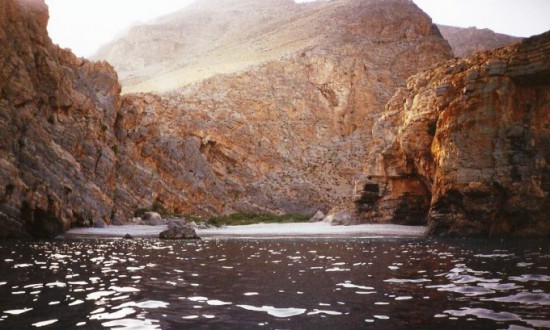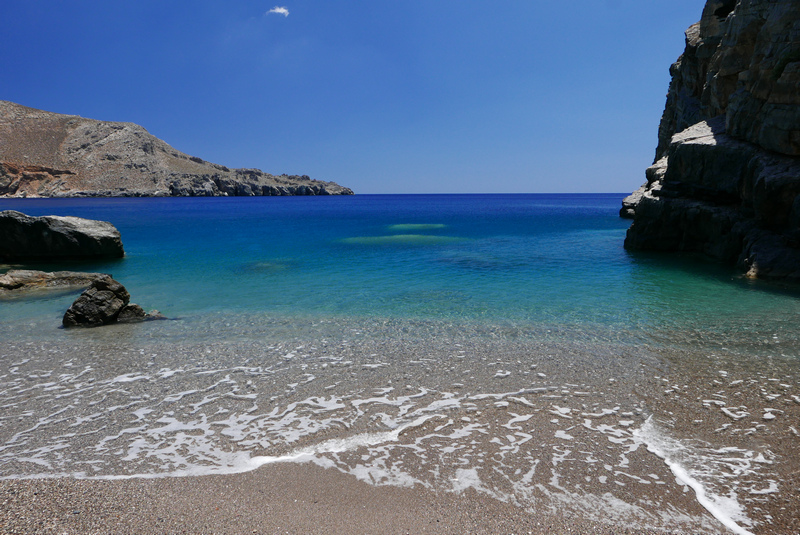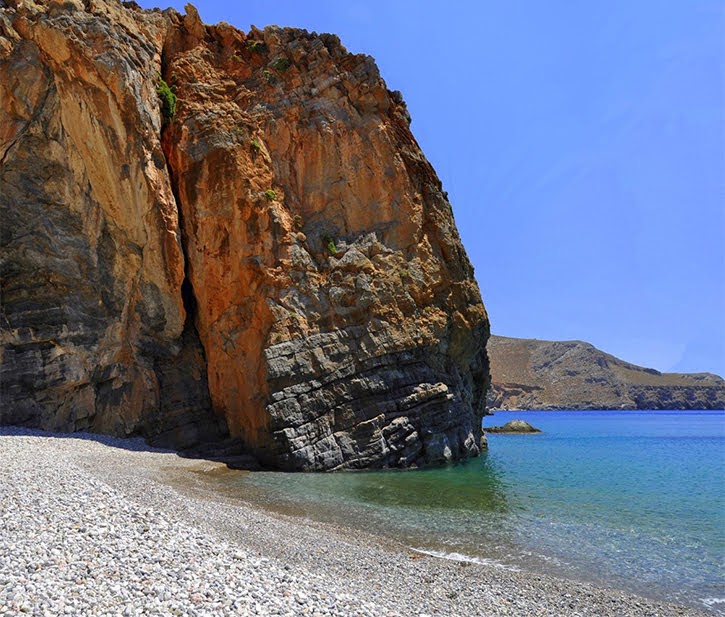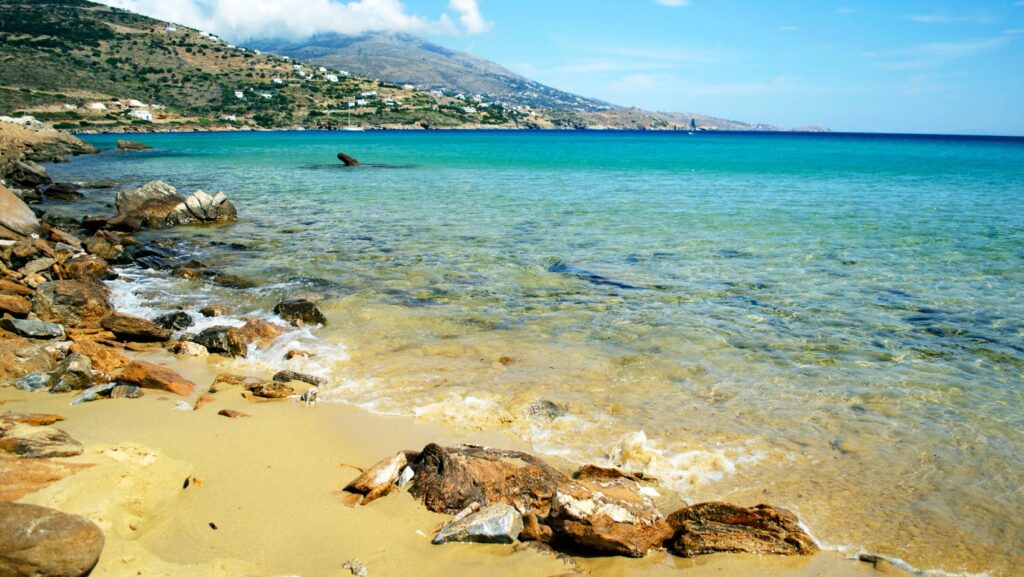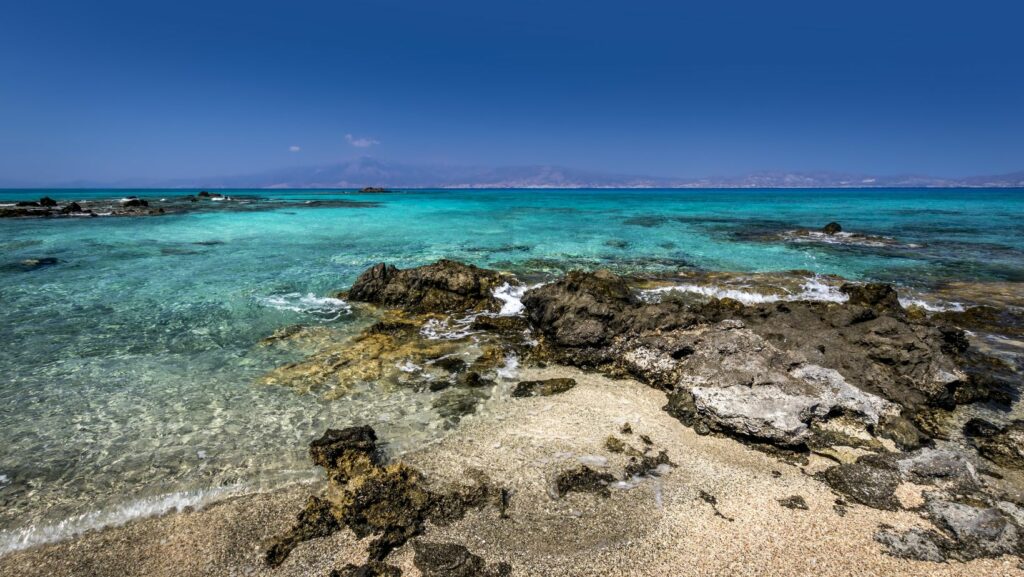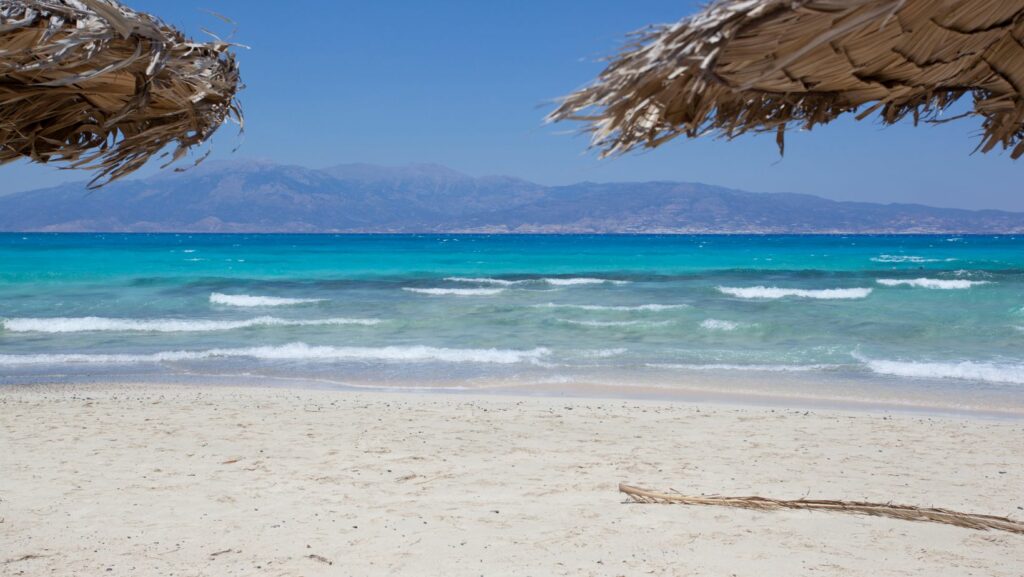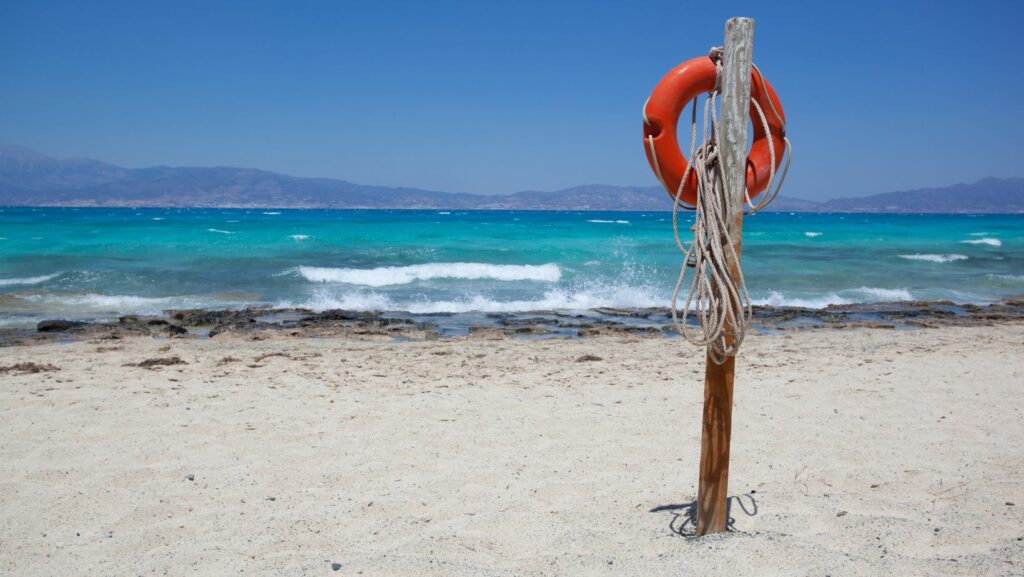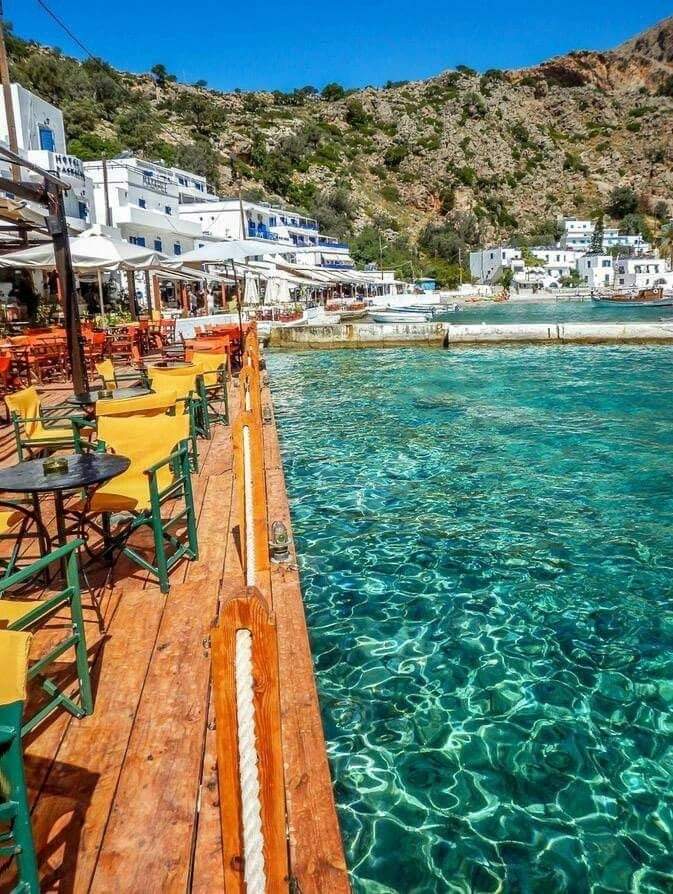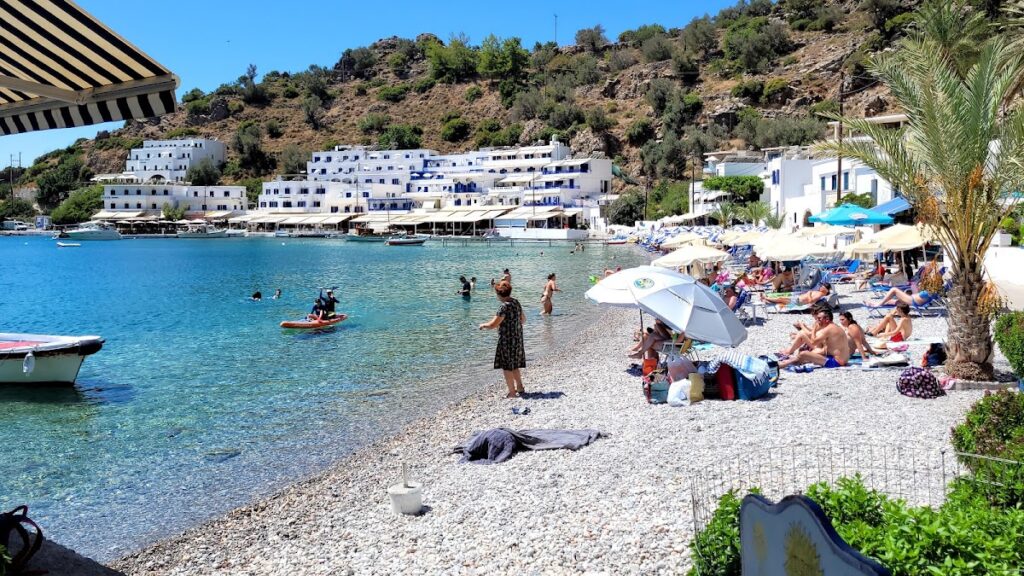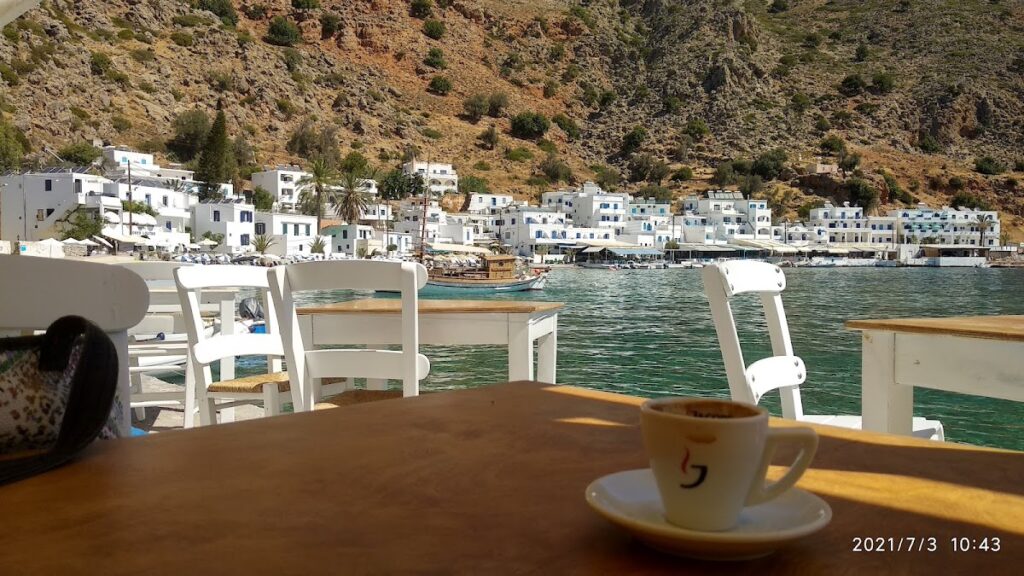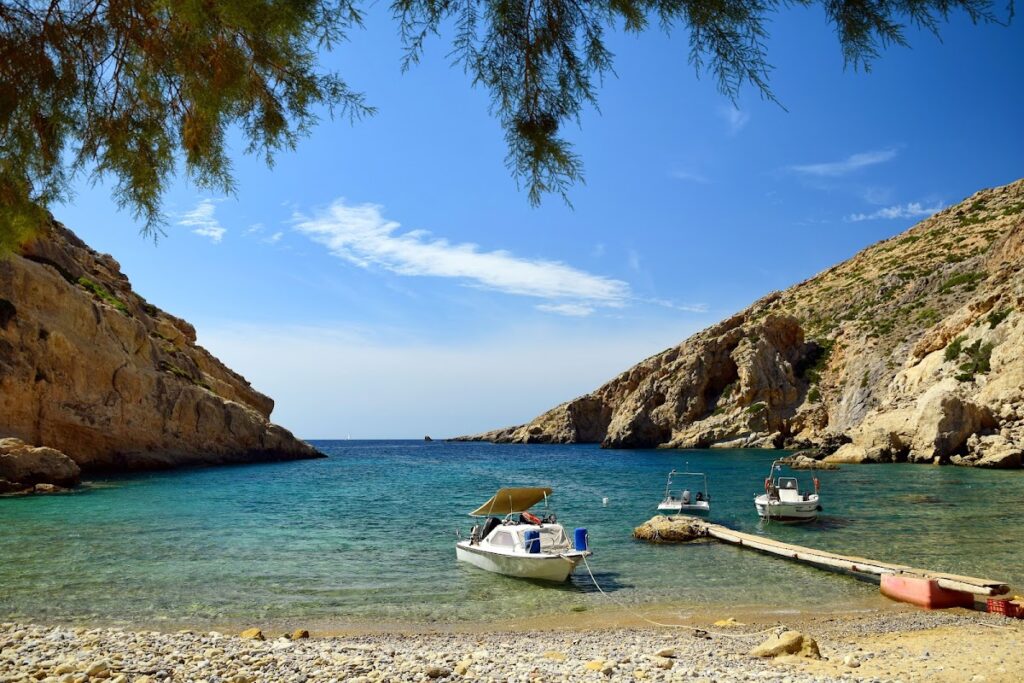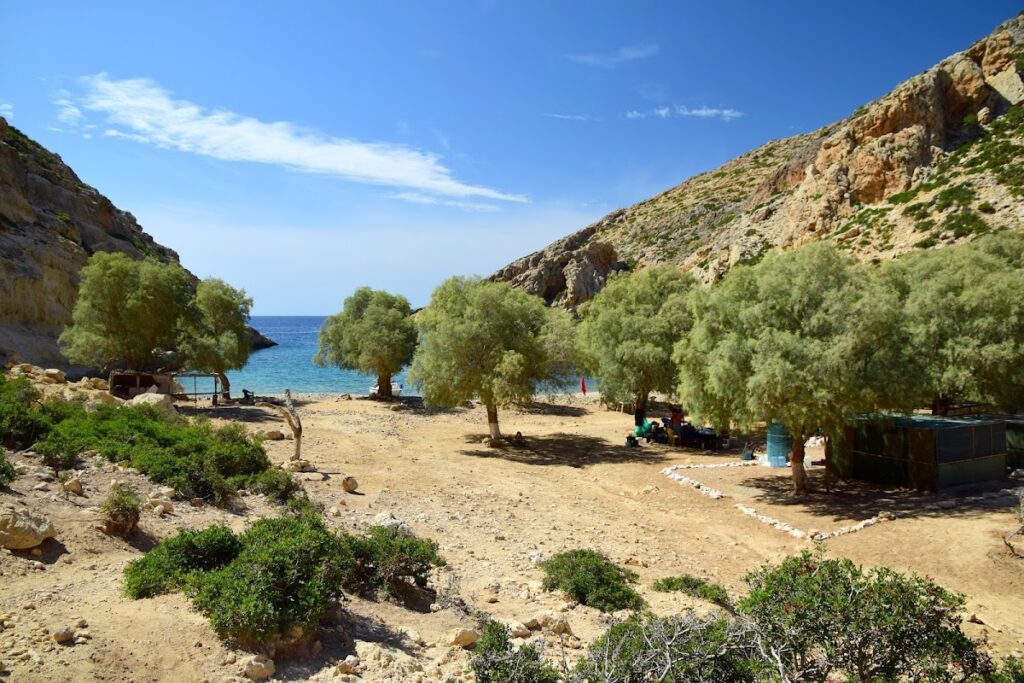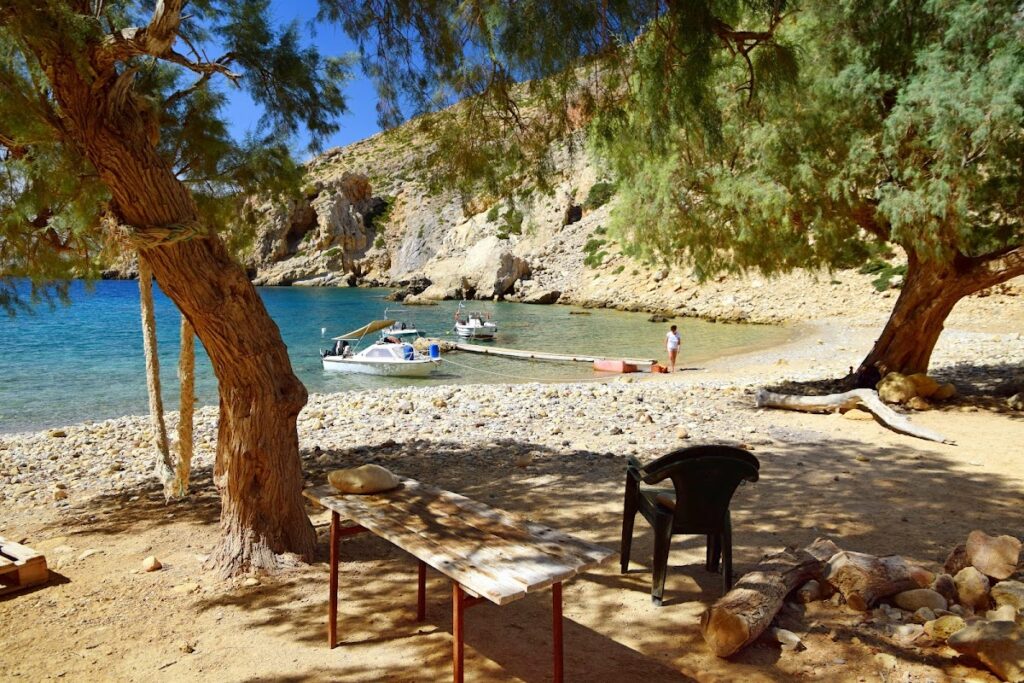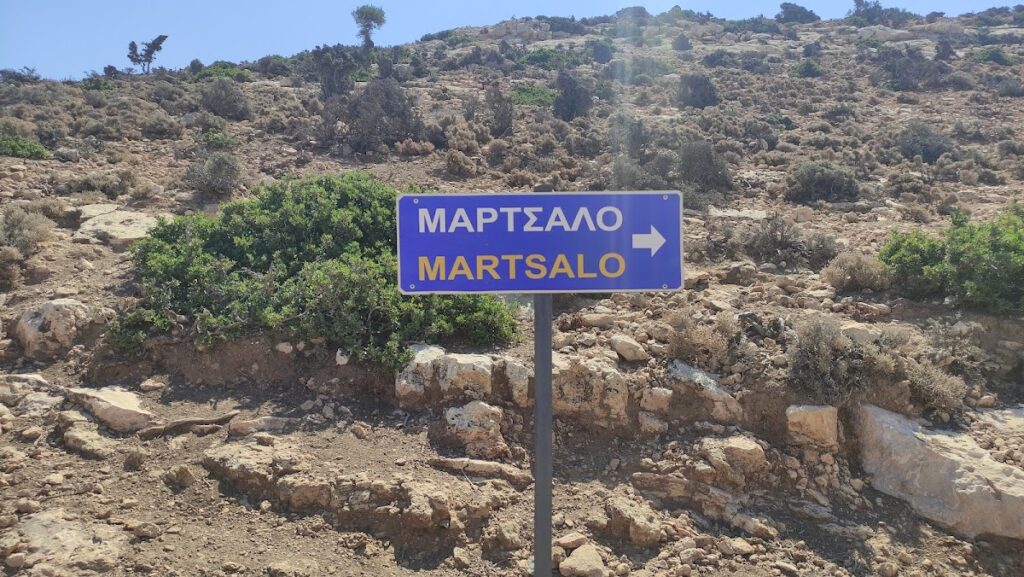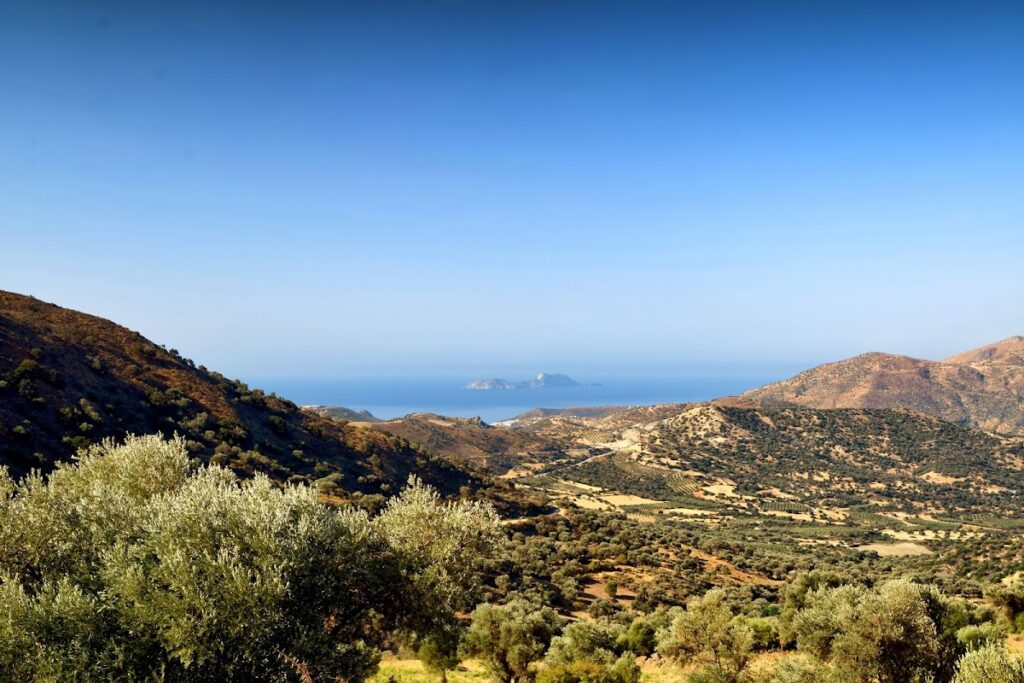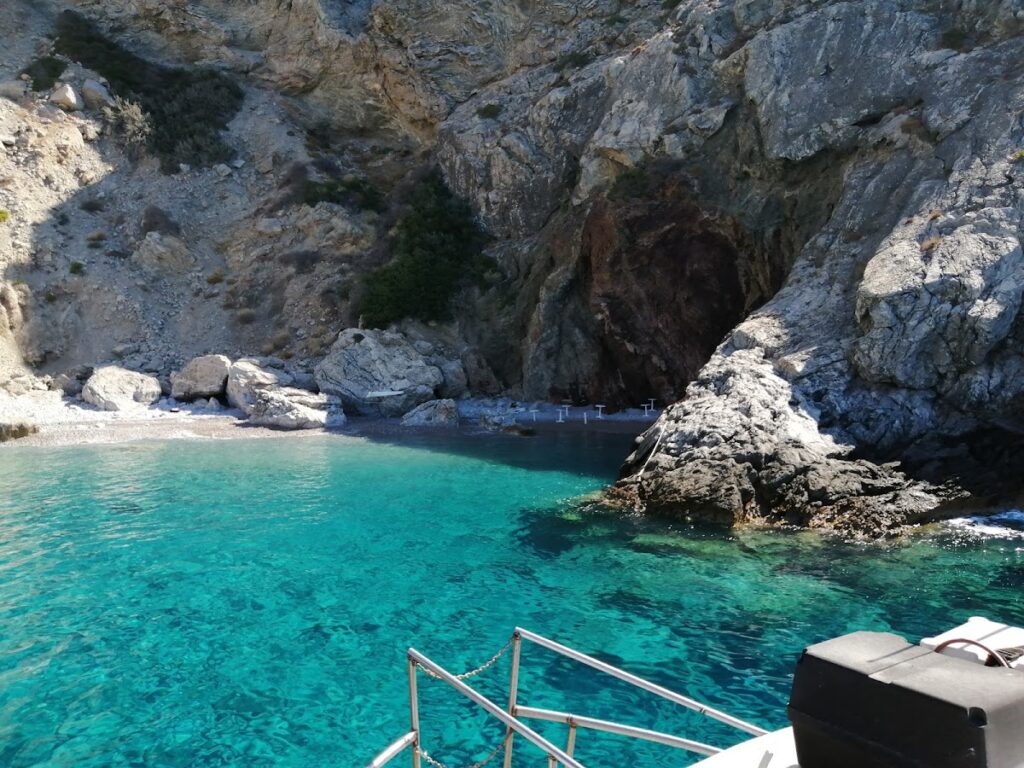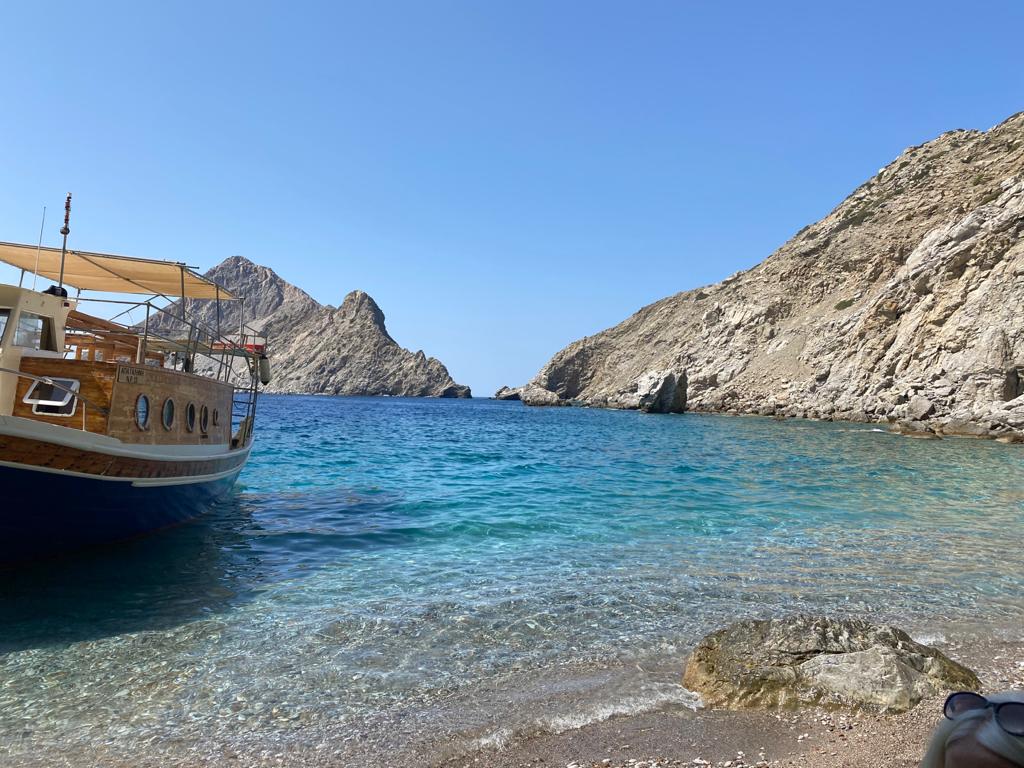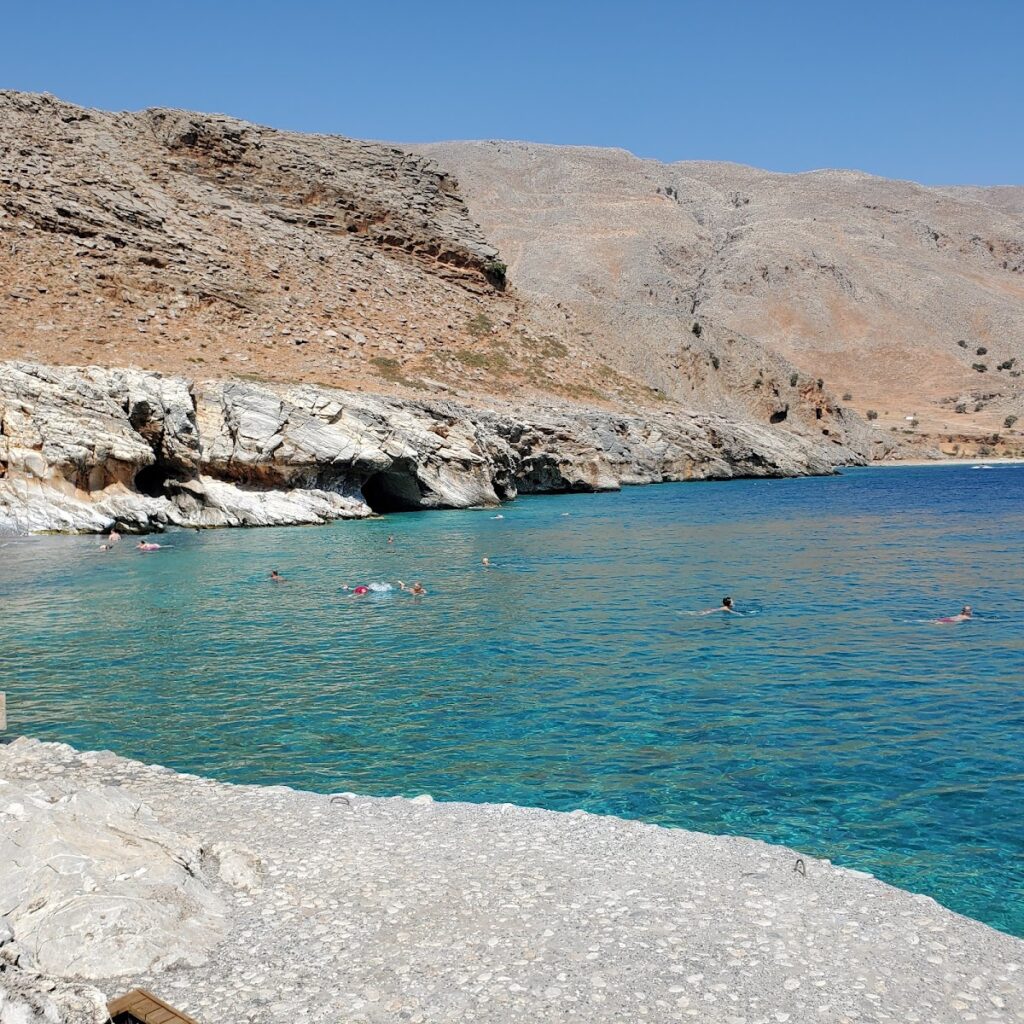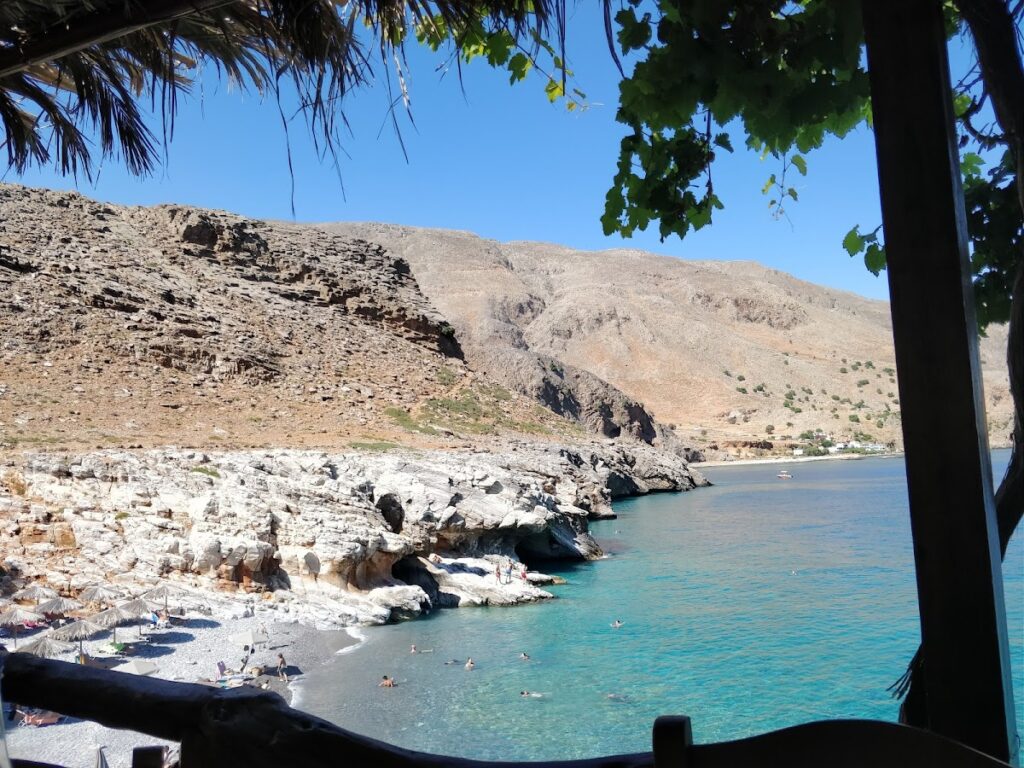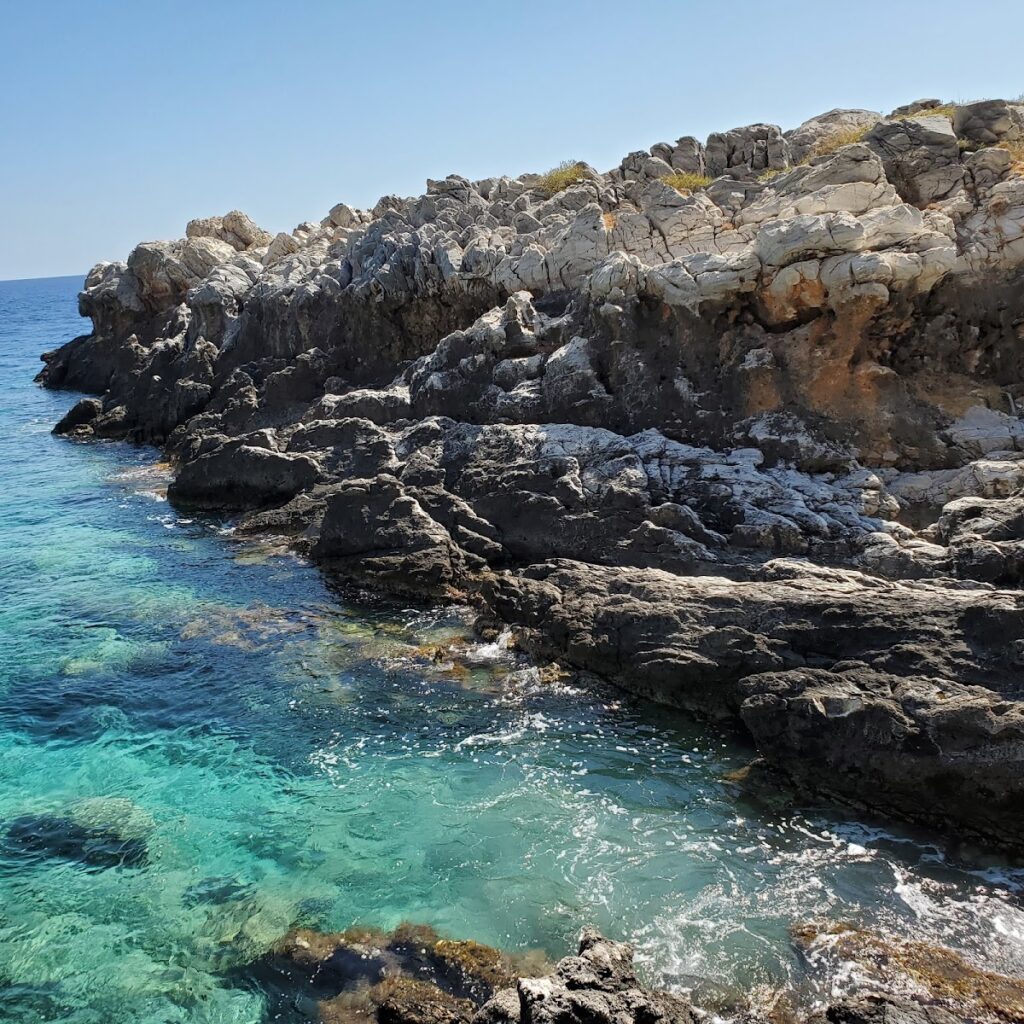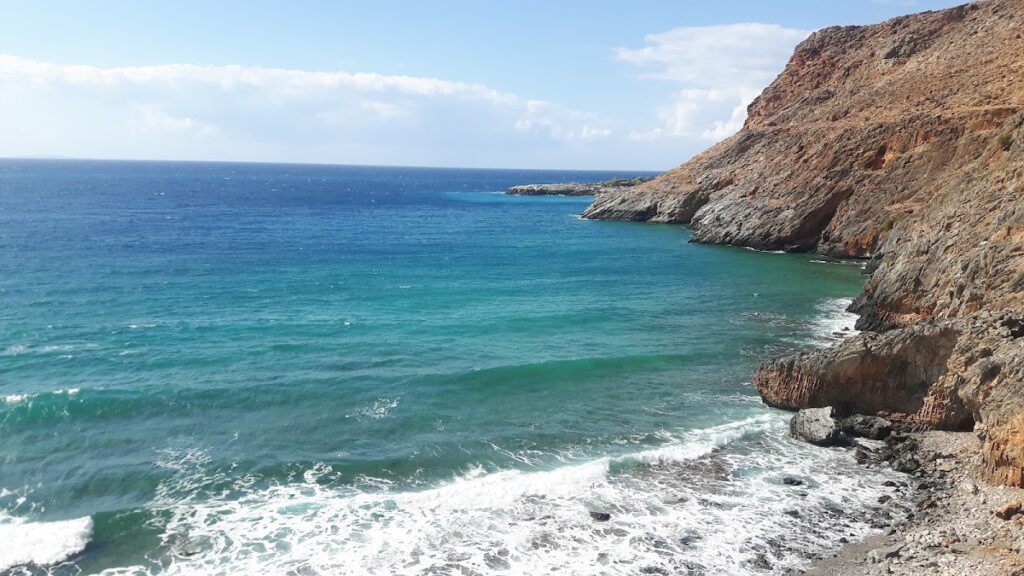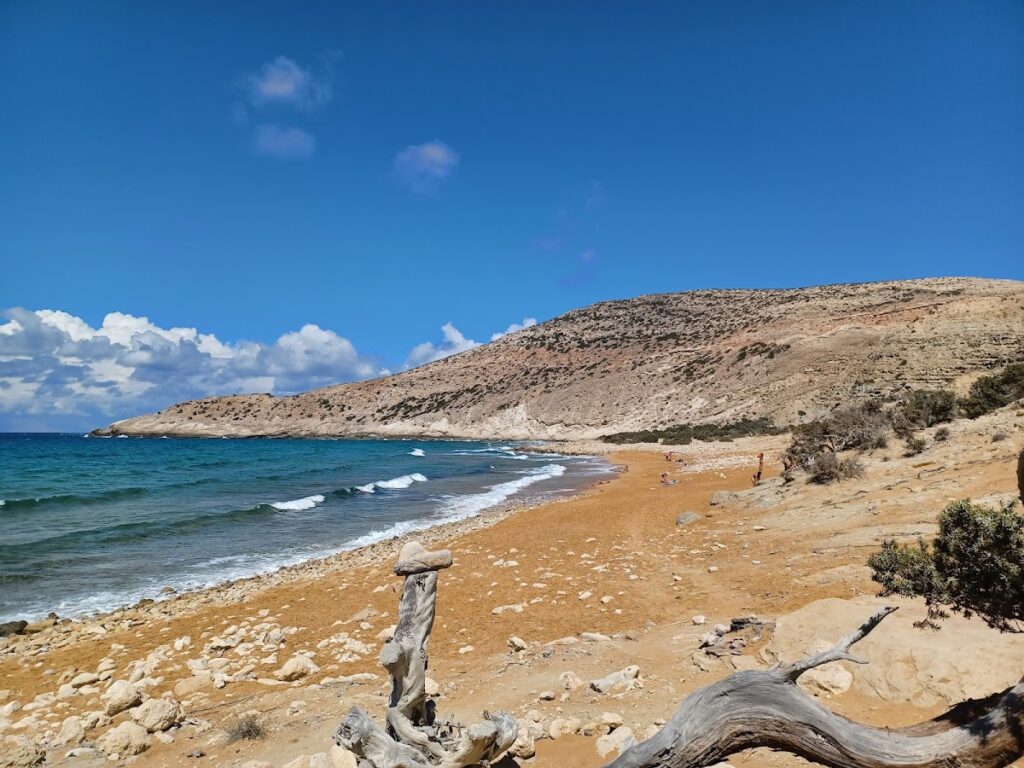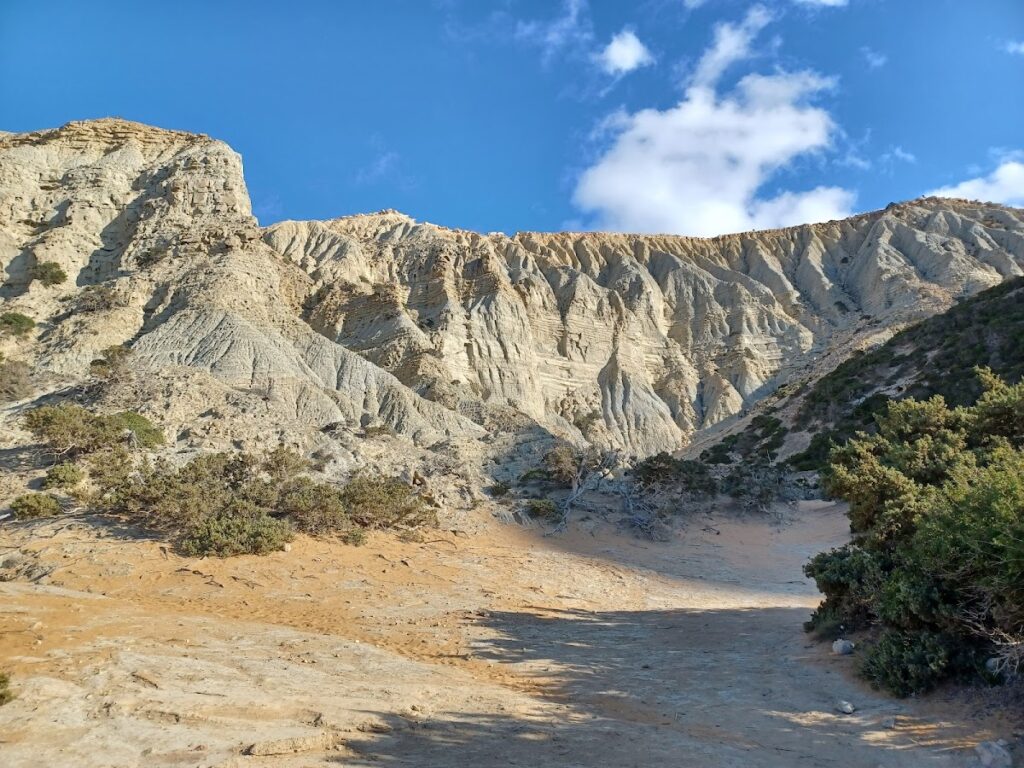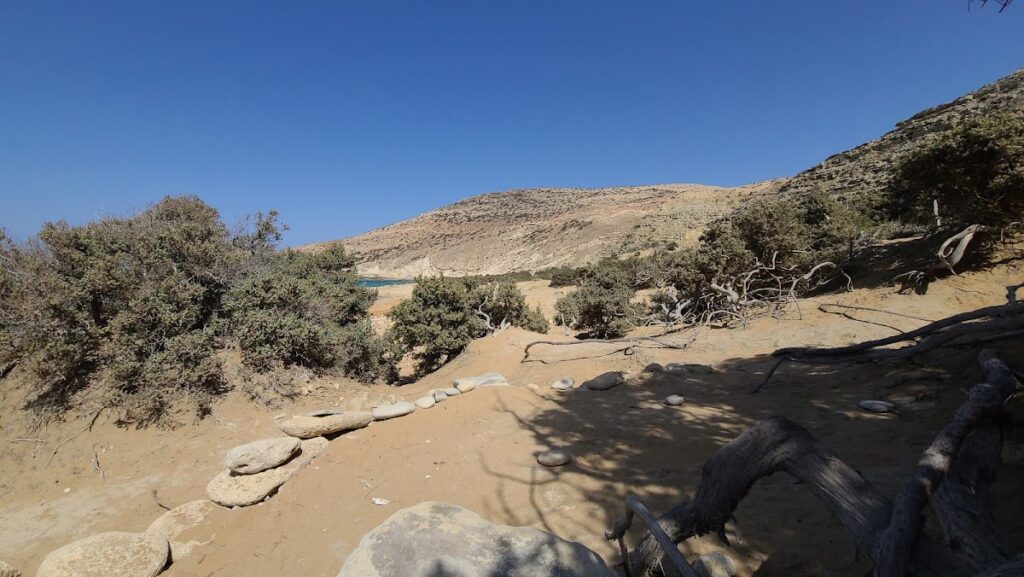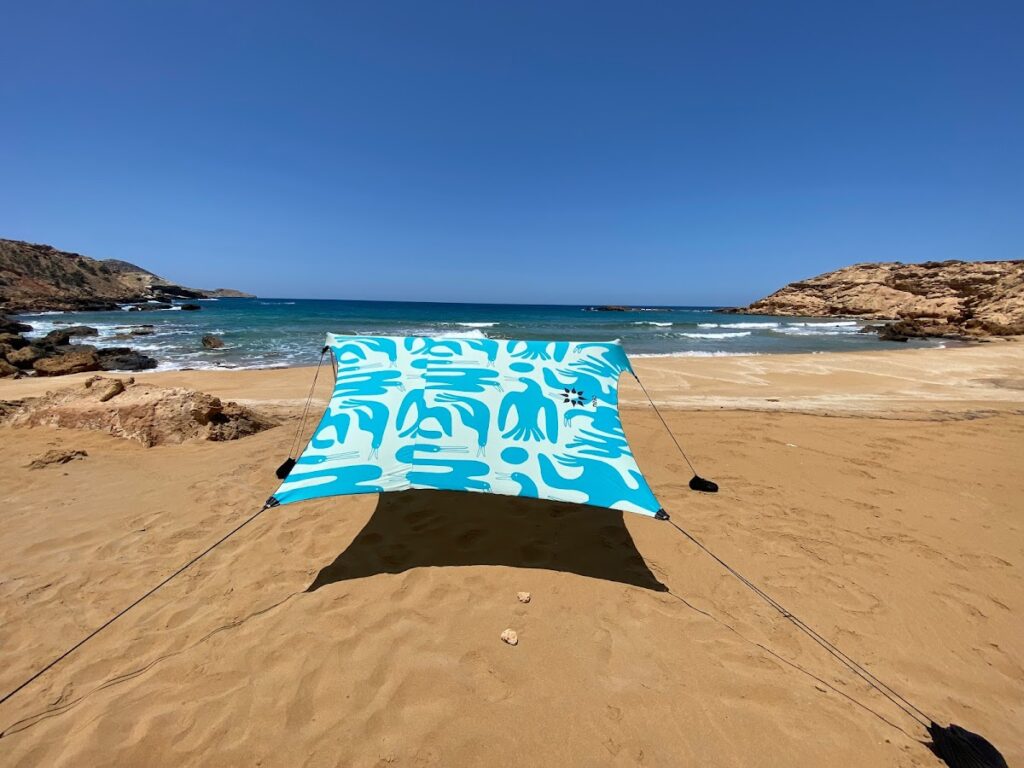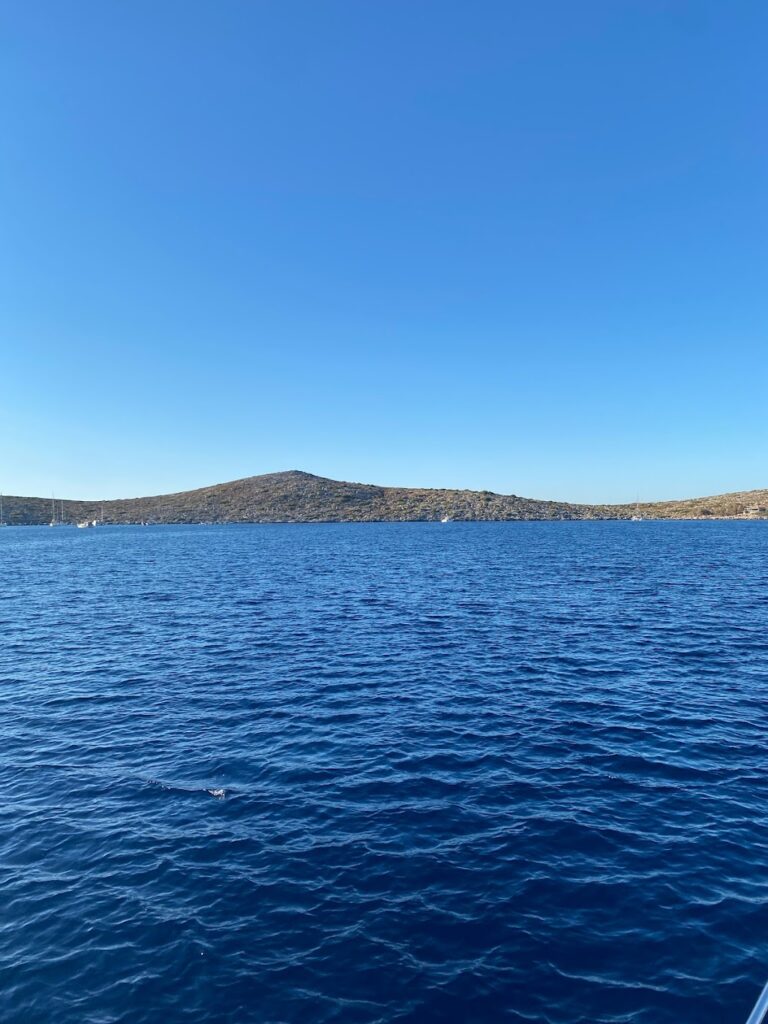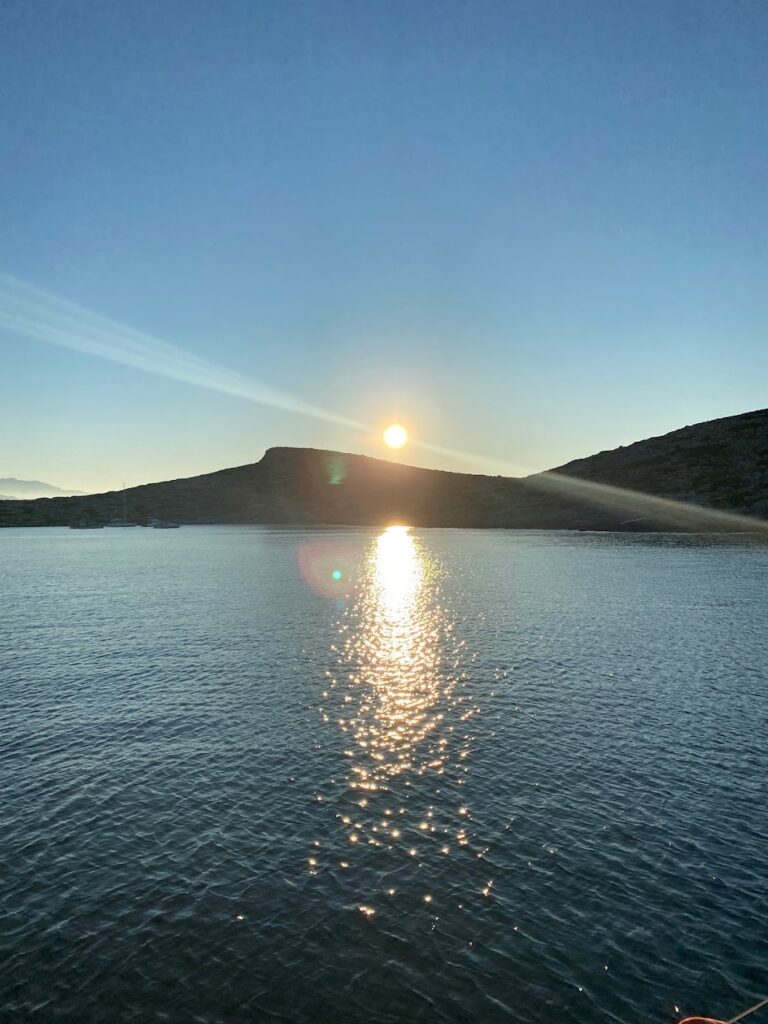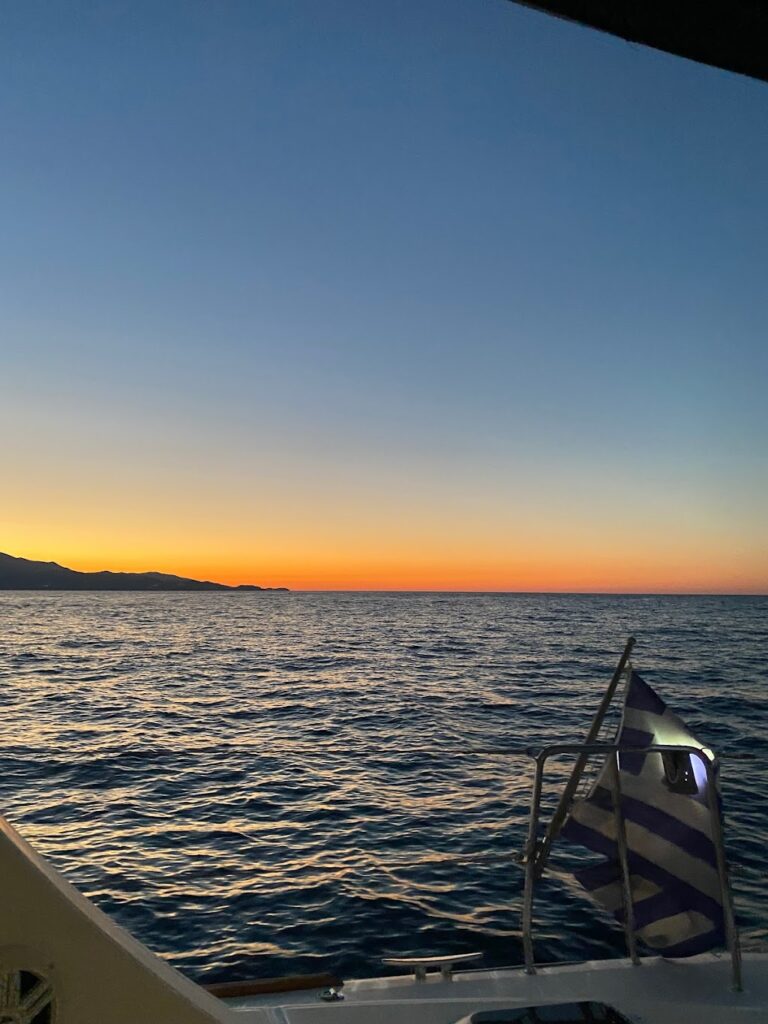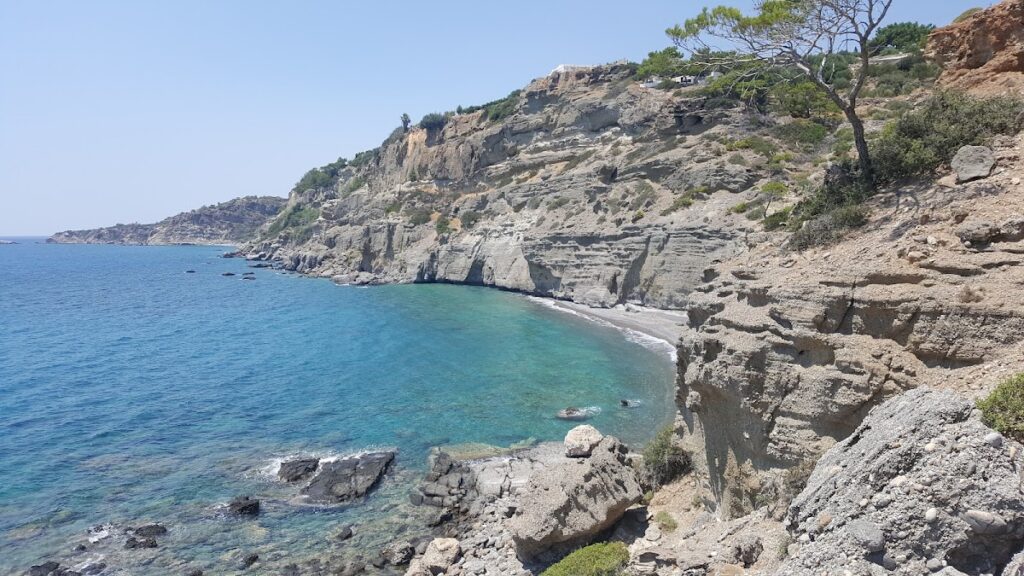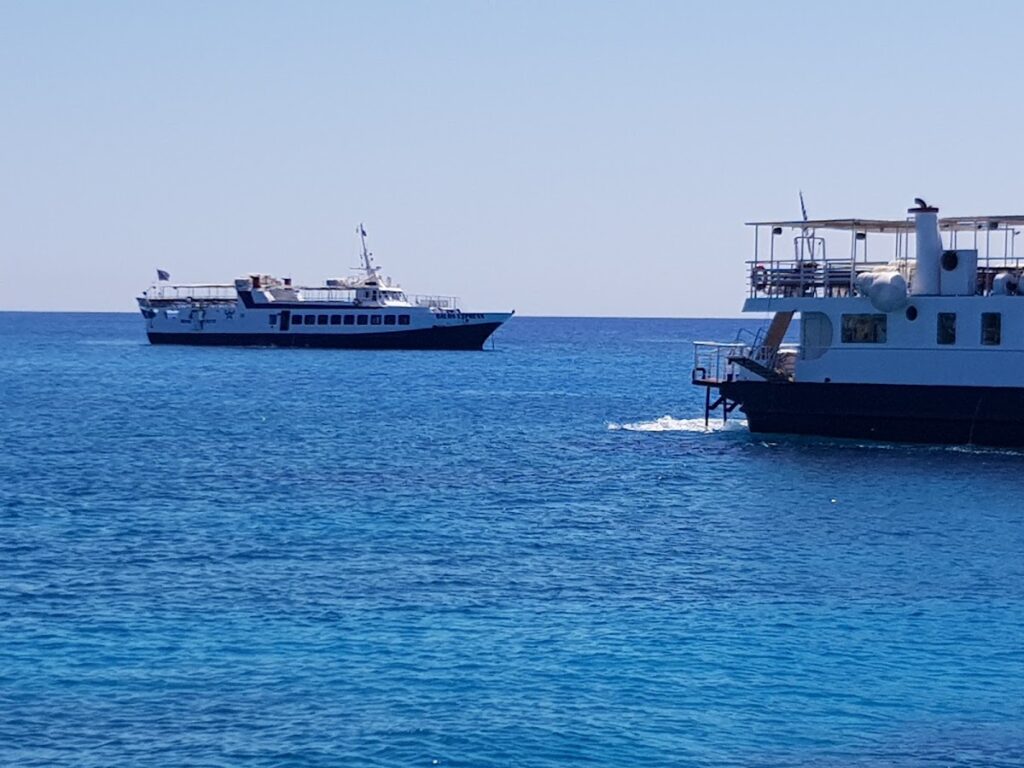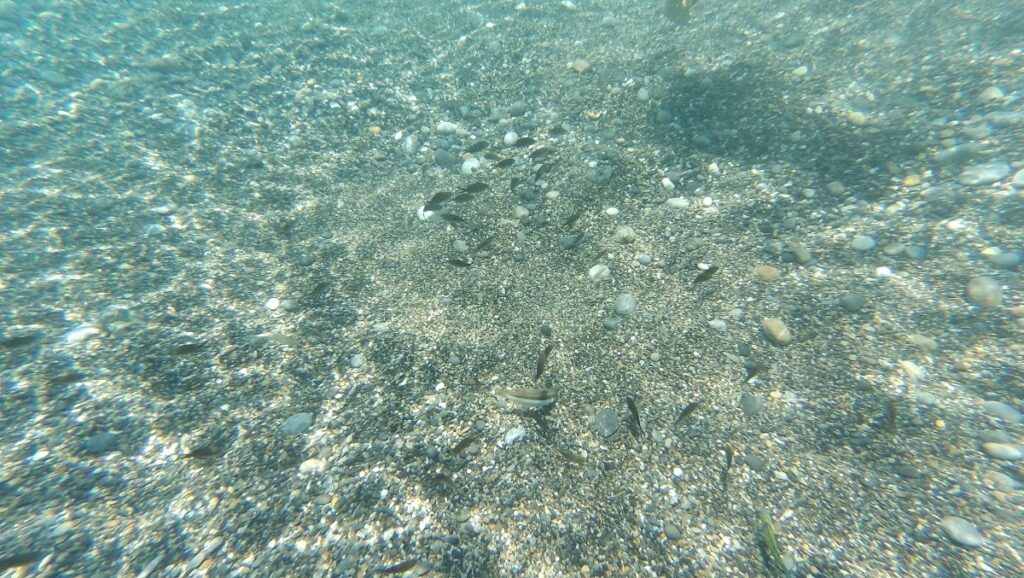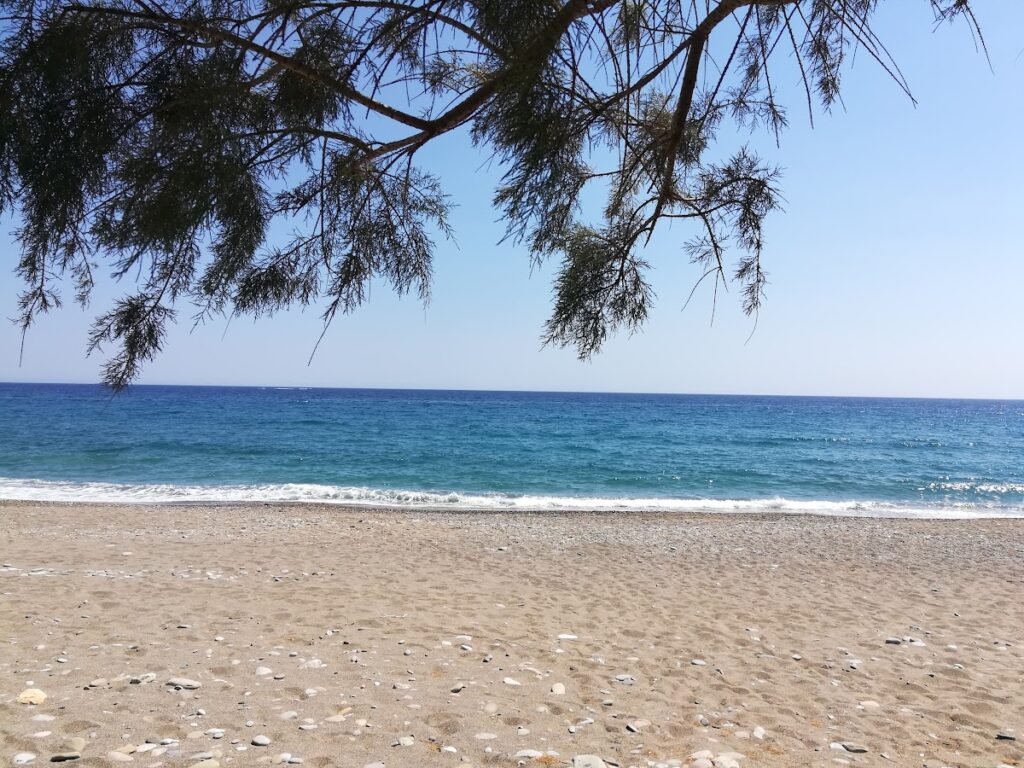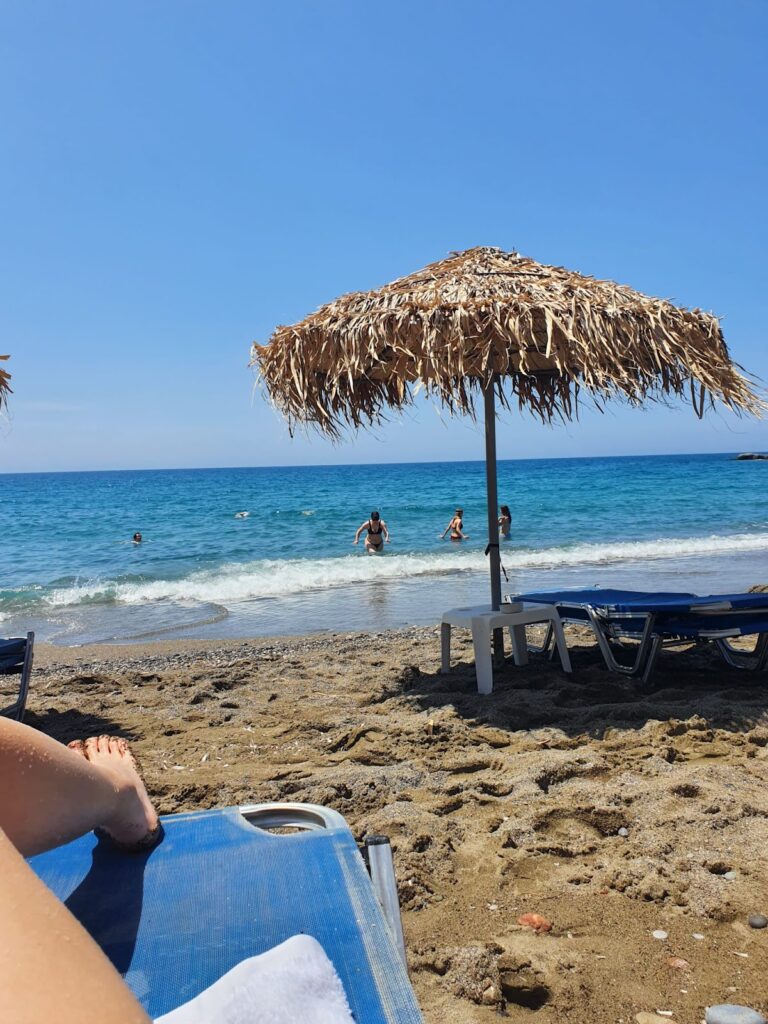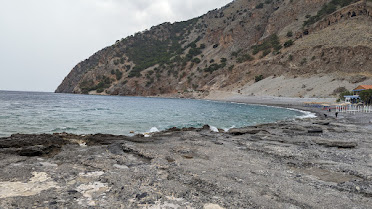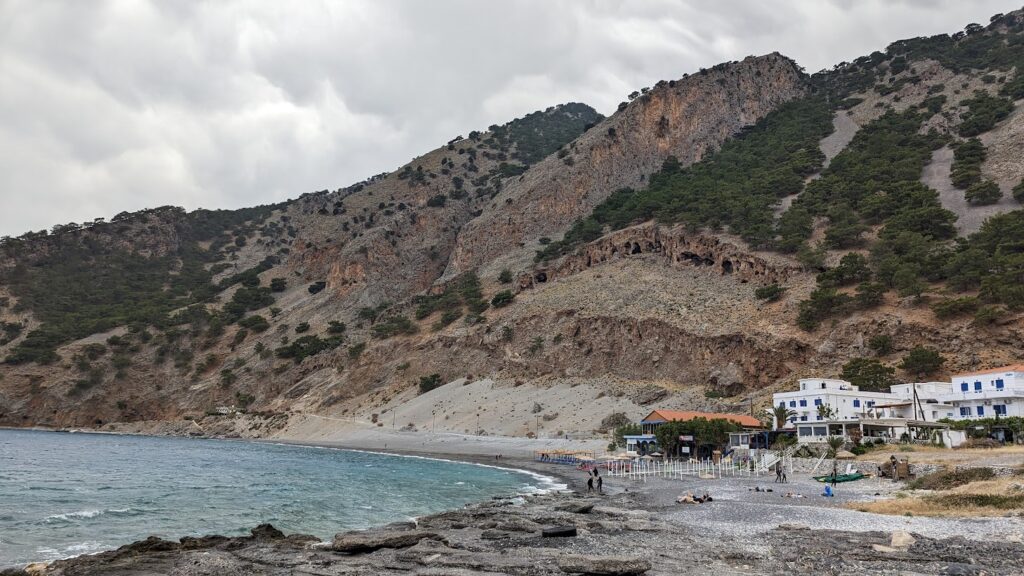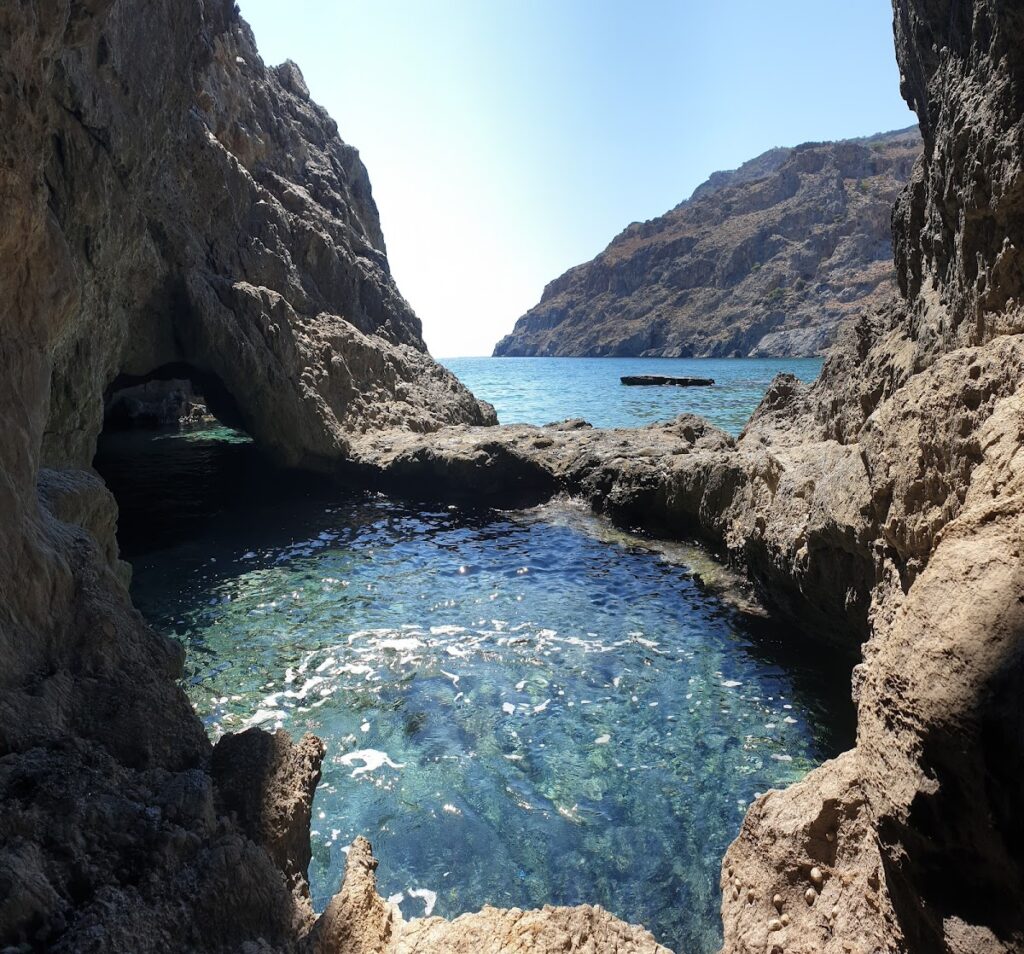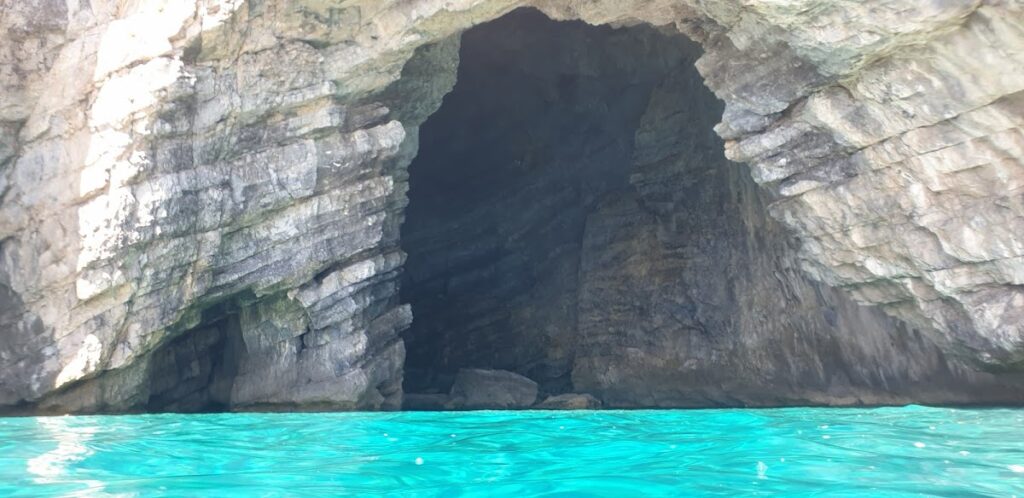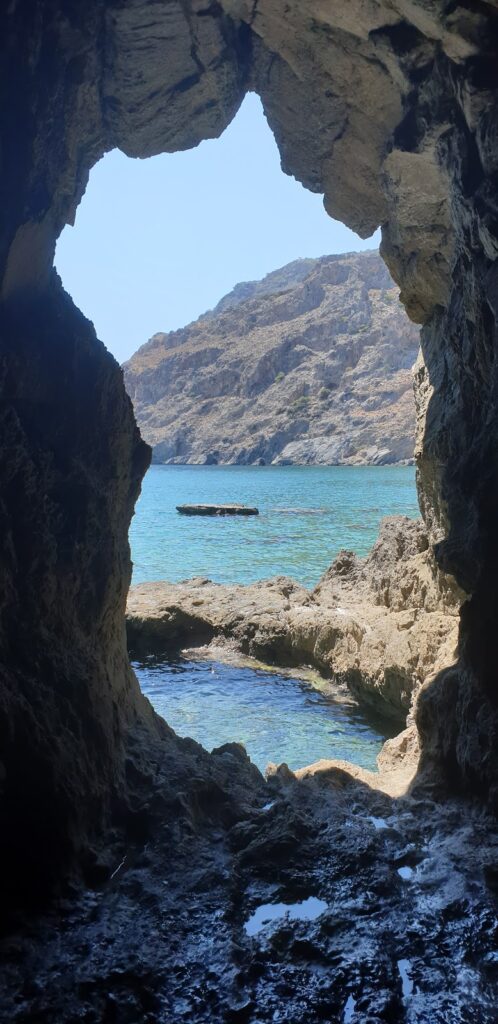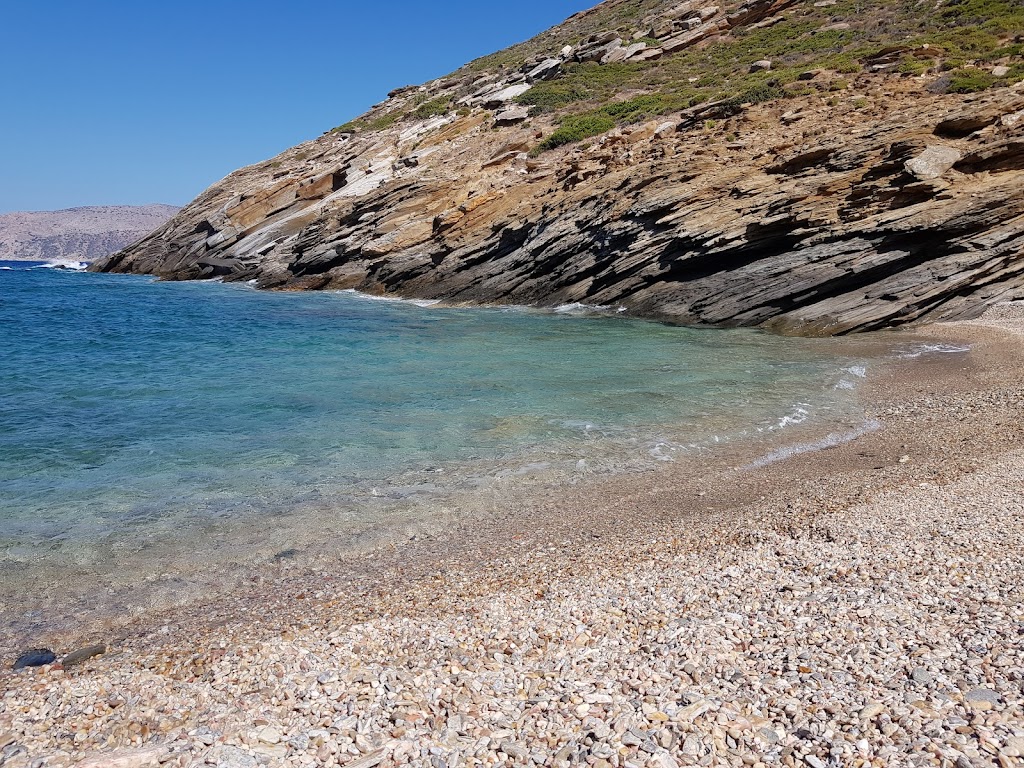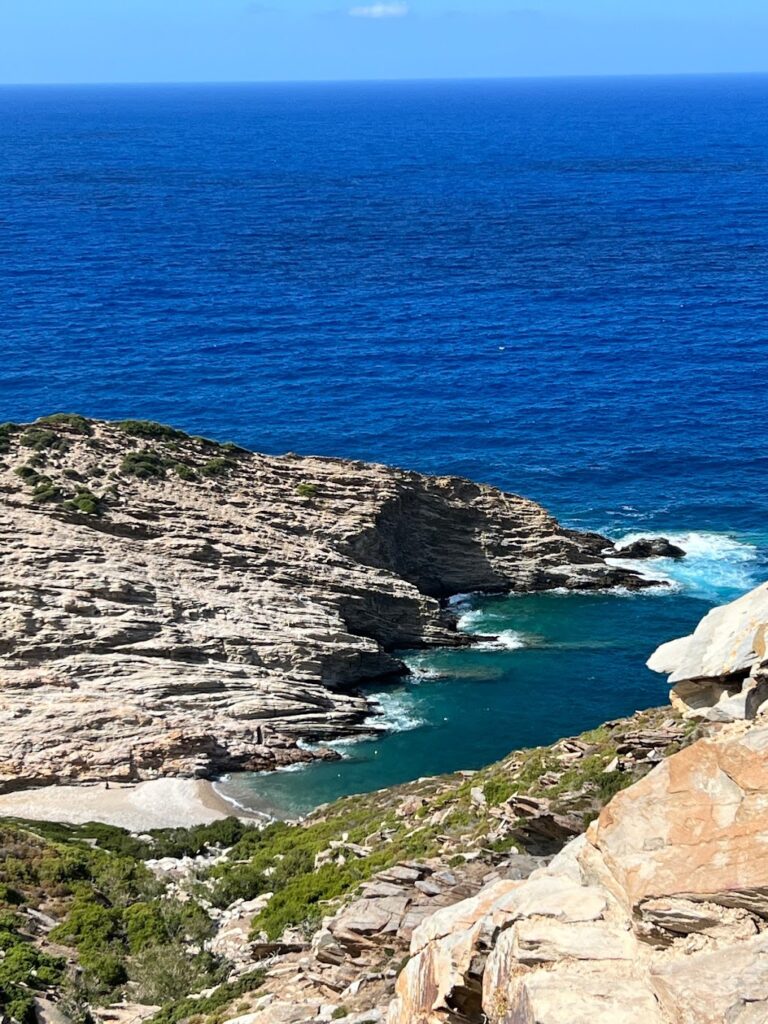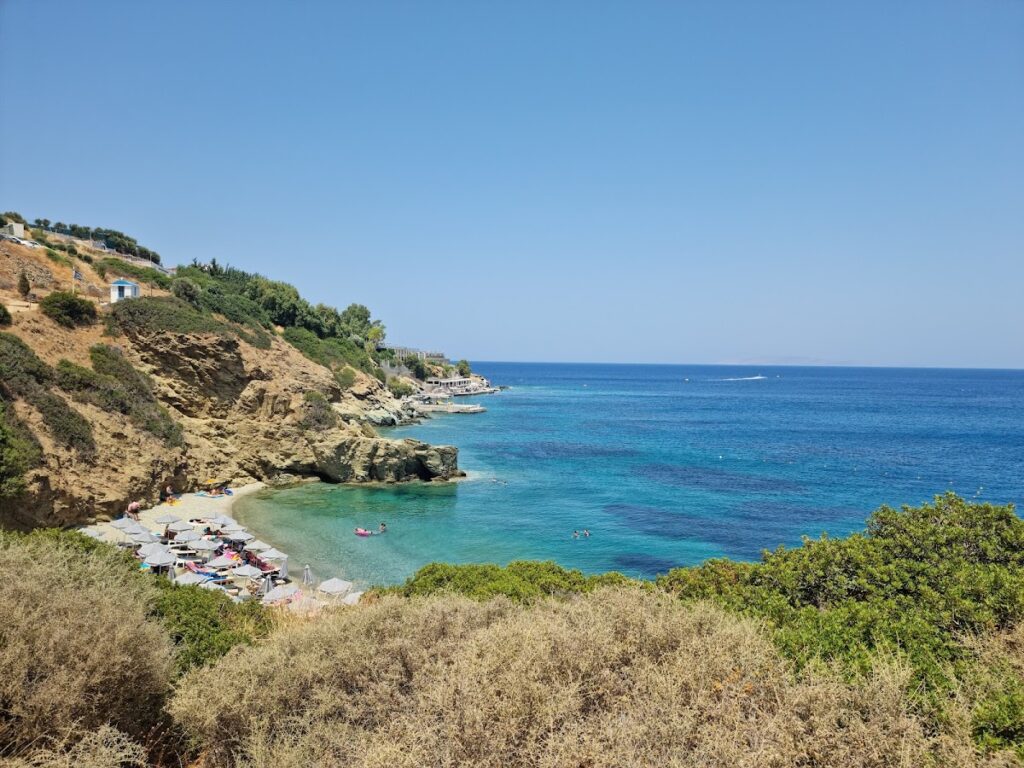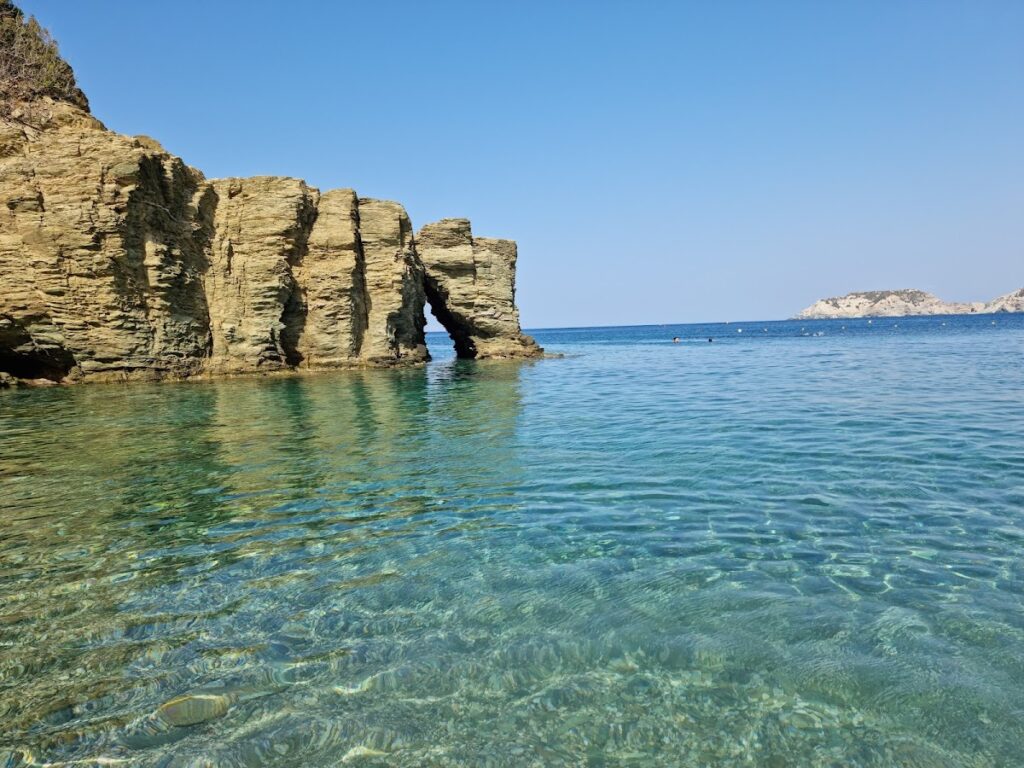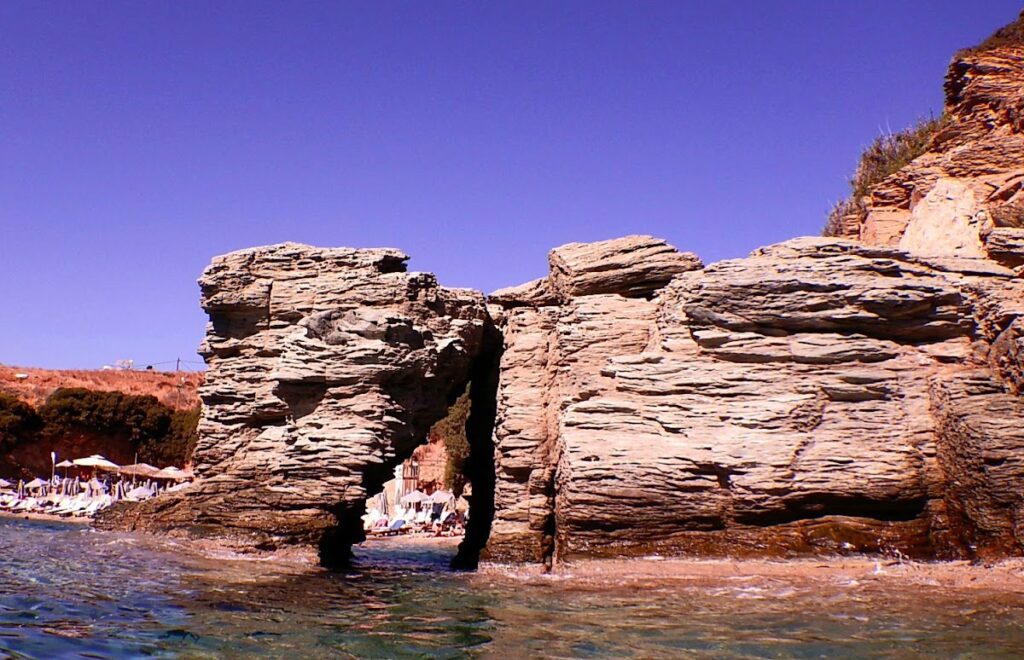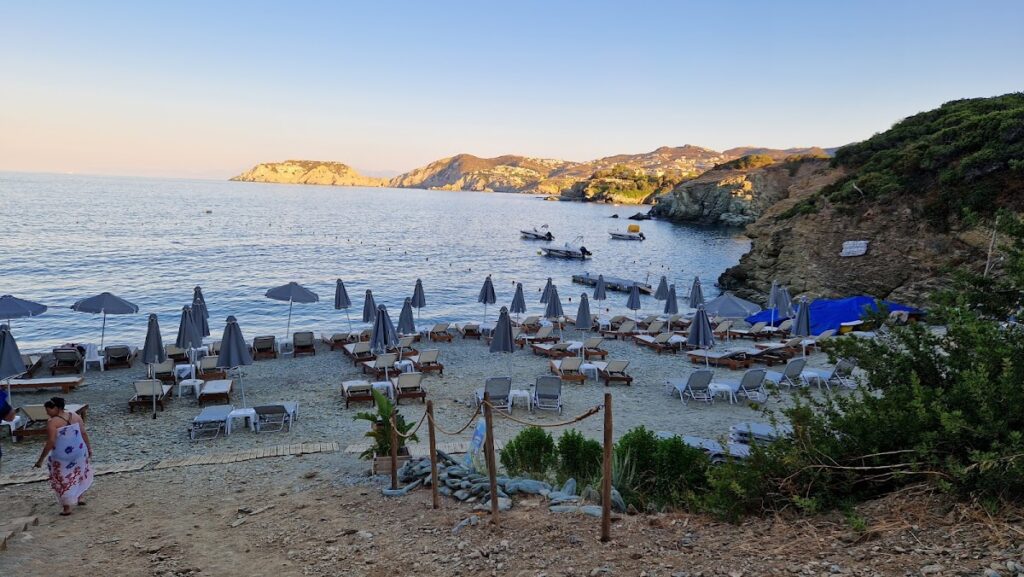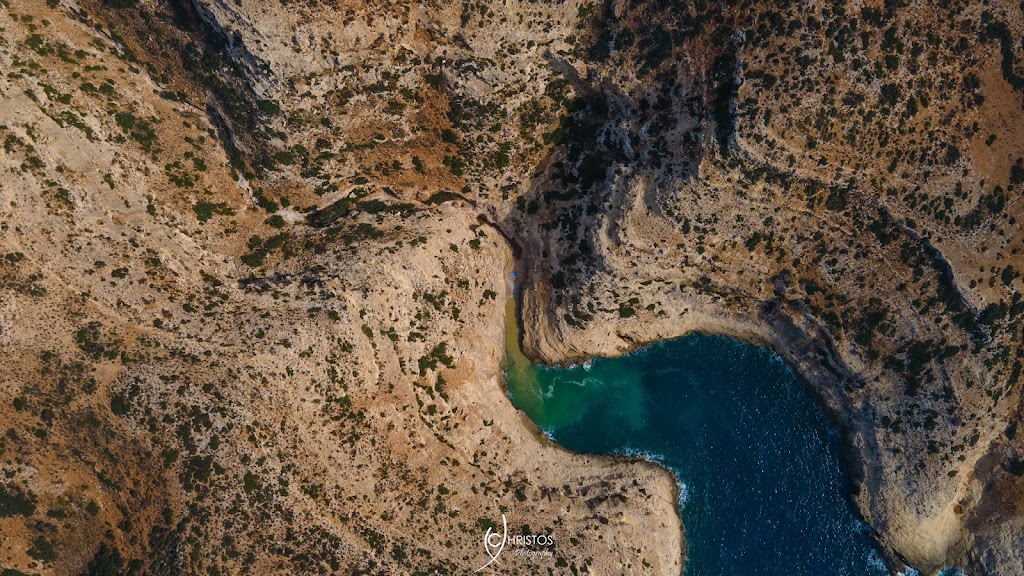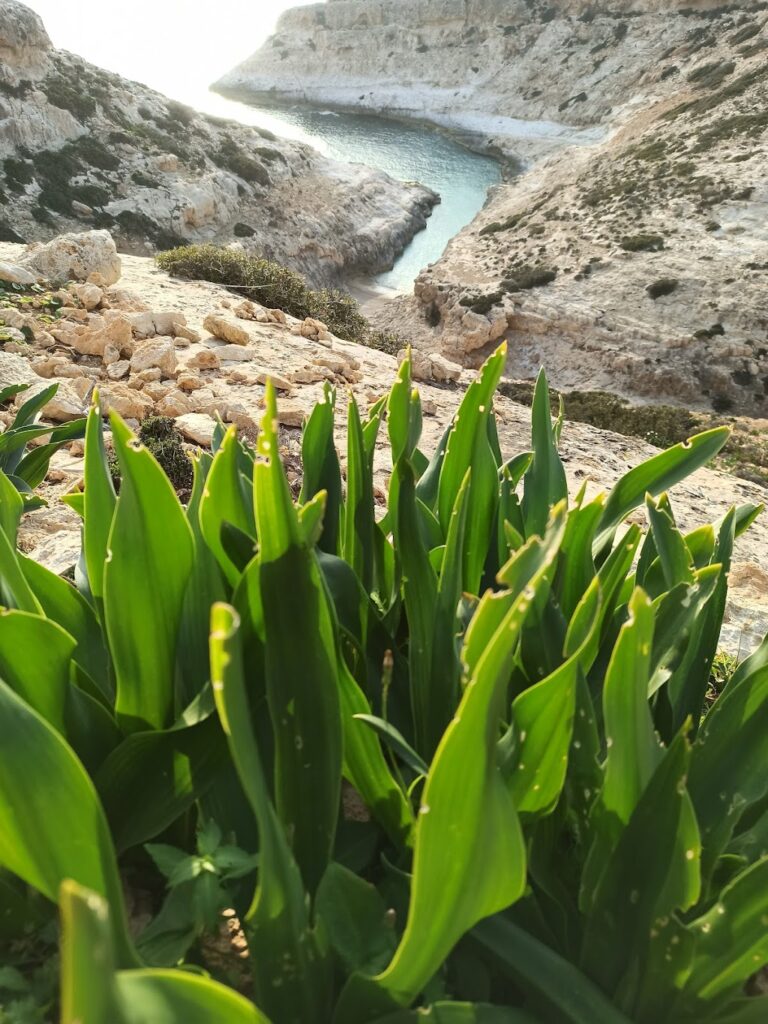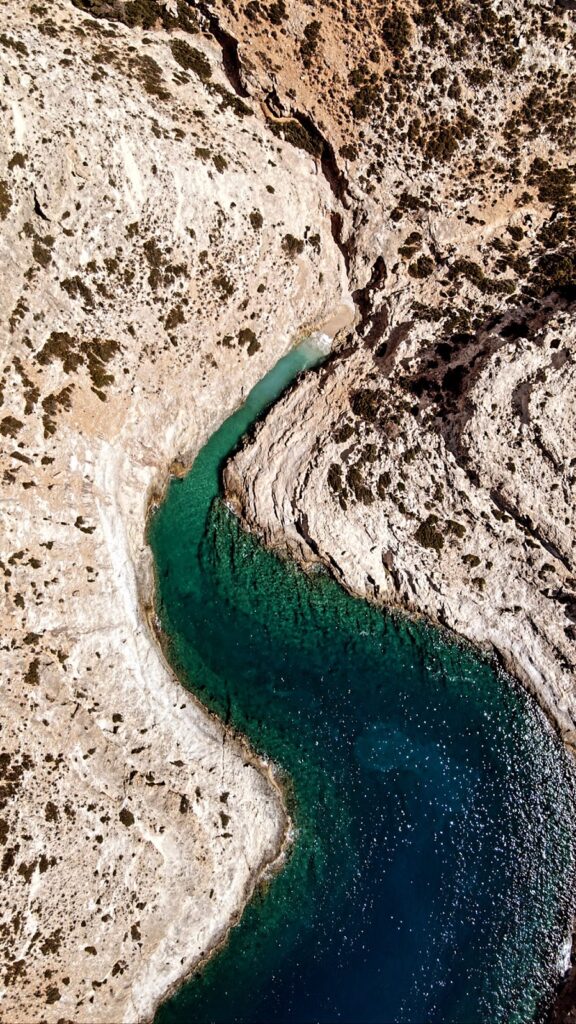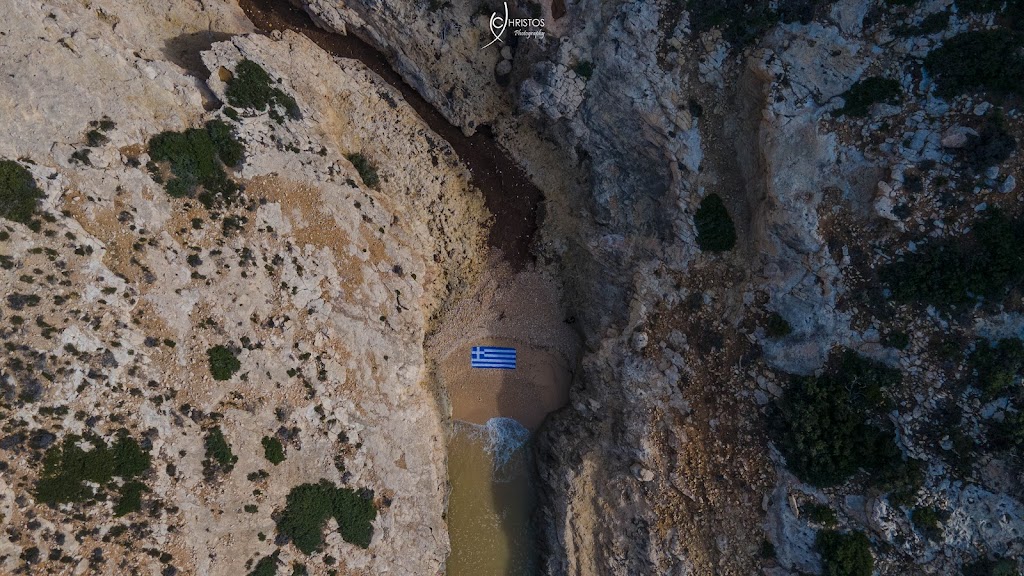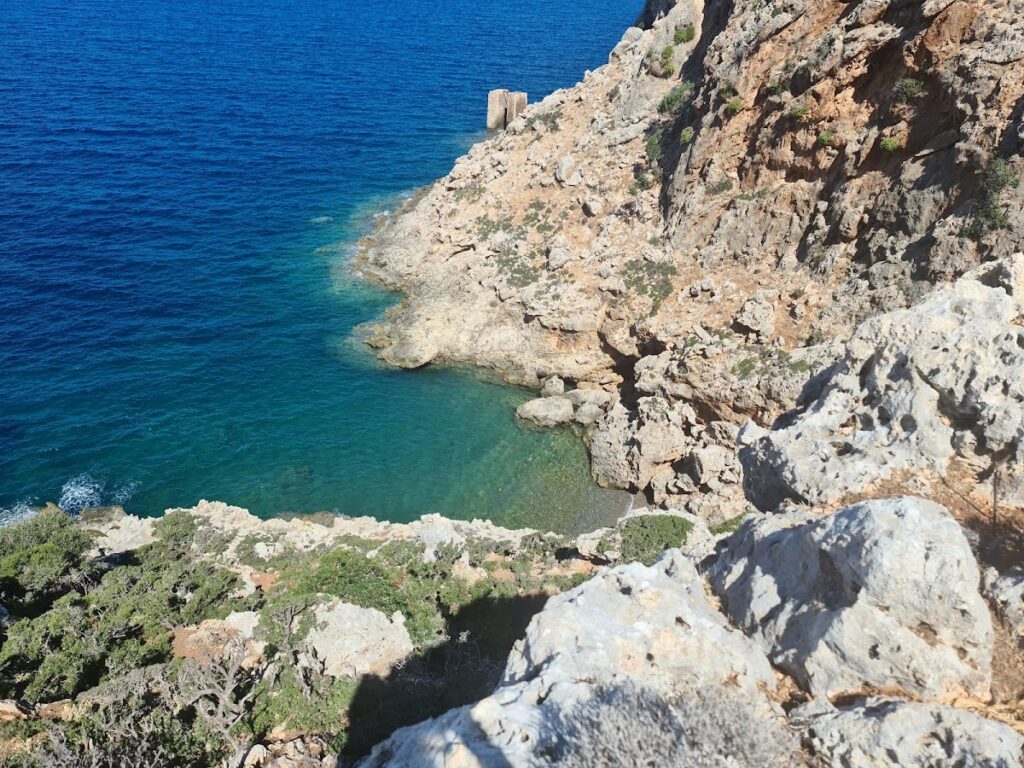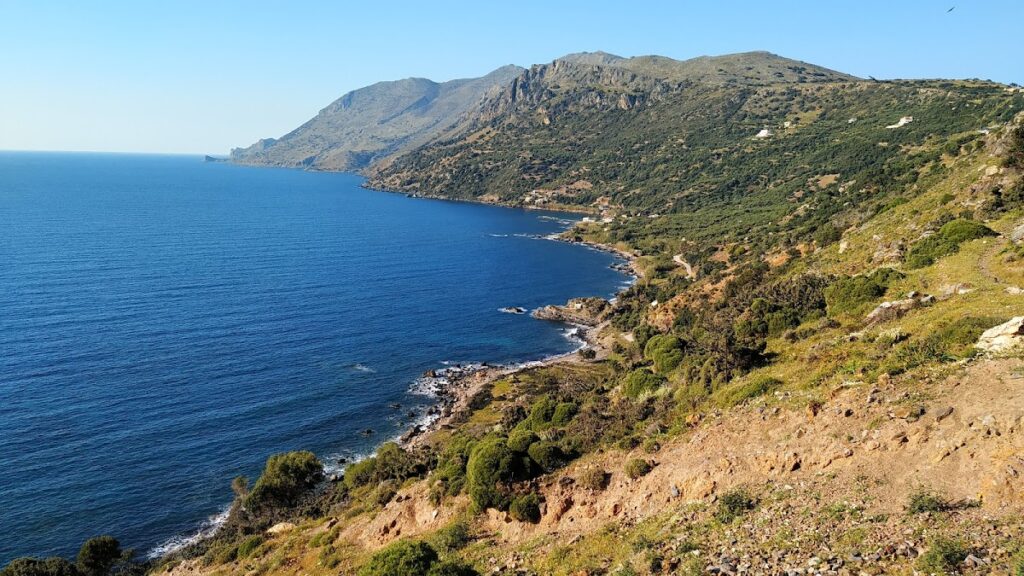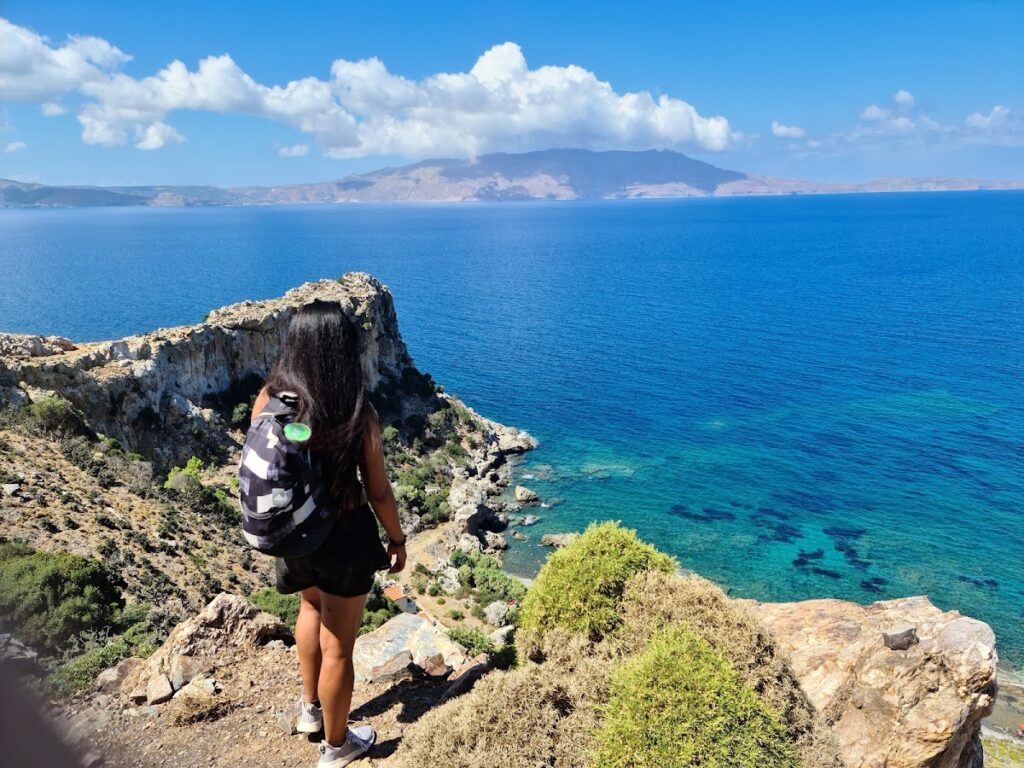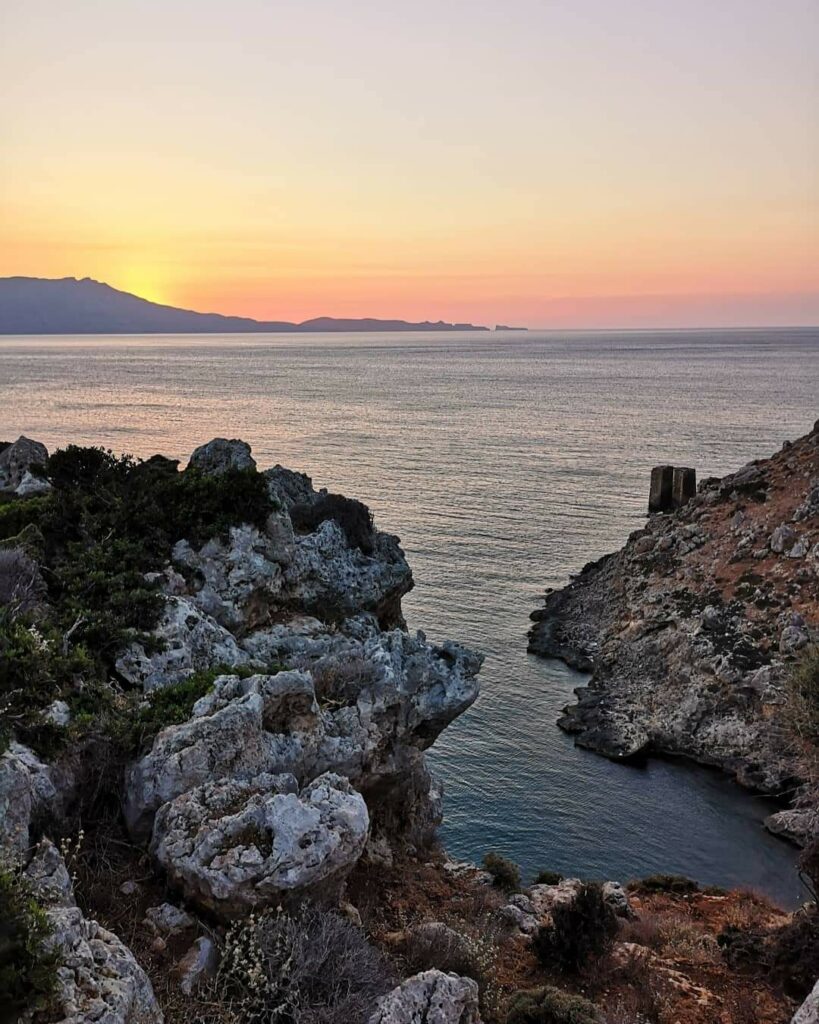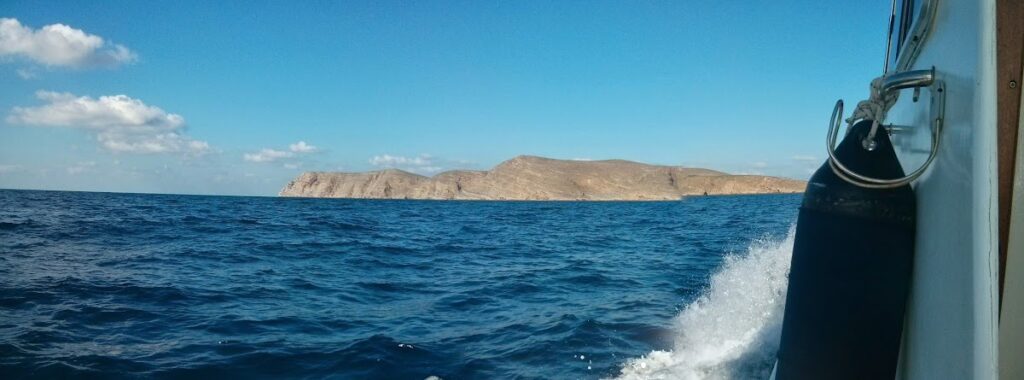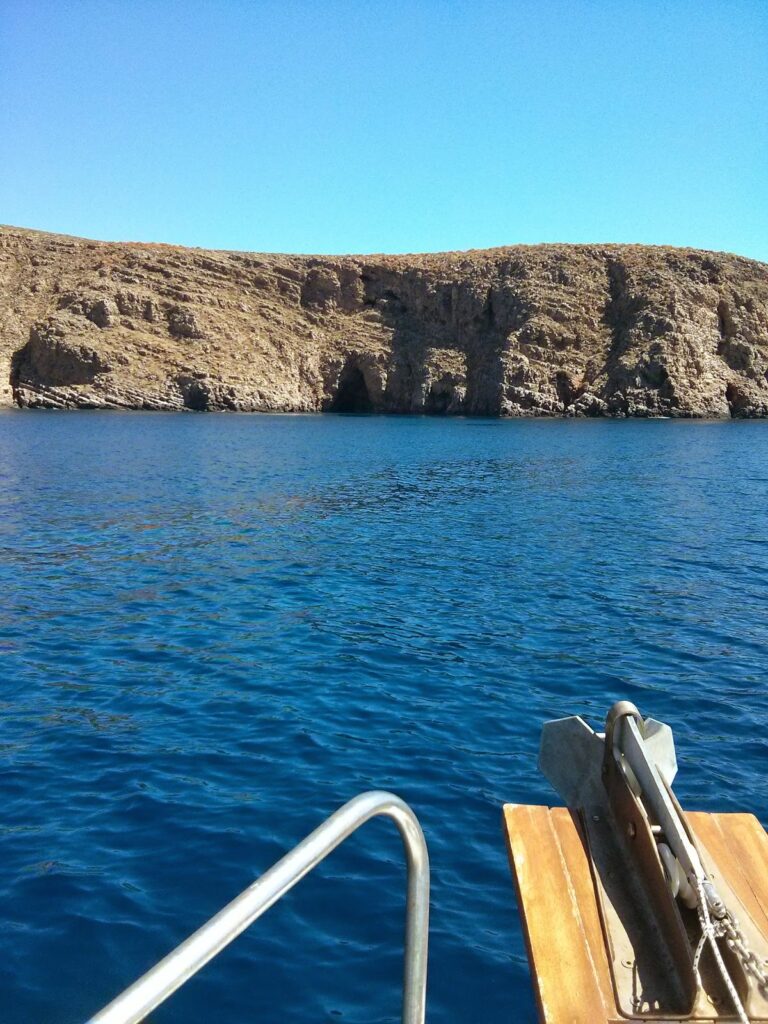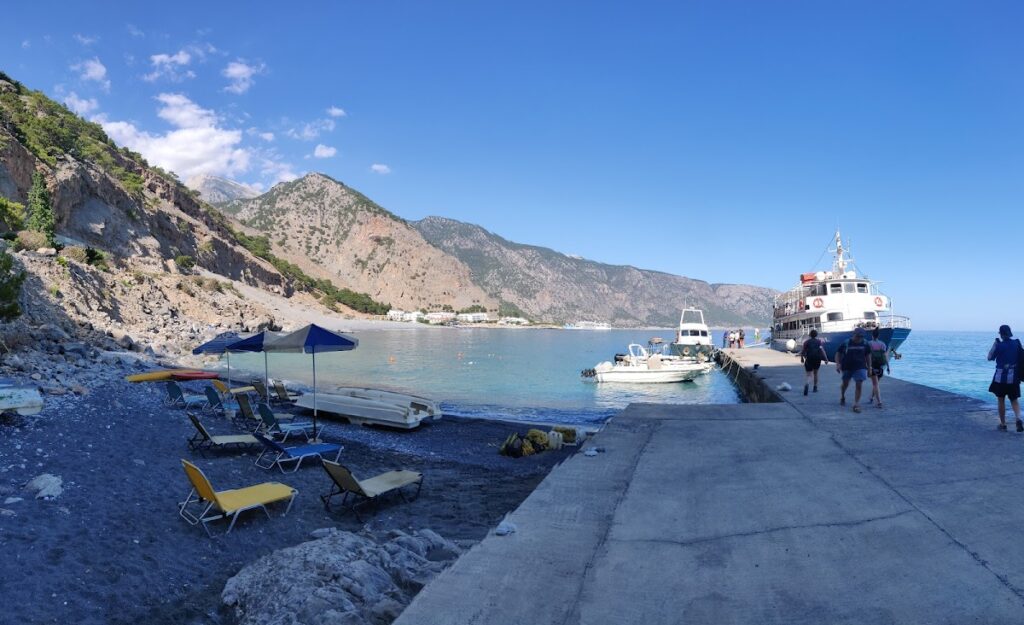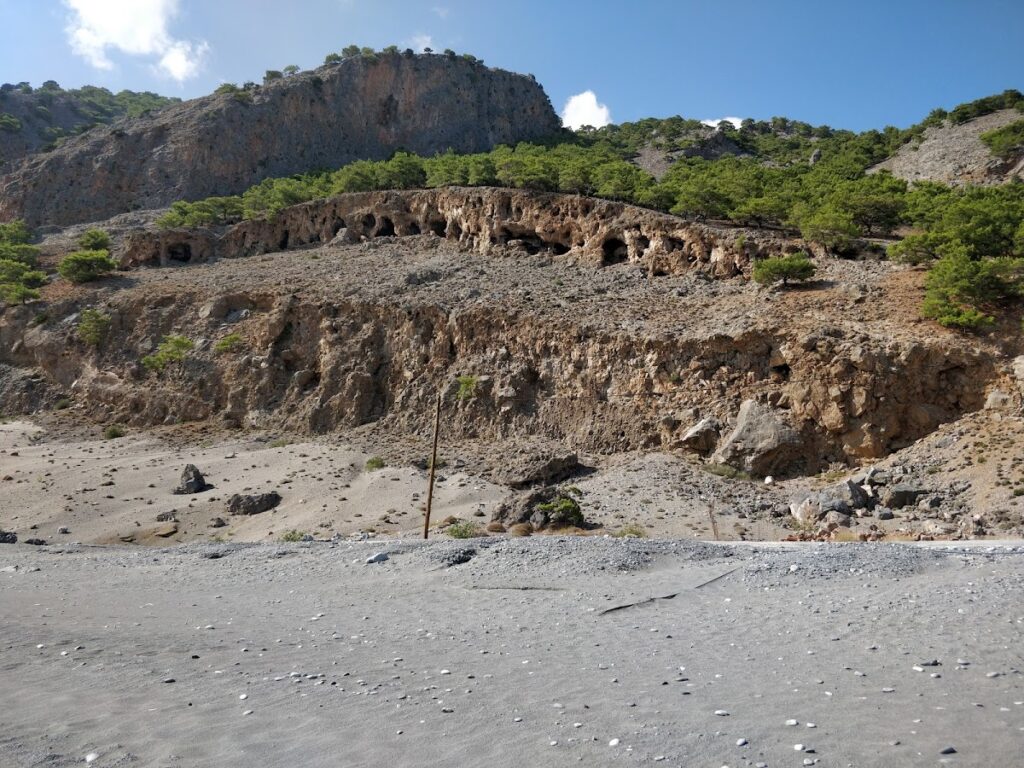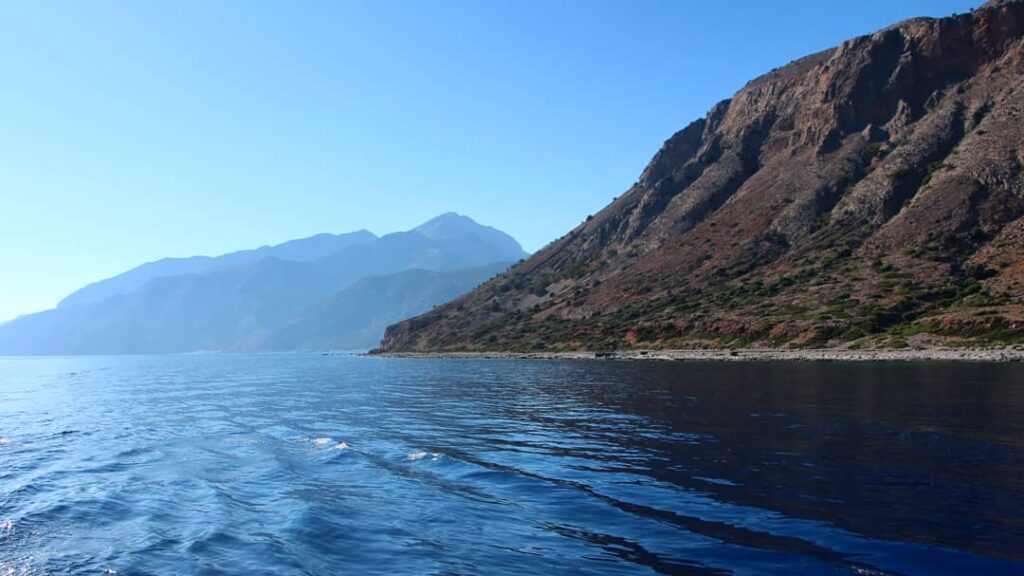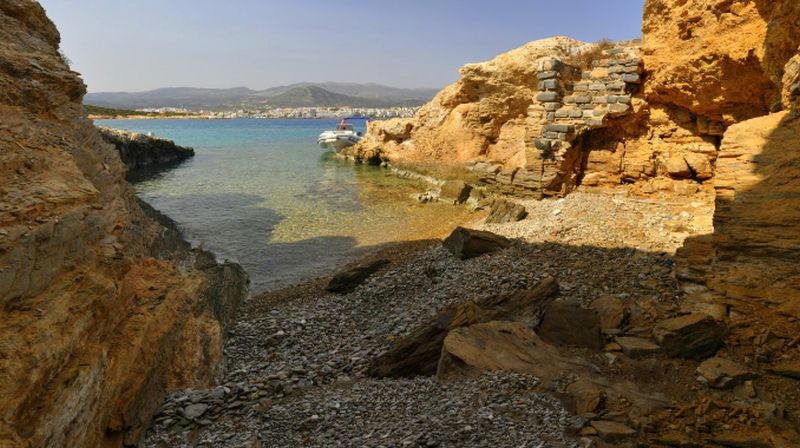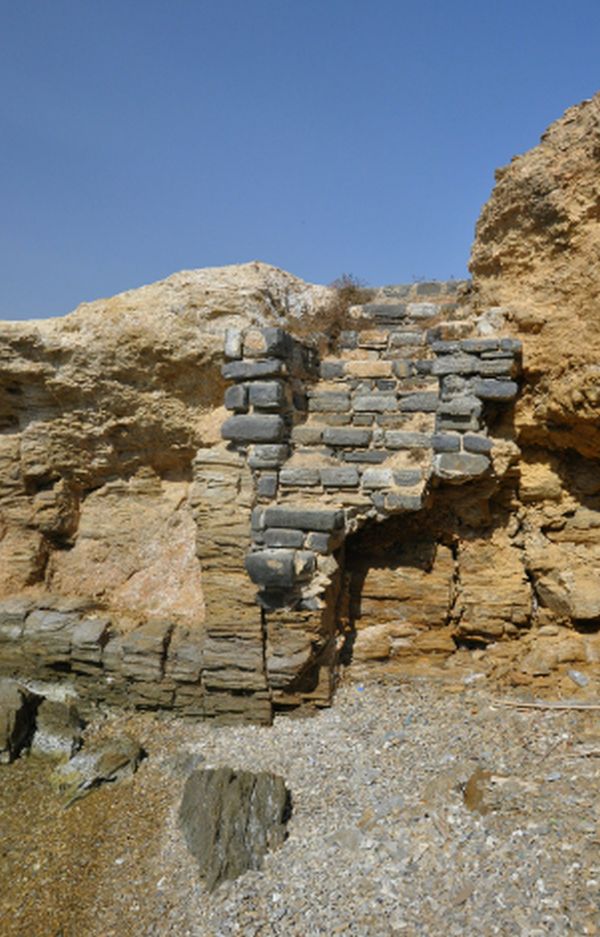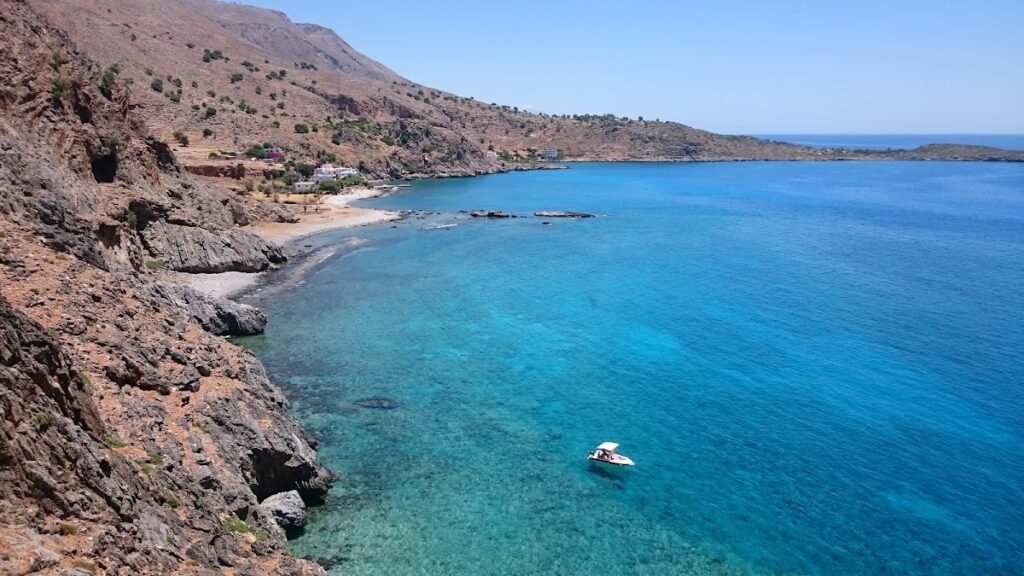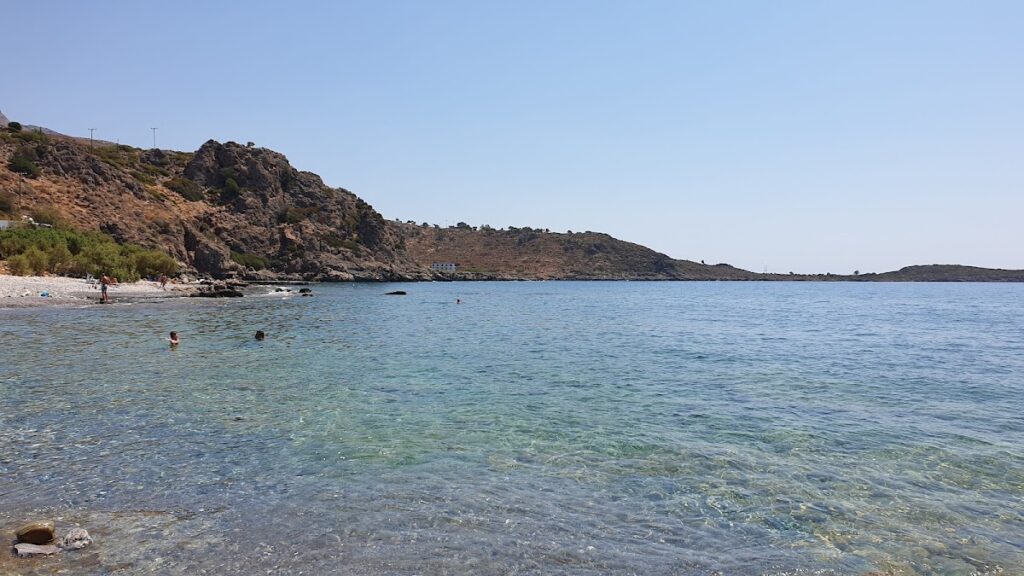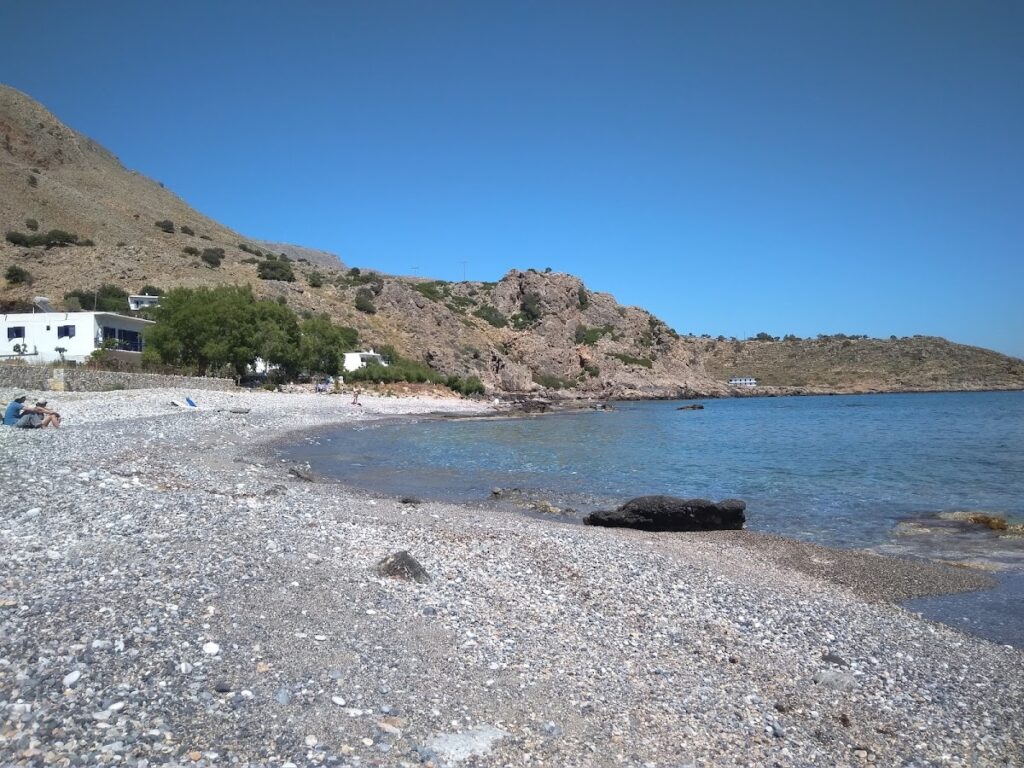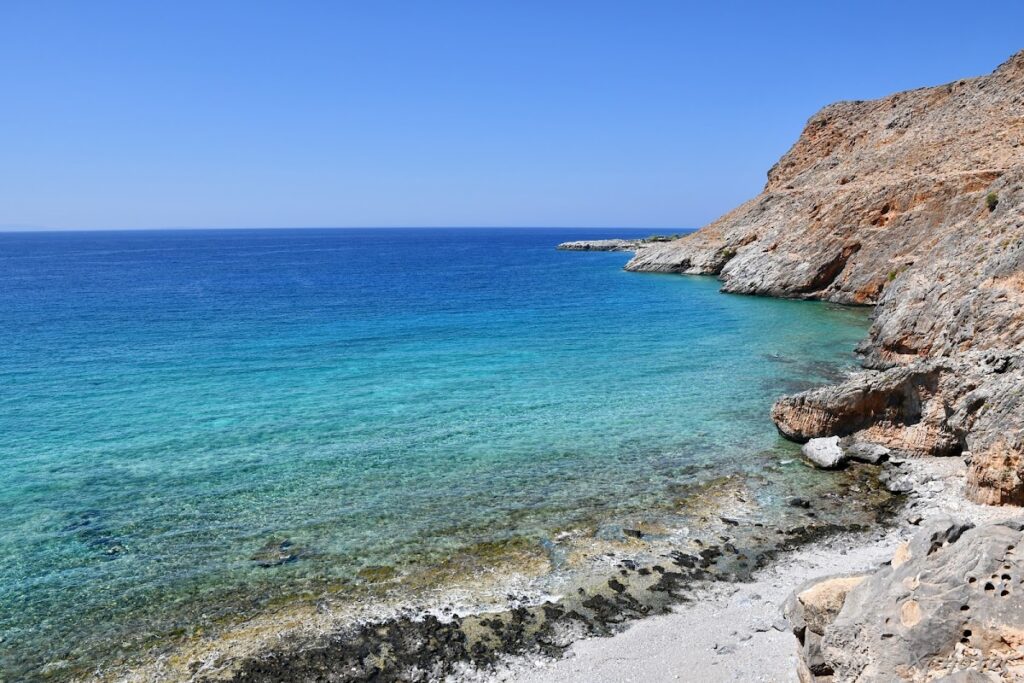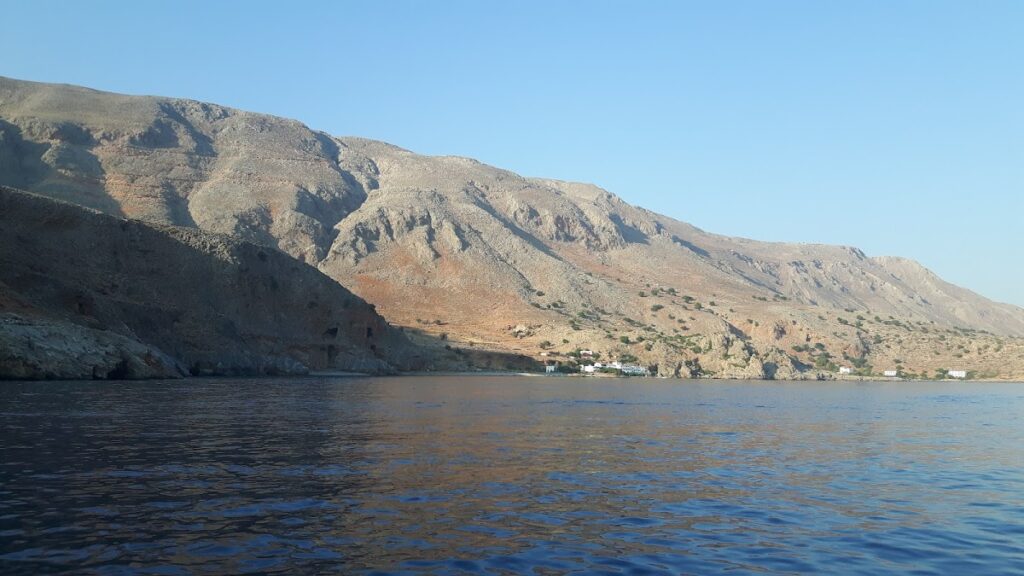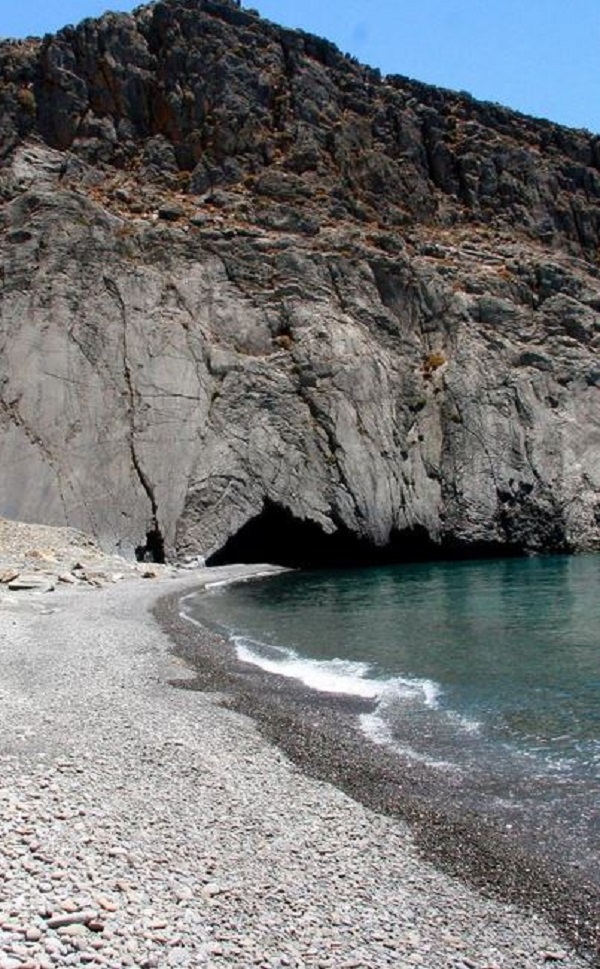Explore Beaches Accessible by Boat on Crete Island
Find a beach accessible by Boat near you
- Paralia Schisma Elountas
- Sand
- Normal
- Blue
Elounda’s Skisma Beach is a picturesque sandy enclave, perfect for families. Its cleanliness and organization make it especially welcoming.
Little ones delight in its flat sandy terrain and the playground, while older kids gravitate towards the available water sports. Occasional winds result in bigger waves, offering simple surfing opportunities.
With convenient facilities like restrooms and showers, coupled with an array of nearby taverns, it’s an ideal spot for families with children.

- Kimzou Sea Lounge Beach
- Fine Pebbles, White Sand
- Normal
- Blue, Deep blue
The charming Kimzu Sea Lounge isn’t just a fantastic bar, but also hosts an enchanting beach with shimmering white pebbles and sand, lapped by crystal-clear waters. The beach is located just 1 km away from Lake Voulismeni in Agios Nikolaos.
The beach offers full amenities, including an ample supply of sunbeds and umbrellas. Unique to this locale, visitors get to recline on lush, cool grass rather than hot sand, a delightful departure from typical beach experiences.
Despite its small size, the beach doesn’t usually feel crowded, offering ample space for all visitors. The water is shallow and inviting, making it particularly popular with families with young children. Strategically placed anti-wave blocks, about 120 meters off the coast, ensure the beach remains free of large waves, adding to its serene atmosphere.
Adjacent to the bar, a park provides additional recreation options, featuring a large children’s playground and a basketball court. It’s an idyllic spot for spending an entire day, from sipping on a rich Greek coffee in the morning, enjoying a delicious lunch and dinner, to toasting the day away with craft cocktails in the evening. The Kimzu Sea Lounge truly offers a comprehensive beach-bar experience.
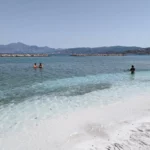
- Agii Pantes Beach
- Sand
- Normal
- Blue, Turquoise
Agii Pantes island is home to a quaint sandy beach situated just across the port of Agios Nikolaos. The beach, as well as the whole island, is accessible only by boat or via kayak or SUP departing from Ammoudi beach. It stands adjacent to the little islet Mikronisi, both acting as natural barriers safeguarding Agios Nikolaos. Moreover, the island serves as a habitat for several hybrid species of the endangered Cretan ibex.
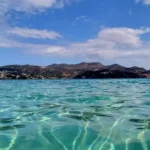
- Aspes beach
- Pebbles
- Deep
- Deep blue
The stunning Aspes beach, with its dark sand, is nestled approximately 58km south of Heraklion, in one of the most remote and hard-to-reach areas of the Asteroussia Mountains. This beach lies 4km to the east of the Tris Ekklisies settlement. Aspes is known for its almost vertical cliffs surrounding it, adorned with spectacular caves that appear as if carved by hand due to their orthogonal sides. The vibrant turquoise hues of the sea make it one of the most picturesque beaches in Crete, and perhaps the most beautiful in the Heraklion region. The beach offers fantastic opportunities for swimming and fishing.
Reaching the beach by foot is not possible, so it’s only accessible by boat. The closest harbours are in Treis Ekklisies or Tsoutsouras. The beach, due to its secluded location, provides a tranquil atmosphere, waiting to greet the fortunate boat owners. Boats are typically moored high on the beach’s rocks, their ropes creating an interesting grid-like pattern. If you visit Aspes, it’s recommended to bring a spoon to collect salt from the natural salt pans formed on the rocks at the beach’s edge. Additionally, don’t miss the towering rocks at the beach’s western end, reminiscent of scattered Obelix’s menhirs!
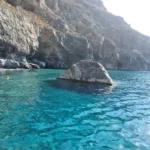
- Red beach
- Sand
- Normal
- Blue, Green
The Kokkini Ammos, or Red Beach, can be found 68km southwest of Heraklion and a short 800m from the popular resort of Matala. You can reach this hidden gem by following a clearly marked trail from Matala, which takes you over Kastri hill. While the trail includes some initial rock climbing and a steep descent at the end, it’s quite feasible. After a 15-25 minute walk from Matala, passing through a shepherd’s gate along the way, the breathtaking Red Beach comes into view. It’s an ideal spot for enjoying panoramic views and beautiful sunsets. Alternatively, you can also reach the beach by boat from Matala Harbour for a small fee of around 5 euros.
The beach is most noted for its red sand, a result of the area’s unique geology, which forms a stunning contrast against the bright blue-green sea. However, it’s important to note that it’s not shielded from the typical western winds in the region. The beach has minimal facilities, with a simple stone-wall coffee shop that opens occasionally offering food and drinks, and some umbrellas. It’s recommended to bring your own mats and umbrellas as the only natural shade is provided by a few tamarisk trees near the canteen.
In the 1960s and 70s, Red Beach was a popular spot among hippies, and its legacy continues with enthusiasts still visiting the beach regularly. Especially the northern part of the beach has gained a reputation as a nudist-friendly area and has gained international recognition for this. The beach and its surrounding area are protected by the Natura 2000 program due to its ecological importance.
The northern end of the beach features a long rocky limestone formation, similar to the limestone found in Matala. These rocks are decorated with carvings of Minoan and Egyptian sea figures, created by Gerard, a Belgian fan of Matala. These carvings have become a key part of the beach’s appeal. Between Matala and the Red Beach, there’s a large rock known as Theosini that offers stunning views of Messara Bay. This rock has been eroded by the sea, creating a marine cave known as Kouroupi, which can only be accessed by boat. The cave is a haven for endangered Mediterranean seals and various species of wild pigeons.
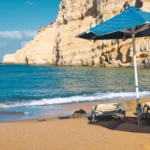
- Gramvousa Islet
- Rocks in places, White Sand
- Normal
- Turquoise
The island of Imeri Gramvousa is located 20km northwest of Kissamos, opposite the imposing Cape of Gramvousa and 2 miles northwest of the famous lagoon of Balos.
Its historical significance is captured by the majestic Venetian fortress that remains standing 137m above the beach. This fortress is not just a relic of the past but also an icon of pirate legends, which suggests a buried treasure somewhere on the island. An old shipwreck, long deserted near the beach, has become an integral element of Gramvousa’s unique panorama.
Two sizable bays on the island’s southern flank cradle the iconic shipwreck between them. The western bay, situated below the castle, is a popular destination for hundreds of daily visitors who arrive via excursion boats from Kissamos, a journey that takes an hour. These boats make a stop at Gramvousa before heading onward to the stunning Balos Beach.
Visitors have the chance to explore the castle and shipwreck, as well as indulge in a refreshing swim in the crystal-clear waters of the western cove, adjacent to the Holy Apostles Church. The beach, known for its mesmerising turquoise hue, features a mix of white sand and occasional rocky spots. Tamarisk trees near the beach provide a natural shade, while the area’s seabed is a snorkeler’s delight. Excursion boats provide food and water from onboard bars. Due to the area’s protection under the Natura 2000 program, no additional facilities are available, and overnight stays are prohibited.
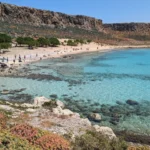
- Glika Nera beach
- Pebbles
- Deep
- Deep blue
Glyka Nera, translated as “sweet water” ranks as one of Crete’s most picturesque beaches, adorned with captivating deep blue waters and charming pebbles. In 2003, it earned a place amongst the top 20 European beaches by the London Times. Positioned 43km west of Chora Sfakion and 75km south of Chania, its unique name stems from the freshwater springs that bubble up amongst its pebbles.
Typically, Glyka Nera is most readily accessible via boat. However, for thrill-seekers, two hiking paths offer an alternate route: a 30-minute journey from the closest parking spot near Iligas beach, and an hour-long trek from Loutro. Despite the trails bordering steep edges, safety is ensured by regular maintenance from local authorities, given the paths are part of the renowned E4 European footpath.
A quaint tavern perched on a rock offers food, refreshing drinks, and loungers. You need not carry water as the spring water is drinkable. Interestingly, even in the peak of summer, the sea remains refreshingly cool due to these springs. Tamarisk trees generously provide shade along the beach. If given the chance, a visit to Glyka Nera is a must.
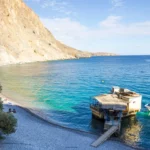
- Agiofarago beach
- Fine Pebbles
- Deep
- Deep blue
Agiofarago Beach, is a picturesque beach situated about 80km south of Heraklion city. To get there, you can opt for a 25-50 minute scenic trek through the Agiofarago Gorge or a boat ride from Matala, Agia Galini, Kokkinos Pirgos, or Kali Limenes. If you decide to trek through the gorge, you’ll enjoy a beautiful journey surrounded by towering walls. On your way, you will pass large caves inhabited by hermits from the nearby Odigitria Monastery and the charming St. Anthony’s chapel with its small brackish water well.
The end of the gorge route will bring you to the stunning Agiofarago Beach, where clear blue waters and fine pebbles are framed by towering cliffs. A unique rock formation to the west creates an enchanting swimming spot. However, it’s worth noting that due to the area’s religious significance in Crete, naturism is discouraged.
For those seeking an adventure in the afternoon, sturdy footwear is recommended to climb the eastern cliffs for an awe-inspiring view. A short walk to the southeast will reveal Vourvoulitis, a hidden saltwater lake surrounded by steep cliffs, linked to the sea via an underwater passage. Be careful, as the descent to the lake can be perilous.
To reach Agiofarago Beach from Heraklion, drive towards Sivas village and then to the Odigitria Monastery. From Odigitria, follow the dirt road leading to St. Anthony’s Church. After about 4km, turn right at the Agiofarago sign and continue until you reach a small plateau that serves as a parking area. However, avoid parking under trees to prevent goats from damaging your car while they’re trying to eat the tree leaves. A 30-minute walk through the gorge will then lead you to the stunning beach. Along the way, you’ll pass St. Anthony’s small church and Goumenospilios cave. For those arriving by boat, the rocky islet of Papadoplaka, located opposite Agiofarago and known for its small sea salt ponds harvested by locals, is worth a visit.
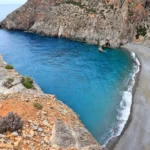
- Balos Beach and Lagoon
- White Sand
- Shallow
- Turquoise
The famous Balos beach is a well-known lagoon found approximately 56km northwest of Chania and 17km northwest of Kissamos, situated between Cape Gramvousa and Cape Tigani below the range of Platiskinos. It is highly photographed and a popular subject for tourist guides in Greece. It was also visited by Prince Charles and Princess Diana on their private yacht many years ago.
Balos is renowned for its striking turquoise waters, picturesque natural scenery, and stunning exotic beauty. During summer, thousands of visitors arrive mostly by ferry from Kissamos port. However, it can be overcrowded, especially in July and August, so it is advisable to visit in the morning before the boats arrive, to enjoy a few hours of isolation in this breathtaking paradise.
The lagoon’s white-pink sandy beaches feature vivid blue and turquoise waters, which are very shallow and warm, ideal for young children. The sand has a lovely pinkish hue in many areas due to millions of crushed shells. The water beyond the lagoon’s rocky boundaries is deeper and colder, perfect for snorkelling. The wider area, including the lagoon, has rare flora and fauna species and is protected under the Natura 2000 program. Eleonora falcons, shags, and cormorants nest in the caves of the area, while the monk seal and the loggerhead sea turtle (Caretta caretta), which are protected species, also find refuge there.
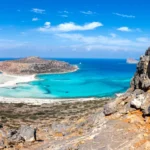
- Domata beach
- Fine Pebbles, Pebbles
- Deep
- Deep blue
The picturesque Domata beach, positioned 7km east of Sougia and 58km south of Chania city, resides at Tseses. This beach marks the end of the Klados gorge, a wild and rugged landscape. Its unique natural beauty is a result of the erosive power of water. The name Domata, translating to “roofs”, is derived from the layered structure of the surrounding conglomerate rocks, reminiscent of enormous walls. The beach owes its creation to the large amounts of pebbles and dirt deposited by the gorge, and the continuous oscillation of the sea and air.
The beach is striking, with its fine pebbles and transparent blue waters. By digging in the sand, you can discover fresh water from subterranean springs. As anticipated, the area is devoid of roads and infrastructure. However, the abundant pine trees near the beach provide natural shade and ideal camping spots. The southernmost section of the beach, separated from the main beach of Domata by rocks, is known as Kolotrividis, named after the adjacent cape.
You can reach Domata via the E4 European trail, which heads east and guides you to Agia Roumeli (a 3 -4 hour walk). Be cautious though, as the trail ascends to an altitude of 700m, with some sections being steep and potentially hazardous.
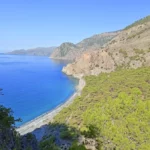
- Kaminaki beach
- Pebbles
- Normal
- Blue
Kaminaki Beach, a secluded pebbly beach ideal for fishing, is situated 58km south of Heraklion, on the southeastern fringes of the Asterousia Mountains. The rugged mountains surrounding the beach create a quintessentially Cretan landscape, featuring hard-to-reach gorges, bare rocks, steep cliffs, and isolated beaches mostly reachable by boat. The beach lies at the end of the wild Perivoliano Gorge, also known as Gerontzou.
Access to Kaminaki Beach is primarily via sea, given the difficulty in descending the gorge and the beach’s distance from the nearest road. The closest harbour can be found 3km west in Treis Ekklisies. A smaller beach located 400m west in the Agio Pnevma area is not as aesthetically appealing as Kaminaki.
On the opposite side, a striking beach with turquoise waters and a unique Δ-shaped sea cave can be found 700m east of Kaminaki. The beach is nestled in the embrace of Alykevra Bay, at the Sfakidia location, and is well-shielded by Cape Alykapounda. Heading west beyond Alykapounda Cape, you’ll find Alykevra, where a small rocky bay houses a freshwater spring. This spring was historically used by local shepherds to quench their flocks’ thirst. The area of Alykevra features a single beach situated at the mouth of a narrow canyon at the Prikovlyhada location. Despite its small size (1.5m in width), the pebble beach of Prikovlyhada is exceptional, with the canyon walls providing sunshade and nearby caves adding to its charm.
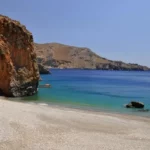
- Golden Beach Belegrina
- Sand, White Sand
- Normal, Shallow
- Blue, Turquoise
Crete is home to numerous stunning beaches, and the Golden Beach on Chrissi Island is considered one of the finest in all of Europe. However, a significant update has recently been implemented by the local government: they have suspended all boat access to the island.
Here’s what this implies:
- Disembarking from all types of vessels is now prohibited, meaning no boats are allowed to dock at Chrissi Island.
- While visitors are permitted to swim from their boat to the beach, they are prohibited from venturing into the island’s interior. This is an effort to protect the habitat of the island’s sea cedars.
- Essentially, boats will drop you off 10-20 metres from the shore, from where you’ll need to swim to reach this paradisiacal beach.
- The island no longer features sun umbrellas or other amenities.
These changes have been put into effect to preserve the land and marine environments of Chrissi Island.
Typically, throngs of visitors would arrive daily by boat from Ierapetra to enjoy the famous Belerinina or Golden Beach on Chrissi Island. The stunning tableau of vivid blue waters, white sands tinged pink from countless crushed shells, and junipers with expansive roots holding the sand in place is an irresistible allure for anyone.
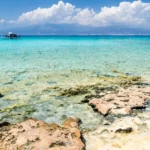
- Loutro
- Fine Pebbles, Pebbles
- Deep
- Deep blue, Green
Located roughly 71 km south of Chania city on Crete Island, Loutro is a quaint seaside village at the edge of Cape Mouri. This charming village is steeped in history, once being the site of the ancient city of Phoenix and the port of ancient Anopolis. It later served as a winter port for Chora Sfakion, its naturally formed harbour providing safe anchorage for ships even amidst harsh weather conditions.
Loutro makes for an excellent base for exploring the neighbouring beaches, accessible by taxi boat, canoe, or on foot. A small ferry can whisk you away to the stunning Glyka Nera beach to the village’s east. Alternatively, you can opt for a canoe ride or a hike along the E4 trail to the secluded pebbly beaches of Timios Stavros and Pervolaki, with your journey continuing to Glyka Nera. If you prefer to stay within Loutro, the village’s own beach and the extended Keramos beach to the east offer a serene retreat, especially during strong southern winds. These well-maintained pebbly beaches boast calm, crystal-clear waters in shades of deep blue and green. Nearby beaches of Likos, Finikas, and Marmara are also within easy reach by boat or on foot.
Loutro is a haven for those seeking a unique experience away from the bustle of mass tourism. This picturesque fishing village in southwest Crete is devoid of large hotels and swimming pools, crowded streets, restaurants, and beaches, and even cars! The only means of access is by boat or a 1.5-2 hour trek from Chora Sfakion. Daily ferry services operate to and from Chora Sfakion, Sougia, Gavdos island, Paleochora, and Agia Roumeli.
Things to do in Loutro
While in Loutro, you can revel in nature’s beauty by exploring the scenic mountain landscape, valleys, and gorges. Start with a visit to the Koules fort situated above Loutro, then head to the small port of Finikas. The village brims with historic sites, including the Old School, which served as the Chancellor of Sfakia’s seat in 1821, and the ancient Church of Panagia nestled next to it. Marvel at the tall Cretan date palm trees and the ruins of the Castella fort, part of the ancient town Phoenix, and the temple of Apollo just south of the village.
For the more adventurous, a climb to the idyllic village and plateau of Anopolis awaits. This entails a two-hour ascent on a 2000-year-old mule track, culminating in a selection of inviting taverns at the top. You can also explore the Aradena gorge or snorkel in the local waters, home to frequent sea turtle visitors.
Loutro, which translates to “bath” in Greek, was named after the baths discovered in the area, their waters once directed towards nearby Anopolis.
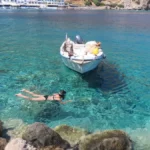
- Martsalo beach
- Pebbles
- Normal
- Deep blue
Martsalo, a secluded beach located in the western Asterousia Range, is just a few kilometres from Cape Lithino, the “horn” of Messara Plain, and 80km southwest of Heraklion. To reach this isolated spot, follow the dirt road from Odigitria Monastery to Lithino Cape, bearing right after the monastery. After travelling some distance, a sign indicating Martsalo will appear. Following this rough track will lead you to the entrance of Martsalo Gorge.
Parking your car at the gorge’s entrance, continue on foot for roughly 2km to the south. The hike through the gorge is not particularly challenging. The gorge, along with others in the area (like Agiofarago), has served as a hermitage for the Odigitria monastery, giving it significant religious importance. Remnants of the cells where monks once lived can still be observed in the gorge.
At the start of your journey, you’ll discover the beautiful church of Panagia Martsaliani, dedicated to the Annunciation. This church, constructed within a cave, served as a catacomb during the Christian persecutions. Centuries later, it was rediscovered by a shepherd. An icon of the Annunciation uncovered at that time is now preserved in the Odigitria Monastery. On August 15, when the Church celebrates, numerous visitors travel from the Mesara Plain to Martsalo.
As you continue down the gorge, you’ll pass between the indigenous Phoenix Theophrasti palm trees. Martsalo is home to one of the largest colonies of this species in Crete, and the largest in the Heraklion prefecture. In the gorge’s center, a stone container collects water from a nearby spring, and around it, the hermits cultivate their necessities.
A 15-20 minute walk through the palm trees will lead you to the beach at the mouth of Martsalo. This isolated beach with its large pebbles and calm waters (Martsalo translates to Good Harbor in Latin) is an ideal spot for solitude. A simple pier serves boats coming from Kali Limenes or Matala, and surrounding tamarisk trees provide natural shade. As a religious site, it’s important to respect the hermits and refrain from activities such as nudism.
Traces of a harbour hamlet from 1800-1600BC suggest the beach has served as a port since the Minoan period. The Apostle Paul also reportedly stopped at Martsalo to preach Christianity during his journey to Rome.
Cape Lithino, the southernmost point of Crete and the “corner” of Messara plain, is home to the dry Kefali peak. From here, cliffs plunge 391m into the sea. The view is breathtaking. To reach Kefali, follow the 13km long rough dirt road starting from Odigitria Monastery and heading west. On Kefali, you’ll find the ruins of a German military establishment from World War 2 and a small stone church dedicated to the Holy Cross.
Locals may tell you there are no beaches between Martsalo and Vathi, but this isn’t true. Below Kefali is a small cape called Platys Poros or Trahili, home to two bays with deep blue water and coarse pebbles, known as “Maragou Limani” or “Carpenter’s Harbor”. These southernmost beaches of Crete are only accessible by boat, and the surrounding coast is riddled with caves worth exploring.
Just west of Martsalo beach and 600m east of Poros is the small beach of Kounenos, accessible via a footpath near Martsalo. The surrounding landscape, filled with caves, cliffs, and unique rock formations, makes this an ideal spot for nature lovers. The beach features small pebbles and deep waters.

- Paximadia islets
- Fine Pebbles, Pebbles
- Deep
- Deep blue
The Paximadia Islands are twin uninhabited islets located off the Gulf of Messara, situated approximately 12km south of Agia Galini. At a distance, they appear as one due to their proximity, but on closer inspection, they are separated by a slender channel known as Bogazi. The locals often refer to these islands as the “Elephant” due to their resemblance to a reclining elephant when viewed from the Messara plane. The collective length of these islets is roughly 3km.
Contrary to common belief, the Paximadia Islands are not merely large barren rocks in the sea, but they also harbor beaches. The smaller of the two islands, the East Paximada, boasts four exquisite tiny beaches with clear waters and picturesque pebbles. These islands are accessible via tour boats departing from Kokkinos Pirgos and Agia Galini.
The West Paximadi, though lesser-known, possesses its own unique charm. It houses a beautiful beach named Varkaki. Starting from Varkaki, the western edge of the island stretches out to the cape of Sakouleva. Sakouleva is a striking spot, often wavy and adorned with a plethora of vibrant colors due to the presence of various rock types on Paximadia. The entire Big Paximadi is a wild landscape with steep cliffs culminating in a pyramid peak, with Sakouleva being the most awe-inspiring spot. A boat ride allows you to reach the edge of Sakouleva and its imposing rock formation. The view extends to the cave of Tzigounas, the largest among the numerous caves on Paximadia.
Historically, these minor islands were under the rule of Phaestos, a powerful and affluent city. They were then known as the Islets of Dionysoi, named after Dionysos, the god of wine. Local lore suggests that the goddess Artemis and nymph Vritomartis hunted here frequently. They were also called Litoai or Letoae, after the goddess Lito, mother of Apollo and Artemis, who was worshipped in Phaestos. One legend even implies that Lito gave birth to Apollo and Artemis on these islands. Presently, they are known as Paximadia, as their form resembles Paximadia, a traditional dry bread named after the Hellenistic cook, Paximus.

- Marmara Beach, Sfakia
- Pebbles
- Deep
- Deep blue, Turquoise
Dialiskari, also known as Marmara beach, is a stunning secluded pebble-filled bay situated near the end of the majestic Aradena Gorge, within the Sfakia region. It is situated 85km to the south of Chania city and 5km to the west of Loutro. This beach serves as a resting spot for the hikers of Aradena Gorge before they proceed towards Loutro.
Marmara, translating to “marbles”, gets its name from the soft colourful rocks and the sea caves that are the highlight of this location. The beach is a 60-minute walk from the nearest inhabited beach of Lykos and a 75-minute walk from Loutro. The absence of roads only allows for access by foot or boat. Near the beach, there’s a quaint tavern offering delicious food (be sure to reserve in advance!) and beach umbrellas.
During the summer months, there are daily boats available from Loutro. If you find yourself in the Loutro area, a visit to Marmara and a hike through the Aradena Gorge come highly recommended.
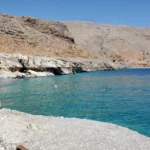
- Potamos beach - Chania
- Sand
- Shallow
- Blue, Green
Potamos beach, along with its neighbouring Pirgos beach, is situated on the northwest shore of Gavdos island, 7km northwest from the Karave port. The beach’s striking features include its lengthy stretch of reddish sand, shallow waters, impressive clay geological formations, and steep cliffs, all of which emerge from a small canyon. The beach earns its name, Potamos, from the Greek word for river.
This beach, enveloped in pines and junipers, is a popular spot for hiking enthusiasts. Visiting the river area offers a unique opportunity to examine the surrounding rock formations or indulge in a clay spa treatment.
The Lighthouse – Ambelos – Potamos Trail
The principal way to access Potamos beach is by a 1.5-2 hour hike from Ambelos. Before reaching Ambelos, it’s worth visiting the Gavdos lighthouse, situated at an altitude of 368m. The lighthouse, which now functions as a small museum and coffee shop, was constructed in 1880 and could be seen from 40 miles away (ranking it the 2nd longest distance globally). However, it was bombed in May 1942 and later reconstructed. A little further along, you’ll encounter the chapels and deserted houses of Ambelos, where the crumbling stone cottages evoke memories of Gavdos’ bygone era.
The path to Potamos from Ambelos traverses a dense pine forest and provides views of the Gavdopoula islet. The hike is fairly easy, making it suitable for beginner hikers. Alternatively, a dirt road leading to a spot about 500m east of the beach is available for those who prefer not to walk. Midway, you’ll come across the derelict settlement of Neveli.
Bo Cove
As you make your way down to Potamos, you’ll notice Bo’s rocky shore to your left. Bo is a tiny cove facing north with a rocky seabed. The locals claim its peculiar name originates from the sound “bo bo” made by the waves crashing against the rocks.
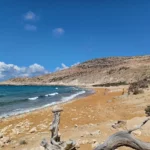
- Agios Georgios bay, Dia
- Sand
- Shallow
- Blue
Dia, an uninhabited island situated 12 miles off the coast of Heraklion city, serves as a popular summer excursion spot. Daily boat trips allow visitors to witness the island’s rugged landscape and take a dip in its crystal clear waters. The docking point for these boats is known as the port of Agios Georgios or Saint George.
Agios Georgios, the bay that greets visitors arriving from the west, houses a large pier for tourist boats. Another pier lies across, beneath the picturesque chapel of Analipsis or Ascension. This well-sheltered cove served as a major port for the ancient Minoans, a fact confirmed by Jacques Yves Cousteau’s explorations. An abandoned tavern, once operational, stands by the pier. To the west lies a small sandy beach with turquoise waters, untouched by the frequent northern winds.
If you venture westward towards the chapel of Analipsis, two more secluded sandy beaches can be found along the path. Further along the trail lies the scenic Church of the Ascension. On special occasions, numerous ships, including large ferries, sail from Heraklion to join the celebrations. The church, known for its stunning views, is neighboured by the remnants of an older chapel and Dia’s shelter. Visitors wishing to stay overnight in the shelter need to contact the Port Office of Heraklion for the key and necessary permissions.

- Galini beach
- Fine Pebbles
- Deep
- Deep blue
Situated 47km southeast of Agios Nikolaos and 13km east of Ierapetra, near Achlia beach, lies the quaint village of Galini. Nestled amidst a lush landscape dotted with pine trees, Galini is a small yet slightly developed village. The coastline surrounding the village is marked by numerous hidden coves and pebbly beaches, only accessible via a few well-concealed paths.
Among these is Galini beach, a serene spot nestled between Ahlia and Agia Fotia. Characterized by fine pebbles and clear calm waters, the beach’s seabed is rocky in certain spots. The beach remains concealed from the main road due to towering conglomerate rocks and isn’t easily accessible, making it a quiet and ideal spot for those seeking solitude. While the beach is not organized, the proximity of village hotels and taverns makes it convenient for visitors. A short path from Galini’s main road leads directly to the beach.
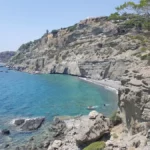
- Agia Roumeli beach
- Fine Pebbles, Pebbles
- Deep
- Deep blue
Situated 56km south of Chania city, Agia Roumeli is a quaint village nestled in the wide bay at the exit of Samaria Gorge. This serene village, set against the rugged and mountainous backdrop of Sfakia province, attracts thousands of visitors every day who descend through the gorge. The village can be reached either by trekking through the gorge or by taking a ferry from Chora Sfakia, Loutro, Paleochora, and Sougia. The village offers basic amenities like traditional taverns, accommodation facilities, cafes, a mini market, internet access, and a telephone.
From 13:00 to 16:00, the village and its beaches are bustling with visitors, but it regains its tranquillity after the departure of the ferries. An overnight stay in the village offers a unique opportunity to appreciate the beauty of this place, its warm-hearted inhabitants, delectable food, and breathtaking natural beauty.
The magnificent beaches of Agia Roumeli spread over a length of 3km or more. The area near the village is more crowded and organized, with Gialos beach in front of the taverns being the most developed and crowded. Other beaches include beautiful pebbly beaches at Zeromouri, Mashali, and beaches near the caves known as Spilies sto Marmaro or Caves in Marble.
The Samaria Gorge, the longest in Europe at 18km, is a prime attraction, drawing thousands of tourists in summer who trek the distance in about 6 hours. Some tourists visit Crete specifically to traverse the majestic gorge. If time is a constraint, you can start from Agia Roumeli and walk backwards.
Agia Roumeli is built on the ruins of the Roman settlement, Tara. The ruins of the Temple of Apollo (or Artemis) and the old church of Panagia (Virgin Mary) built in 1500 can be found west of the village. A ruined Turkish castle (Kule), offering spectacular views of the village, the Libyan Sea, and the islands of Gavdos and Gavdopoula, sits atop the hill above the village. Nearby, you can visit the beautiful church of St. Anthony nestled in a rocky cavity.
About 2km north of the village, within the gorge, lies the old village of Agia Roumeli, surrounded by greenery. Here, you can find ruins of old houses and some restored homes. The village, devastated by floods in 1954, was relocated to its current location in Agia Roumeli.
Agia Roumeli’s people and food are attractions in themselves. The locals are true Cretans, warm and welcoming, offering home-bred meat, cheese, vegetables, and honey in their restaurants. Despite the influx of tourism, Agia Roumeli has retained its authenticity and charm, offering visitors a chance to experience traditional Cretan hospitality, savor local delicacies, and enjoy the serenity of nature.
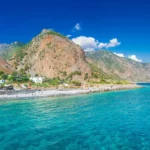
- Glykys Kolimbos beach
- Pebbles
- Normal
- Blue
The Glykys Kolymbos beach, also known as Glykos Kolymbos, is the most westerly beach in the Tris Ekklisies region of the Asterousia Mountains. It’s a remarkable location featuring striking geological formations in the water that appear as stripes when viewed from above. The beach’s name, which translates to sweet water beach, is derived from the freshwater springs that bubble up underwater.
What sets Glykys Kolymbos apart are the three incredible interconnected caves at its eastern end, resembling a series of rooms. The largest of these caves stands at a height of 20 meters, and the first one is likened to a swimming pool. A stunning stone bridge takes shape at the eastern end’s extremity.
Access to the beach is primarily by boat due to the challenging land approach. However, a steep ravine after the beach’s western end allows for a descent to the beach. This ravine sits beneath a small sheepfold, right where the dirt road that runs through the Tris Ekklisies carob wood terminates. Due to the poor state of this dirt road, access is typically on foot from the Ornios beach to the west, along the steep shores. Here, you can marvel at the cliffs featuring natural arches. A unique natural balcony, a rock shelter, forms above the termination point of the dirt road, offering a breathtaking view of the sea.
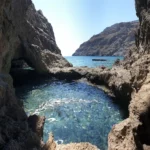
- Bogazi beach at Sises
- Pebbles
- Normal
- Green
Bogazi beach is nestled in a secluded area on the periphery of the Sisses community in the district of Mylopotamos, located in the Talea Range and east of the German outpost at Pyrgos peak. Its remote location makes it only accessible by boat, as the nearby dirt roads are extremely challenging to navigate. Hence, it remains largely undiscovered. A year-round flowing stream lined with plane trees concludes its course at Bogazi. The beach, facing east and flanked by stunning rock formations to the north, is one of the rare wave-free beaches on the northern coastline of Rethymnon.
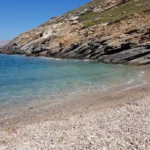
- Parasfougario beach
- Rocks in places, Sand
- Normal
- Green
Parasfougario Beach, situated in the Achlada district of Malevizi province, is approximately 22 km northwest of Heraklion on the island of Crete. Positioned on a steep incline between the well-known beaches of Lygaria and Agia Pelagia, the only access to it is by a 20-25 minute swim from either of these beaches.
A set of stairs from a nearby house lead directly down to this petite beach. Its backdrop of a slope blanketed in crithmum adds to its charm. The ocean floor features pebbles and coarse sand, and a small cave to the east further enhances the picturesque setting.
Unlike its neighbouring beaches, Parasfougario is exposed to the northern winds. As a result, it is advisable to avoid it during windy periods, as it tends to accumulate a significant amount of rubbish during these times.

- Gournia Fjord near Vathy beach
- Rocks in places, Sand
- Normal
- Blue
Gournia, a remote area situated on the outskirts of the Pigaidakia village in the Asterousia Mountains, lies between Vathi beach and the rugged location of Sideropetra. This is along the route that links Matala with Vathi. Reaching Gournia from the mainland demands a high level of fitness due to the strenuous and shadeless journey. However, the raw charm of the landscape makes up for the difficulty.
The region is marked by the soft white limestone that has been eroded by the sea, giving it a resemblance to a lunar landscape. In Gournia, there are five successive, narrow, and rocky bays formed at the outlets of deep streams, reminiscent of tiny fjords. Several small natural ponds, or troughs, which give the place its name, Gournia (meaning troughs), are also present.
In the largest and most dramatic fjord, a small, captivating beach is occasionally formed, depending on the eastward carrying portable materials by the winter rains. This unnoticed beach was photographed by Manolis Dretakis and Nektarios Savvakis in May 2020, providing a delightful surprise as it was previously considered just a rocky bay.
To reach Gournia, one has to endure a walk from Matala, which takes around two and a half hours, or from Vathi, taking one and a half hours, where a dirt road from the Monastery of Panagia Odigitria leads to the area.
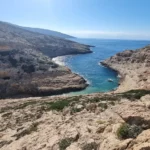
- Skotini beach at Ravdoucha
- Fine Pebbles, Pebbles
- Normal
- Blue
Skotini, a stunning beach, is nestled between Ravdoucha and Agios Vasilios at Cape Sideris, near Panagia Myrtidiotissa at Choni. It is found at the end of a narrow, steep gorge. The beach is reachable via a striking trail that begins at Saint Marina (Agia Marina) in Ravdoucha and extends to Nopigia. Approximately 20-25 minutes into the hike, after passing the rock above Ravdoucha beach, you divert from the path and descend towards the dilapidated iron ore transhipment facilities that were operational in the early 20th century. Historically, there existed a small settlement, Skotini, inhabited by mining workers.
Before arriving at the rugged coastline, you’ll discover a sizable cave that provides refuge for the local goats. After cautiously navigating through the mine and natural saltpans, you will reach Skotini beach, noted for its rocks and cavities, and also referred to as Metalio (mine). The beach features pebbles and crystal blue waters. However, it is significantly impacted by the west winds that carry litter across the Kissamos bay. The beach provides an idyllic relaxation spot during the south winds, when the waters are clear.
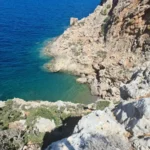
- Dragonada Beach
- Rocks in places, Sand
- Normal
- Blue
Dragonada Island, the most expansive amongst the Dionysades islands situated in the open waters of Sitia, hosts a small harbor. This quaint harbor, adjacent to the Saint Anthony temple and the island’s only residence, boasts a stunning beach. Although small, the beach is incredibly beautiful with its sandy shores and rocky sea bed.

- Mashali beach
- Fine Pebbles, Pebbles
- Deep
- Deep blue
Agia Roumeli, a quaint isolated village, lies 56km to the south of Chania city, situated in a broad bay at the mouth of the Samaria Gorge. It’s a popular spot for tourists who descend the gorge daily, basking in the sun on the main beach, Gialos, which stretches before the taverns. More adventurous travellers can explore the serene and picturesque beaches in the vicinity, with Mashali, the western part of Agia Roumeli bay, being one of them.
A secondary boat dock, associated with a solitary tavern that offers rooms, is present. Two stunning beaches with fine pebbles are adjacent to this dock. The tavern provides complimentary sunbeds, umbrellas, and canoes. Large rocks on these beaches offer shade and privacy, making it a haven for nudists. Care must be taken while traversing the main road from the tavern to the dock, due to occasional stonefalls caused by mountain goats. While these stonefalls are not highly dangerous, it’s safer to walk on the left side, away from the mountain walls.
Venturing further from Mashali by swimming or kayaking beyond the beach’s western edge, leads to three caves. These caves are fronted by small pebbled beaches, referred to as Spilies to Marmaro, or ‘Caves in Marble’.
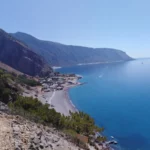
- Mikronissi beach at Faronissi
- Pebbles
- Normal
- Blue
On the southwestern tip of Mikronissi islet, where the Agii Pantes lighthouse stands across from the city of Agios Nikolaos, there is a tiny dock for boats. It’s here that you’ll find the island’s sole beach, tucked away in an ancient, carved bay. Access to this hidden gem is gained via a stone staircase.
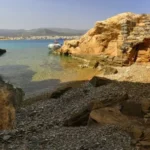
- Lykos beach
- Pebbles, Rocks in places
- Normal
- Blue
Likos is a coastal hamlet featuring a diminutive port, situated 900m west of Loutro and 83km south of Chania, on the outskirts of the virtually uninhabited village of Livaniana. Nearby to the east lies the somewhat larger community of Finikas (Phoenix), with a rocky hill serving as a border between them.
The beach at Lykos, in comparison to Finikas, is considerably rocky and houses a small dock for boat arrivals, although it is exposed to southern gusts. Despite not standing out as a beach, its serenity and abundant marine life make this secluded spot worth exploring. Traditional taverns, offering a limited number of rooms, provide a chance for visitors to escape their hectic daily routines.
The European pathway E4, connecting the Marmara beach at the exit of the Aradena Gorge with Loutro, traverses Lykos. The most frequent means of arriving, however, is by private or rented boat from Hora Sfakion or Loutro. Another option for those preferring to arrive by car is to drive from Chora Sfakion to Anopolis, then continue to the village of Livaniana. A dirt road from there leads to Likos and Finikas. The drive from Anopolis, taking approximately half an hour, is thoroughly enjoyable due to the stunning natural beauty and untamed landscape.
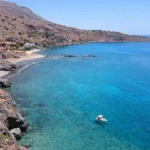
- Leprias beach
- Pebbles
- Deep
- Blue
Located in the Kalokambos region, approximately 73km south of the city of Heraklion, Leprias, also known as Lepries, is a quaint pebbly beach nestled amidst the rugged and awe-inspiring landscape of the Asterousia Range, southwest of Kofinas peak. The beach is accessible via a hiking trail that starts at Tripiti beach and leads to Agios Ioannis. Leprias beach is set against a steep dirt slope that erodes and crumbles, reminiscent of a leper’s skin, giving the beach its name, derived from the Greek word for leper.
The safest way to descend to the beach from the trail is from the bay’s western end. The eastern part of the beach boasts impressive caves that provide shade throughout the day. As you travel between Leprias and Tripiti, you will encounter other beautiful beaches in the Kalokambos area, characterized by their rocky bottoms and favored by local fishermen.
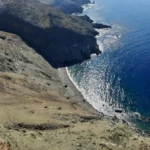
There are no results matching your search.
Reset